Uummannaq, Greenland 2013
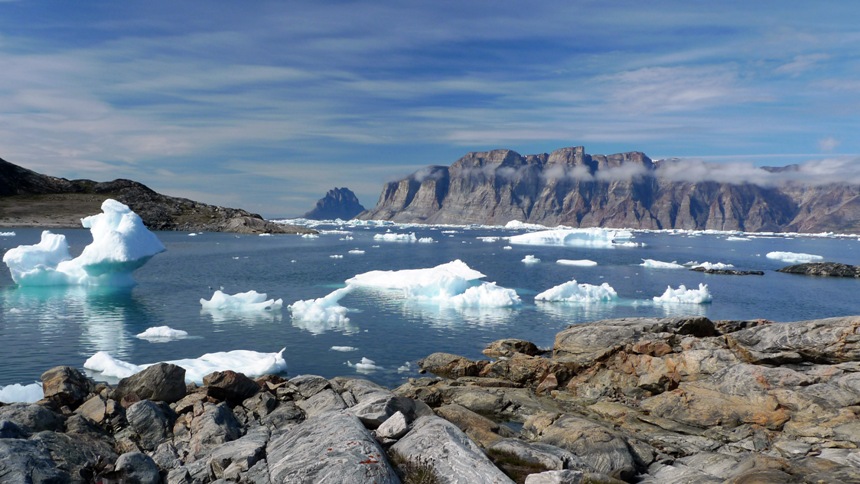
Uummannaq and Storøen from Ikerasak
Debbie writes:
I’m fuming! I’m crying! My head is exploding! How can two large 35 kg boxes vanish into thin air?? “There’s been an ‘exception’. We can’t confirm the location of your shipment. It has left customs in Denmark and is in transit. We need to put a tracer out and if we can’t locate it within eight working days, you’ll be sent a claim form,” explained a grim UPS customer service rep. I replied helplessly, “You mean it’s lost.” She said, “Possibly”.
Over the past two weeks ever since the kayaks (two folding Kl Feathercrafts in two boxes) went missing, my emotions seem to have vacillated from the deep dark canyons of despair to the towering peaks of joy. This state lasted a full two weeks right up to the day before we left on our flight to Reykjavik. A week before we left I got a cold and I even got palpitations thinking about it all. However, things can and do work out and now I’m in a state of pure joy as my husband e-mailed me at work, “Kayaks in Uummannaq Heliport,” just one day before our flight. A wonderful German lady at a large UPS depot phoned Uummanaq Heliport, after my husband’s prompting and providing her with the phone number, she confirmed that our boxes were, indeed at the heliport. She explained that it takes a few weeks for Greenland staff to acknowledge a package has been delivered because they send information by post which is why our shipment disappeared from the tracking list.
But now, even though it looks like we will have our kayaks after all, the gravity of what we were about to do weighed heavily upon me. We are going to kayak alone, in ice-filled fjords, with 8 – 10km open crossings, along high, steep cliffs with limited landing opportunities, and submit ourselves to fjord wind, katabatic wind, and all the grandeur, magnificence and cruelty that nature will bestow upon us.
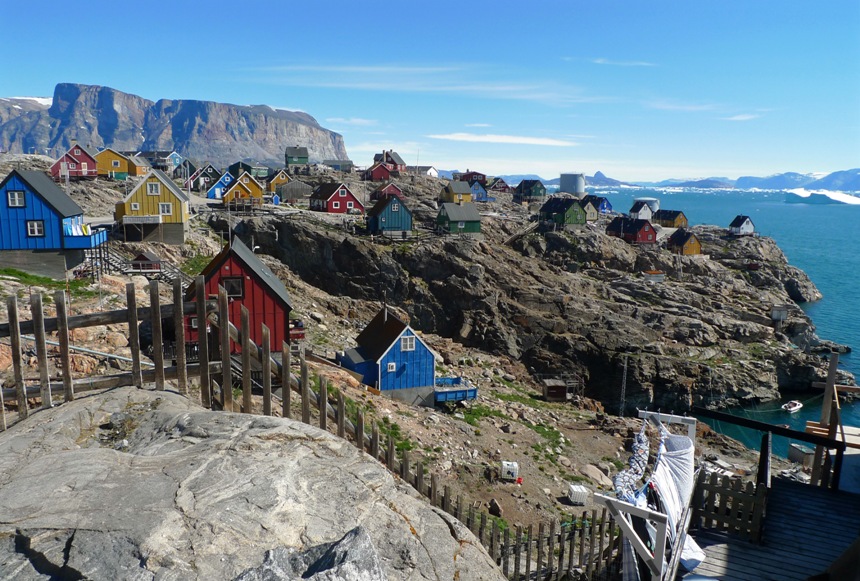
Storøen and Ikerasak from Uummannaq
15 June 2013: Reykjavik to Illulissat
There were only 18 passengers on the Dash 8 on our flight from Reykjavik to Illulissat. A nice blond Danish gent was waiting for us at the airport, helped put our heavy bags into is van and whisked us to Hotel Avanna, a red, wooden structure with modern IKEA decor. Our room was up three flights of stairs, but we were pleased and happy to be there.
The light in Ilulissat was better in the evening. Although it was overcast with the low clouds which seem even lower in the sky above the Arctic Circle, the subtle glow of the sun lit all the icebergs in the distance we missed when we arrived earlier that afternoon.
There are 2300 sled dogs and they live in the green belt or rock belt behind the colourful houses in dog shanty towns. At first we didn’t see them lying on the rocks, but once we spotted them, it was overwhelming. They are chained and shelter in small square plywood dog houses and nearby one can spot the odd dog sled. They didn’t seem as vicious as I thought and none of them growled at us as we walked by on our way to the ice fjord. But it was a stunning cultural sight to see so many scattered about the bedrock and dusty, scrubby landscape.
The harbour came alive in the evening and was the beating heart of the town as dozens of Greenlanders walked down the steep road and staircases to their skiffs and zoomed out to sea to fish or enjoy the icebergs.
I feel from what I see and have been reading that Greenlanders are keen to be seen as modern, like Europeans. They wear bright orange or blue Haglofs puffa jackets, jog in Nike Lunar Glides and the children wear brightly coloured baseball caps back to front and skateboard and text while walking down the street. They are keen, though not to lose “the old ways” of hunting seal by dogsled and fishing, so it’s a curious blend of old and new.
It takes a while, maybe two to three days to become “in sync” with your new environment and becoming totally absorbed in the surroundings, especially when one starts camping which is what I love most about travel. After a while, you feel like you’ve lived there a long time and even though it’s all new, the curious paradox is that the surroundings somehow begin to feel familiar. The logistics of the first few days are overwhelming and sometimes I don’t think it’s possible to “pull it off”, but once you tune in, sleep, look at clouds, feel the wind, listen to the birds, hear the icebergs rumble like thunder, it makes it all worthwhile and you feel very fortunate you have this opportunity.
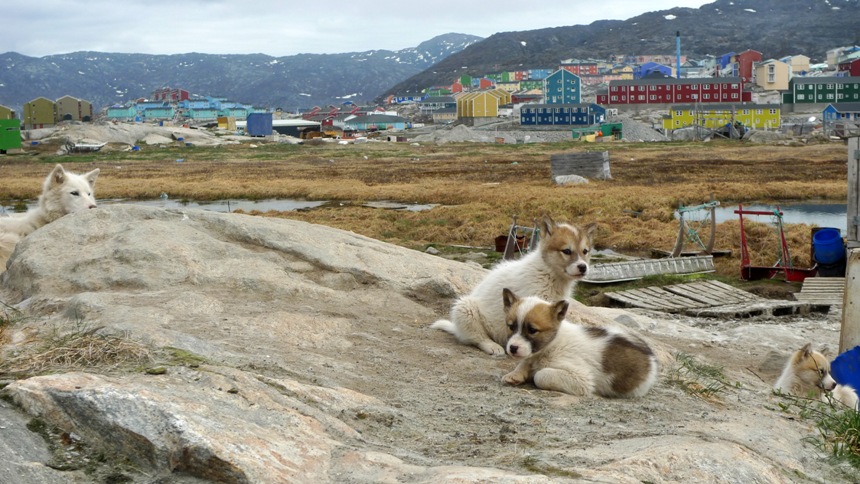
Sled Pups, Ilulissat
16 June 2013: Kangia Ice Fjord
What a difference bright sunshine makes! The air is crystal clear and cool and dry. We had a magnificent walk which started from “dog shanty town” near the heliport to Holmens Bakke and Nakkaavik where the elderly or infirm jumped to their deaths in the old days if they felt they could no longer contribute by gathering food or hunting. What magnificent views of the glittering ice fjord we had the entire walk. The immenseness of size of Kangia Ice Fjord (a World Heritage Site) and panoramic view of the sparkling icebergs made for a stunning and enjoyable walk. During lunch we were mesmerized as we stared at the different shapes of small irregular brash which rearranged themselves into different patterns like a blue and white kaleidoscope. It was one of those walks that although not strenuous, it took a good 7-8 hours but you didn’t realize you were tired until finished because of the total absorption of the moment.
One could imagine ancient peoples living here, cooking, and skinning their seals and whales, and children playing in full view of this spectacular, glittering ice fjord. We rounded a headland and ended up back on the west side of Ilulissat with views of a funky, multi-coloured smokestack of the power station, set against a backdrop of the multi-coloured square wooden houses of Ilulissat. I’ve never seen so many different coloured houses. There were houses of teal, purple, ochre, periwinkle, orange, yellow, green, pink, red, and blue, together with children playing outside, made for modern, vibrant town life on a Sunday afternoon.
We stopped at the Hotel Ice fjord for a shockingly expensive pint and a half (£16) of blueberry ale and Eric the Red ale enjoyed on a balcony overlooking the ice fjord. We tried to book two nights here last September for this June trip, but there were no vacancies. It was upmarket and modern with clean Scandinavian decor. Our Hotel Avanna is also clean and modern but a bit out of town. The great advantage of it is it’s mini-kitchen with fridge as most meals for two here would start at about £30 – £40.
Tomorrow we leave for Uummannaq with no accommodation booked and nowhere to stay except for a possible camping area near the reservoir. We booked our flights before accommodation because Hotel Uummannaq and the associated Youth Hostel had been in operation for the past 20 years, so we didn’t think there would be a problem. But after several phone calls and e-mails, we got no reply and it wasn’t until April that we suspected something was wrong. I phoned the sister Hotel Cab Inn in Ilulissat and spoke to a nice woman who informed me that the hotel was now closed and was being made into a school. It was like someone punched me in the stomach. Hotel Uummannaq ran all the boat trips, ran the Youth Hostel and now there seems to be no tourist infrastructure for the independent traveller. I did, however, find a website called “Ice & Sea View Homes”, and even though I had a conversation with a local gent named Fritz who reassured me with “I will find you a house – send me an e-mail”, in broken English, we heard no reply to our two subsequent e-mails. If he doesn’t meet us at the heliport, we’ll camp and start kayaking the next day, if our boats have arrived, that is!
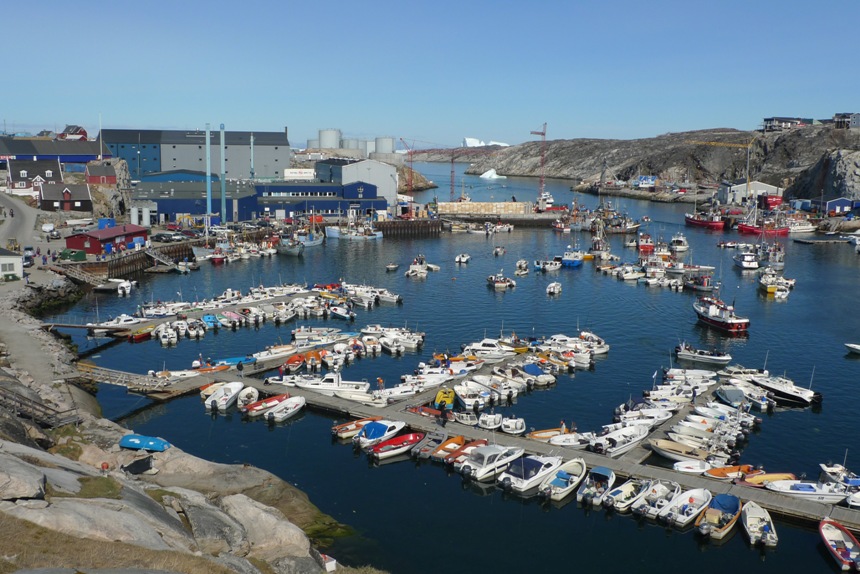
Ilulissat Harbour
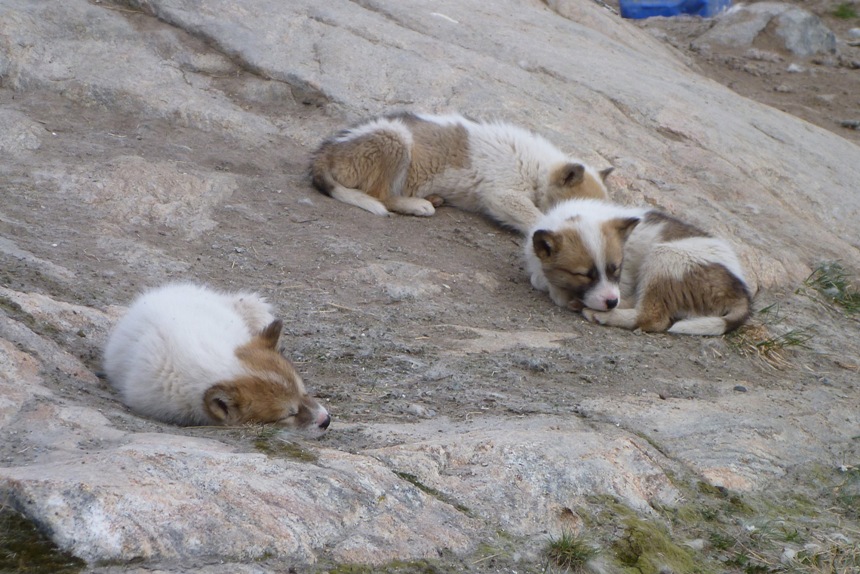
Sled Pups, llulissat
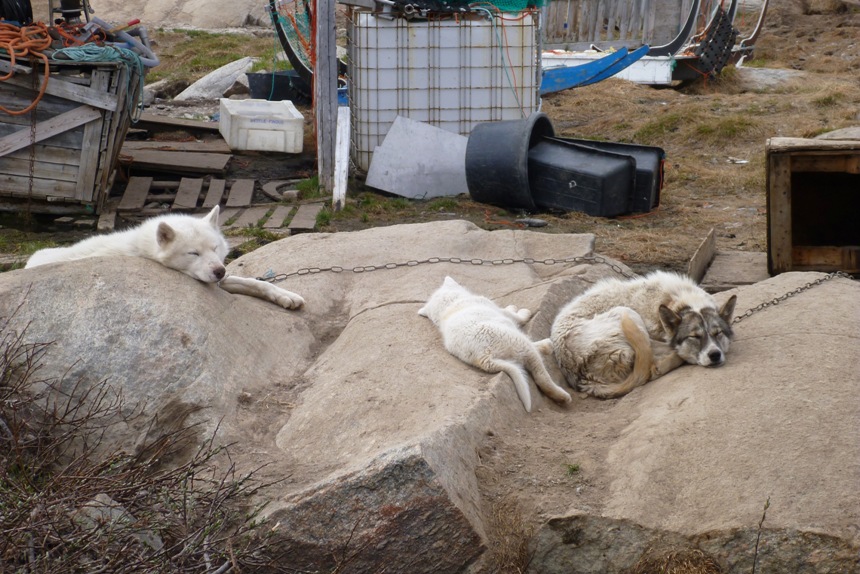
Dreaming of Winter, Ilulissat
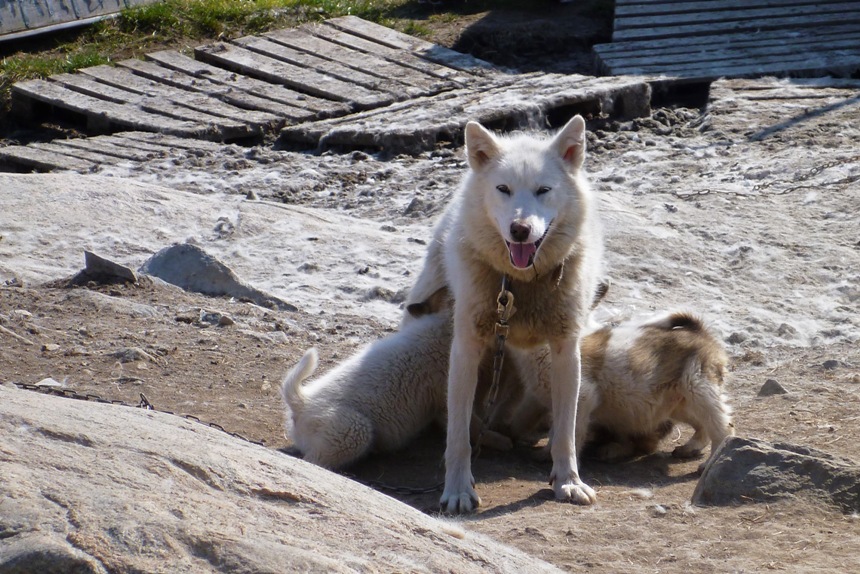
Thirsty Work, Illulissat
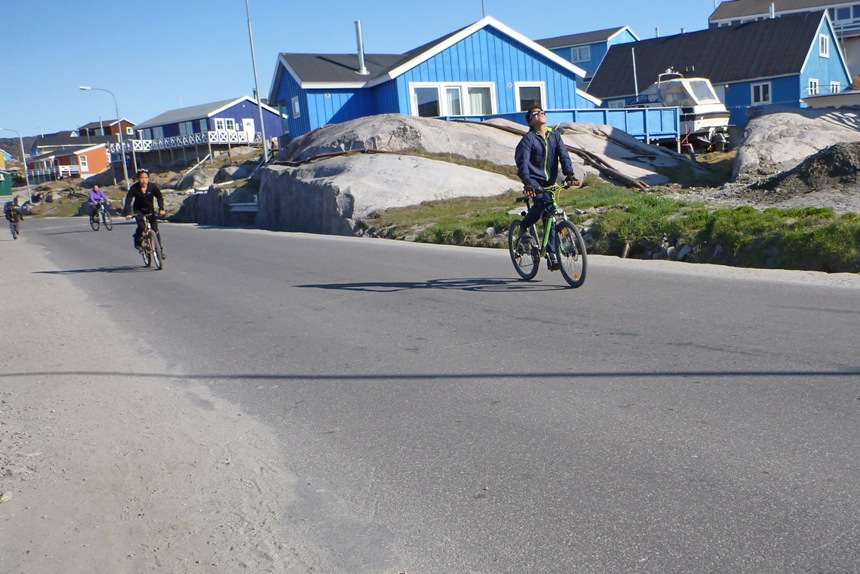
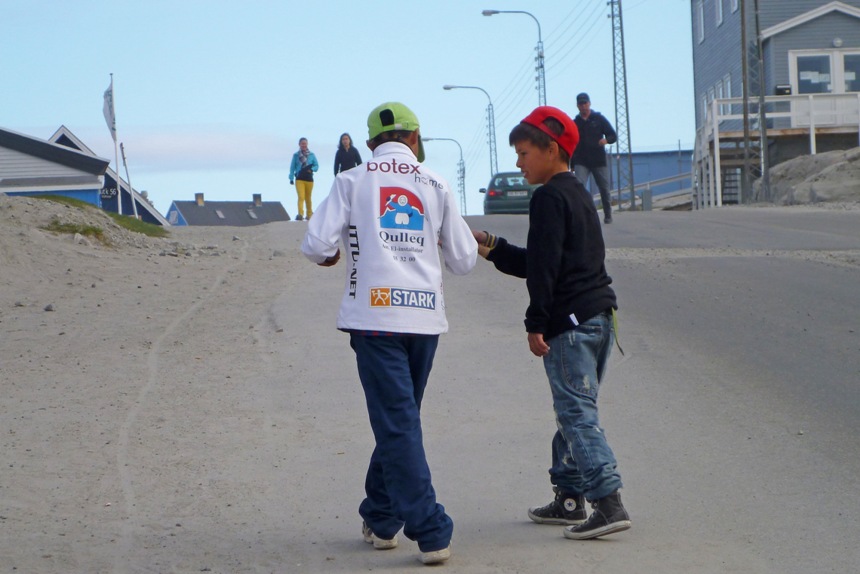

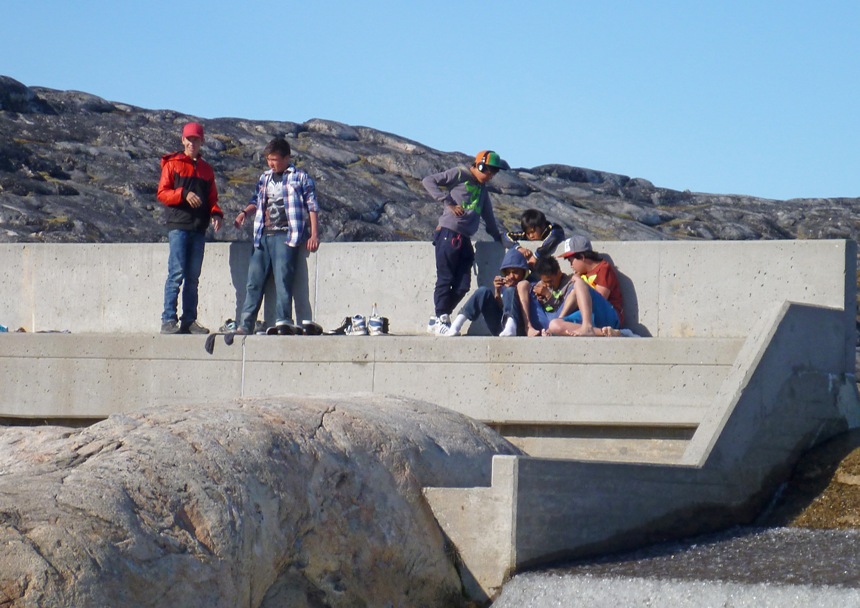
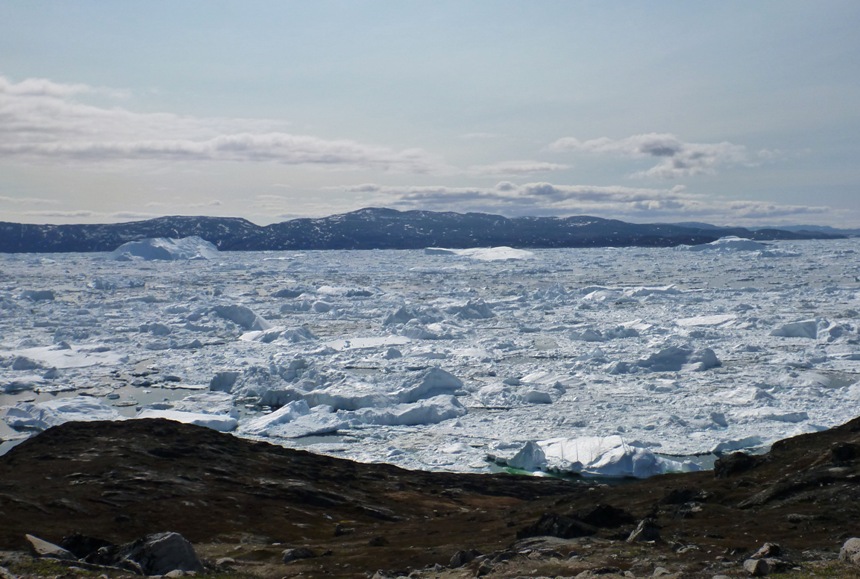
Kangia Ice Fjord, Ilulissat
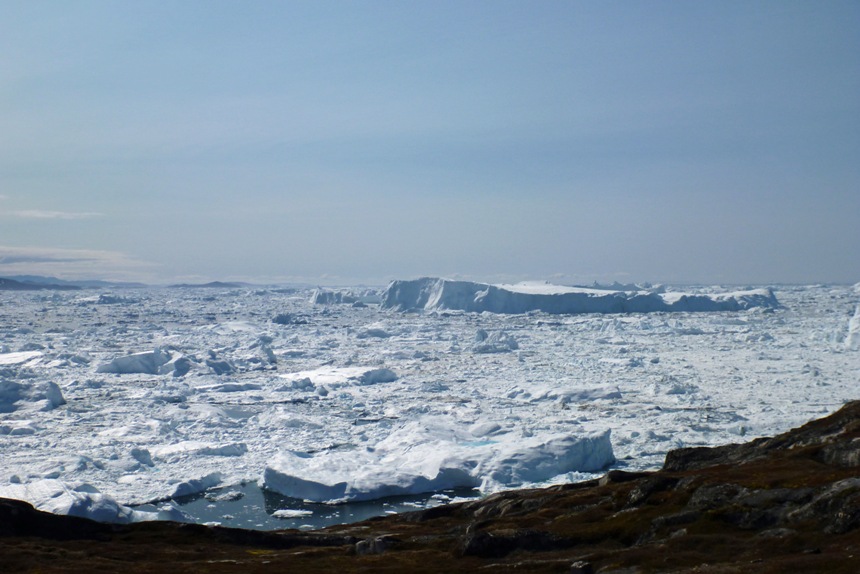
Kangia Ice Fjord, Ilulissat
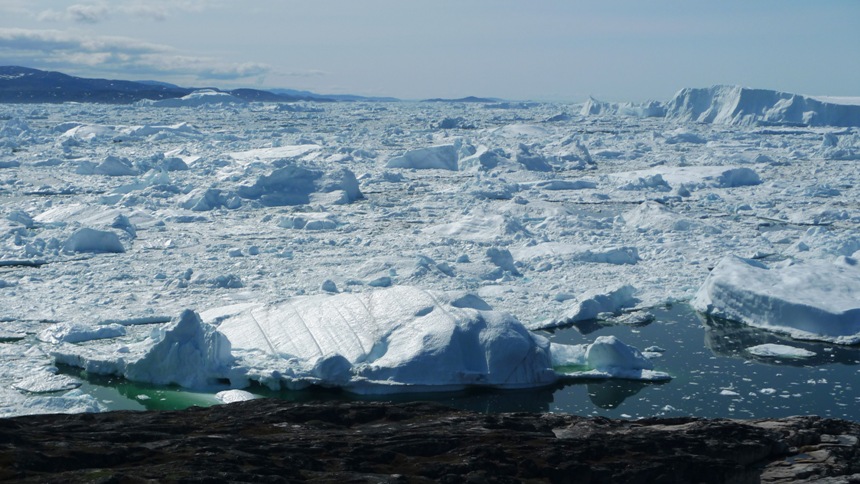
Kangia Ice Fjord, Ilulissat
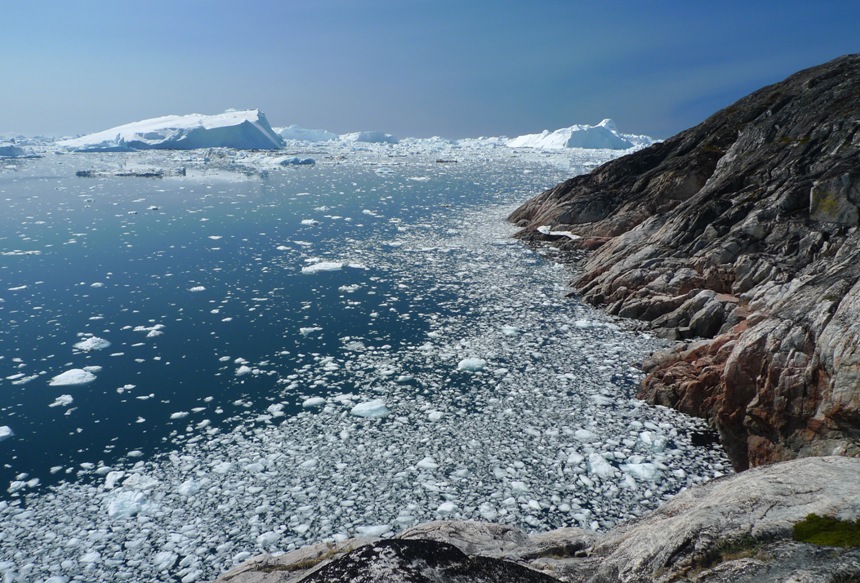
Nakkaavik, Kangia Ice Fjord
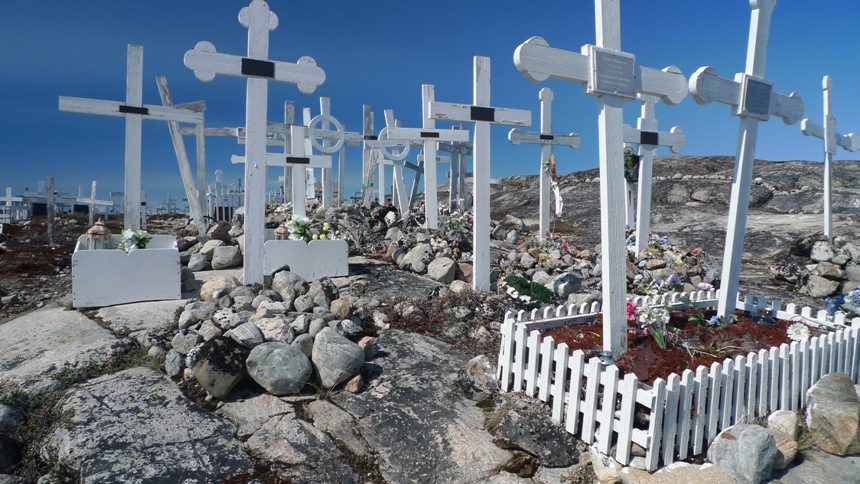
Cemetery, Pitoqqeq , llulissat
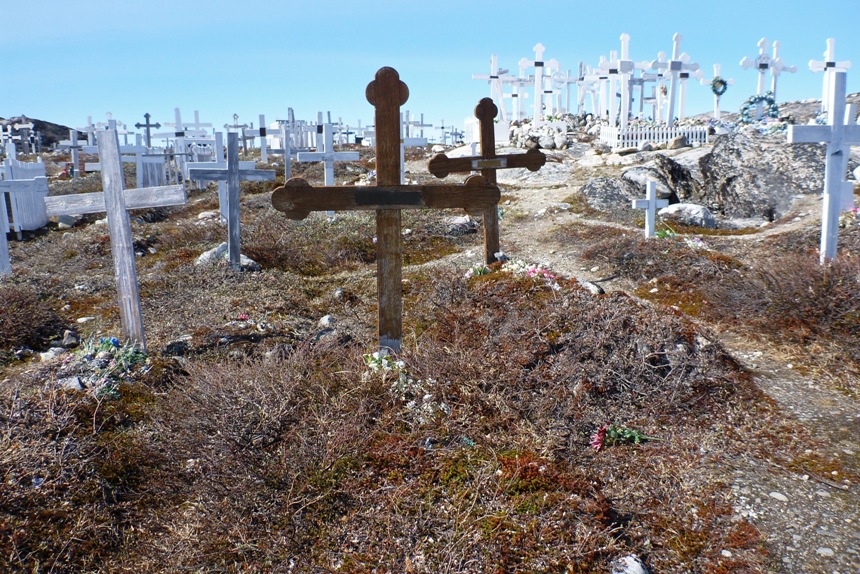
Cemetery, Pitoqqeq , llulissat
17 June 2013: Ilulissat to Uummannaq
Today is the big day! We go to Uummannaq to discover our fate. Do we have a small house waiting or do we wild camp? It just doesn’t matter to me in my newly found excitement and I must have nomadic ancestors which contribute to my instinctive desire to roam and see different places. I love travel and moving on and almost relish the challenge of searching for a new place to stay and camp. I’m reticent, though, about staying in other people’s homes, as I feel it’s an imposition for them.
Before our flight, we visited Knud Rasmussen, the Arctic explorer’s house, and this museum is a real treasure. There was a display of a dog sled complete with stuffed dogs, a traditional dress costumes display, old tools of bone and other artefacts.

Knud Rasmussen
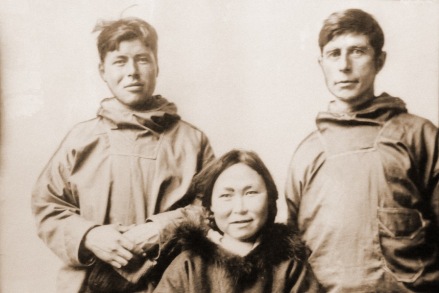
Knud Rasmussen (right)
Knud Rasmussen
Knud Rassmussen was born in Ilulissat in 1879 and died in l933. His father was a Danish minister and his mother was part Inuit and they spoke both Danish and Greenlandic. He spent his childhood driving dog sleds and going on seal hunts with the locals. He owned a rifle at ten.
“When I was a child I used often to hear an old Greenlandic woman tell how, far away North at the end of the world, there lived a people who dressed in bearskins and ate raw flesh…Even before I knew what travelling meant, I determined that one day I would go and find these people…”
(From “People of the Polar North”, Knud Rasmussen 1908).
In 1909 after receiving funding from Denmark, Rasmussen and Peter Freuchen built a trading post and bank in Thule and from there they launched six expeditions around Greenland. Between 1921 and 1924, the Fifth Thule Expedition took Freuchen to Arctic Canada and Rasmussen all the way to Alaska by dogsled. He wrote of the constant struggle for survival, and the fear of death which he believed inspired most Eskimo religious practices, superstitions, taboos, and folktales. Without making judgement, he writes of female infanticide, abandonment of the aged, disease, murder, cannibalism, starvation and battles between villages.
West Greenland was colonized by the Danish in 1721 and the entire population was Christianized by Lutherans from Scandinavia. Greenlanders and Danish commonly intermarried. What makes the far northern corner of Greenland unique is that the Danish colonies went only as far north as Tasiusaq, leaving the Polar Eskimos who lived further north largely unaffected by European influence for another two hundred years.
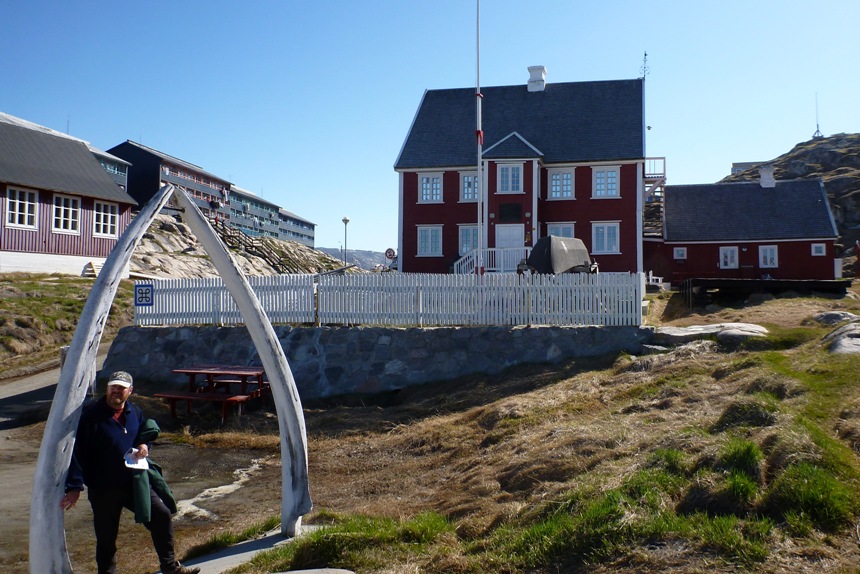
Knud Rasmussen’s family home (llulissat Museum)
An interesting room in the house featured an exhibit with a mural with pictures of local Greenlanders and their opinions on global warming. It seems that younger people see global warming as something positive since it won’t be so cold and children can play outside more often and it will be less expensive to heat your house. Some hunters claimed that with less ice, it was easier to go out by boat and shoot the seals rather than hunt them by dog sled. The older generation lamented that the sea ice didn’t form until after November and less snow made for a less festive Christmas. Some hunters also said they were a bit sad that they could no longer take their dog sleds as far by sea and now could only mainly follow land routes. Another fisherman said he could now do more fishing in his boat as there were now fewer days with the sea covered by ice.
The Greenlanders are equally split over the possibility of oil exploration and it seems there are conferences and a general propaganda campaign by the oil producers to encourage the acceptance of drilling for oil off Greenland’s coasts. Some are very wary of the possibility of oil spills and some are keen for the many jobs and economic benefits it will bring. I feel the economic benefits would surely help the standard of living for some, but all it takes is one oil spill to spoil this wonderfully unique country. Has there been a country in the world with a coastline that hasn’t experienced an oil spill?
Outside the house was a wooden house with a sod roof and I think Stew wants one now. He loves huts, bothies and cave dwellings and, of course, Scottish iron-age stone, semi-underground beehive-shaped dwellings.
We have now arrived in Ilulissat airport for our afternoon flight and are sitting on soft, comfortable seats made from sealskin as we wait to board our flights to Uummanaq.
I think we made a profit today. We got a free helicopter trip, but, rather in a Dash 8. Our airplane (a Dash 8) took off in clear skies with unlimited visibility enabling glorious views over peaked spiky-ridged mountains protruding from the vast ice cap as it stretched to the horizon. Once over the mountainous Nugssuaq peninsula, the entire Uummannaq Fjord was covered in the thickest, densest fog I’ve ever seen even though the sun was shining higher above. The mountain tops poked through the fog and all the neighbouring islands around Uummannaq were visible, but our landing strip at Qaersut was completely and totally obscured. Since the pilot was landing by sight instead of computer, he had to circle the area with the landing gear down hoping for an opening in the dense fog. We circled for well over an hour, and after the third attempt of diving for the landing strip, then dramatically pulling up, I wondered how much of a daredevil this pilot would be. However, once we saw the landing gear go up, he finally turned back to Ilulissat from where we came.
Air Greenland generously provided us with a fantastic Junior Suite in the 4 Star Hotel Arctic with flat-screened TV, hairdryer, sofa, fridge with drinks and snacks in fresh Scandinavian decor with views of sparkling icebergs. The only negative was the entire flight of passengers ended up there creating a chaotic, hectic atmosphere, although I felt the Greenlanders were very patient and not at all rude but very tolerant of the situation.
We left the Hotel Arctic and headed for the more peaceful Hotel Ice fjord for a fantastic evening meal of fresh fish, potatoes and real ale. On our walk back to Hotel Arctic, we came upon the local kayak club with four or five members kayaking during the lovely sparkling evening light with nearby icebergs. We imagined what it would be like kayaking, if we could ever finally get on the water!
Our new flight time was 0730 hours and we were ordered to check in at 0530 hours and eat a free breakfast. So, total profit made today: Free helicopter (Dash 8) trip for two: £200 + free hotel room: £140 = £340.
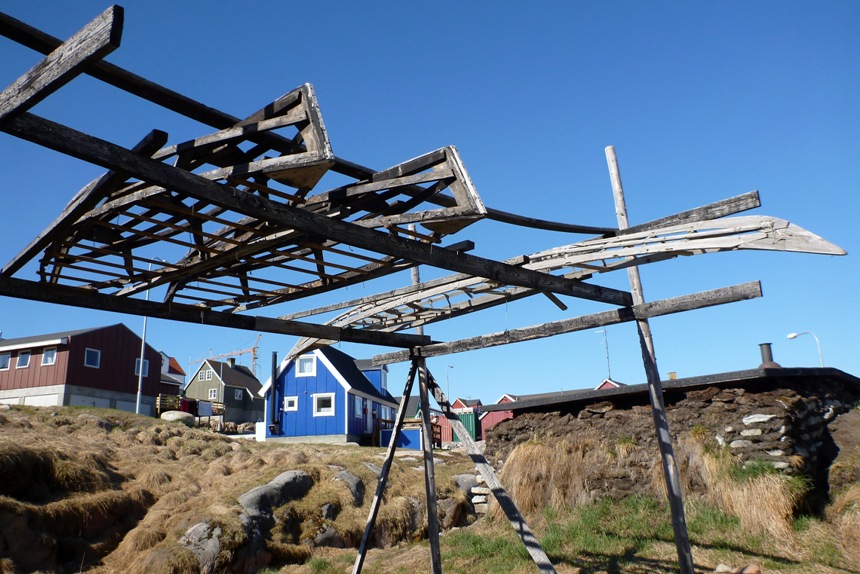
Two Umiak and a Qajaq (right), llulissat Museum
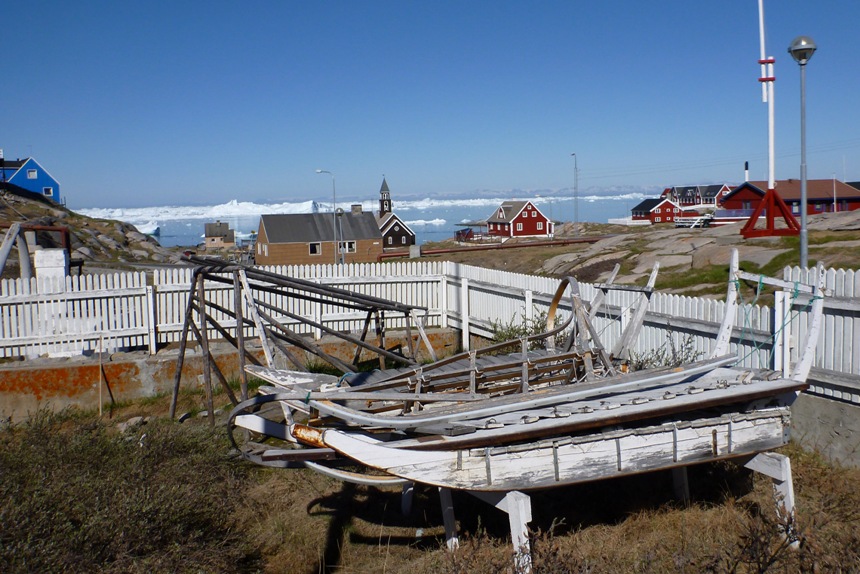
Sleds, Ilulissat Museum

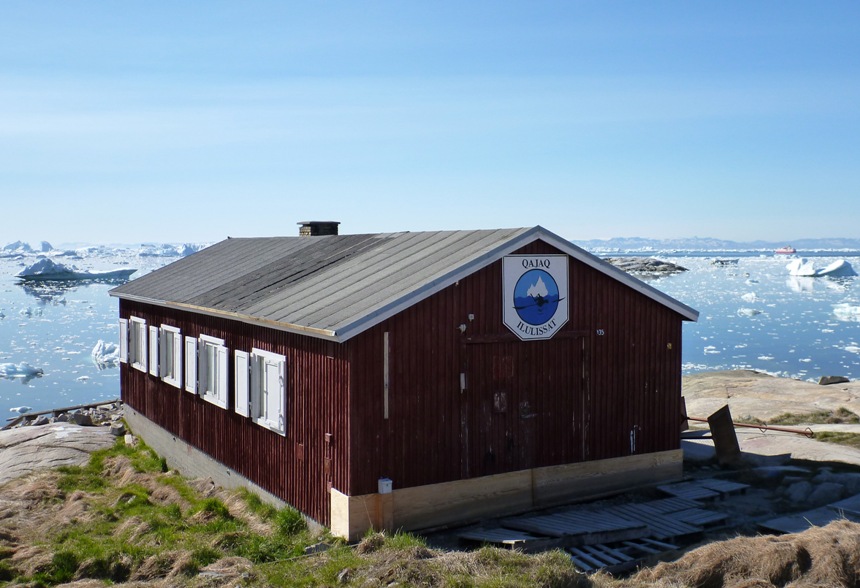
Qajaq Ilulissat
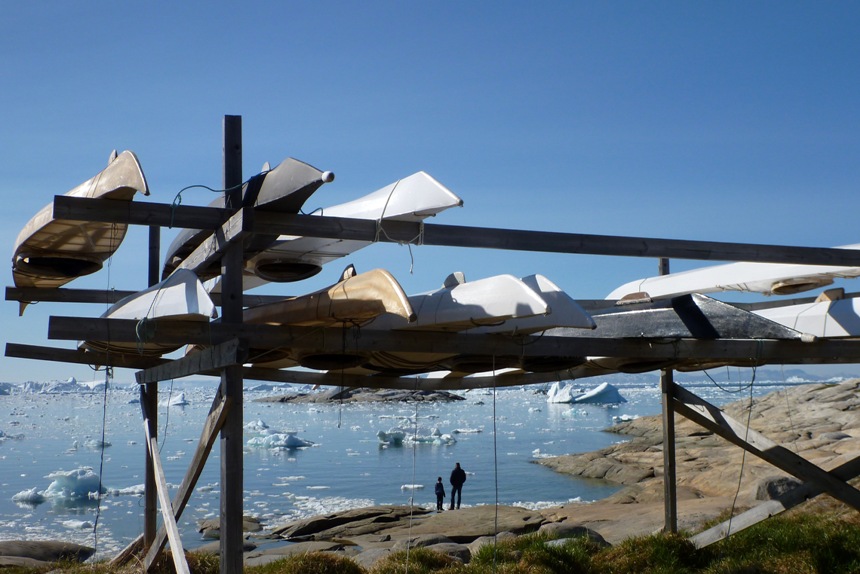
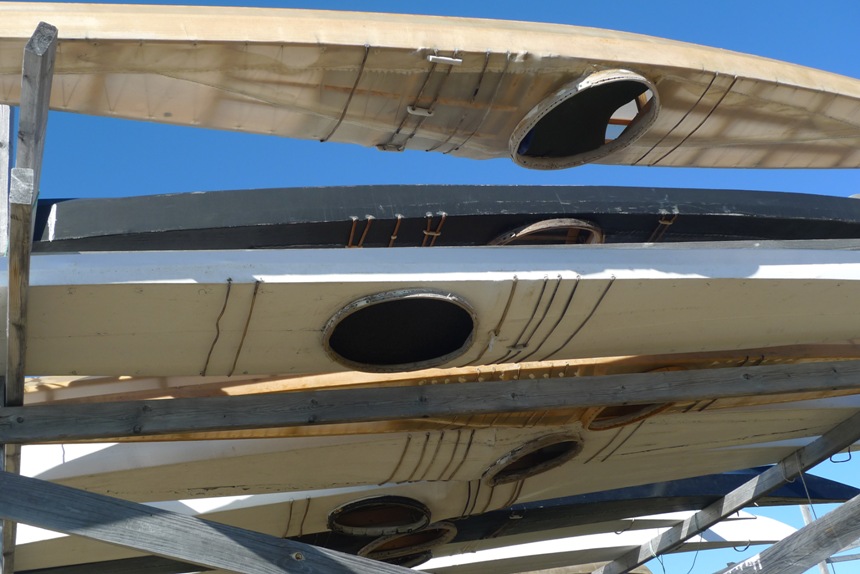

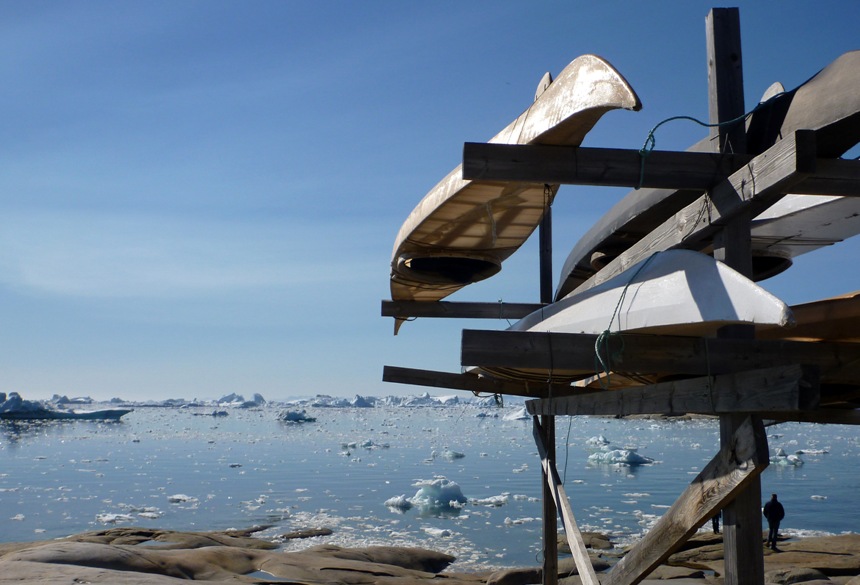
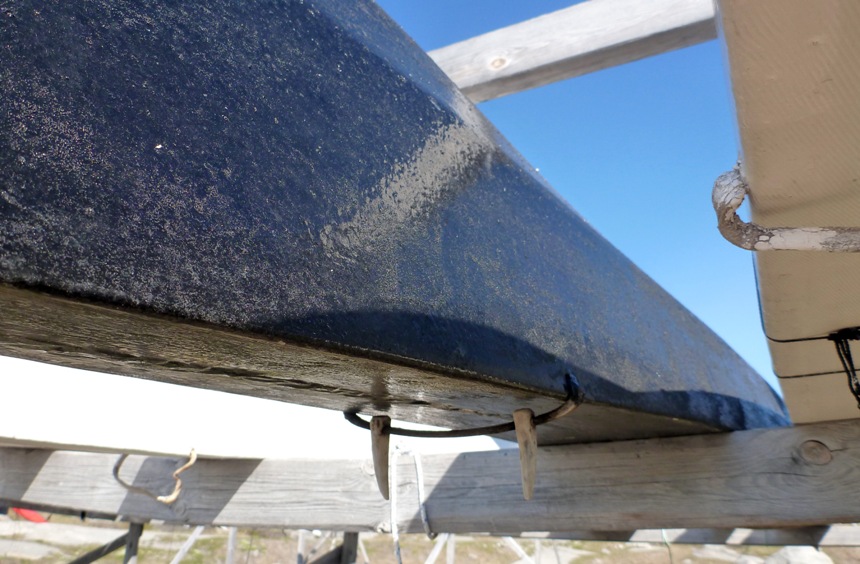
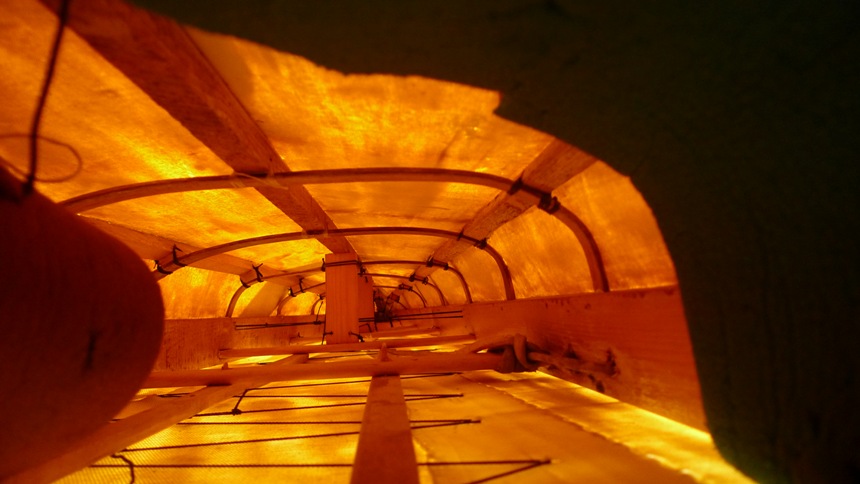

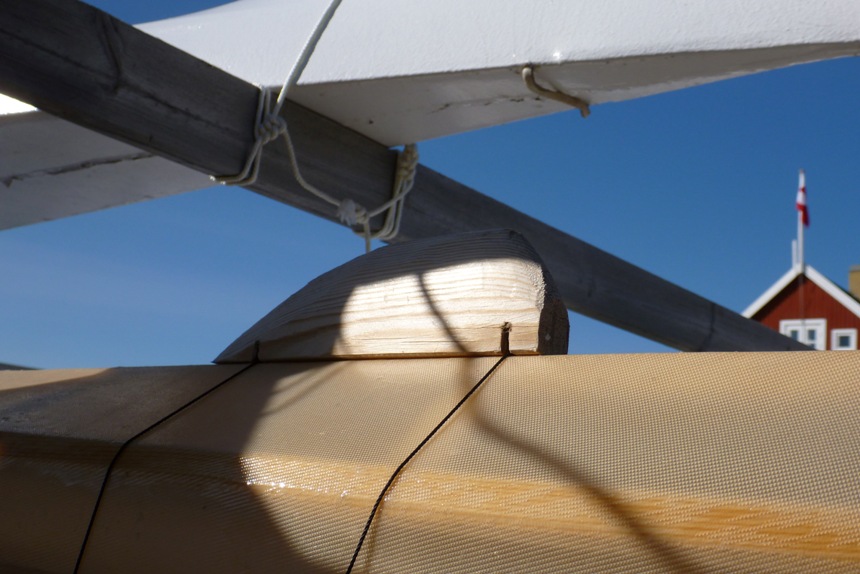
Skeg
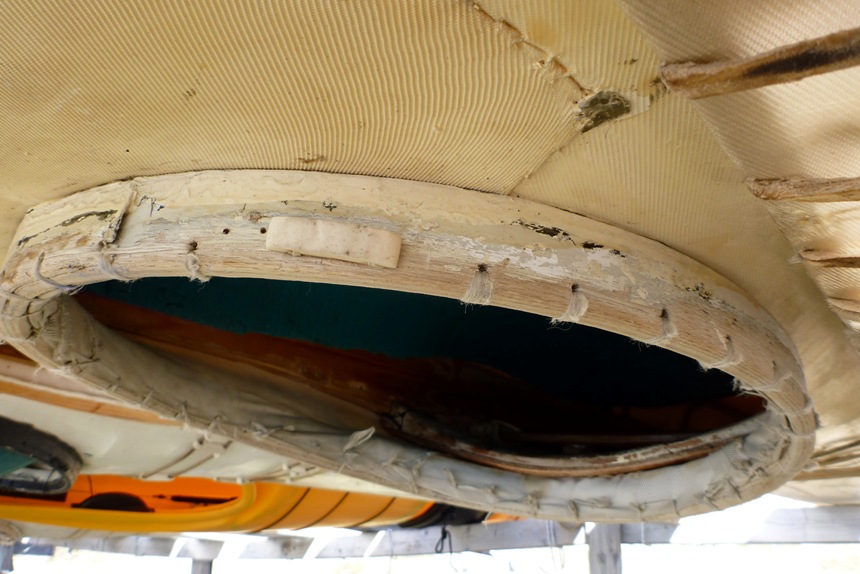

Kayak Rack, Qajaq Ilulissat
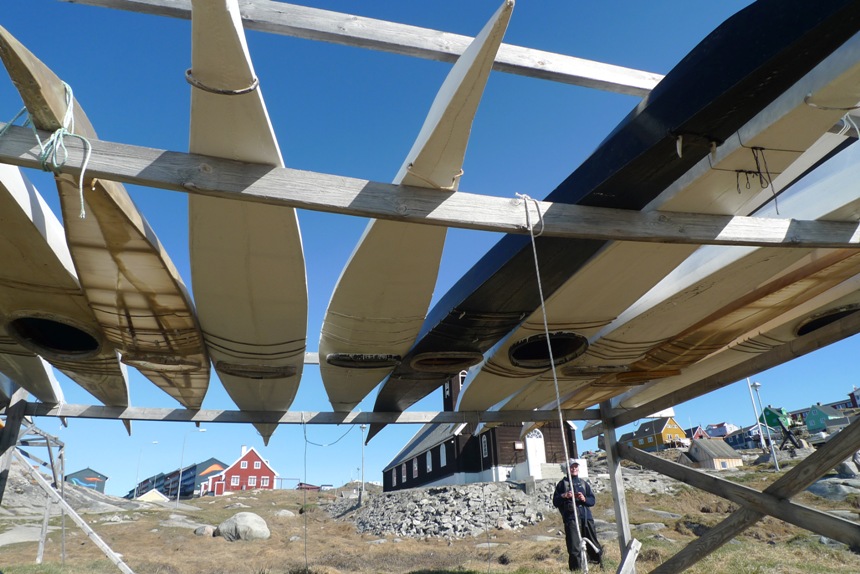

.
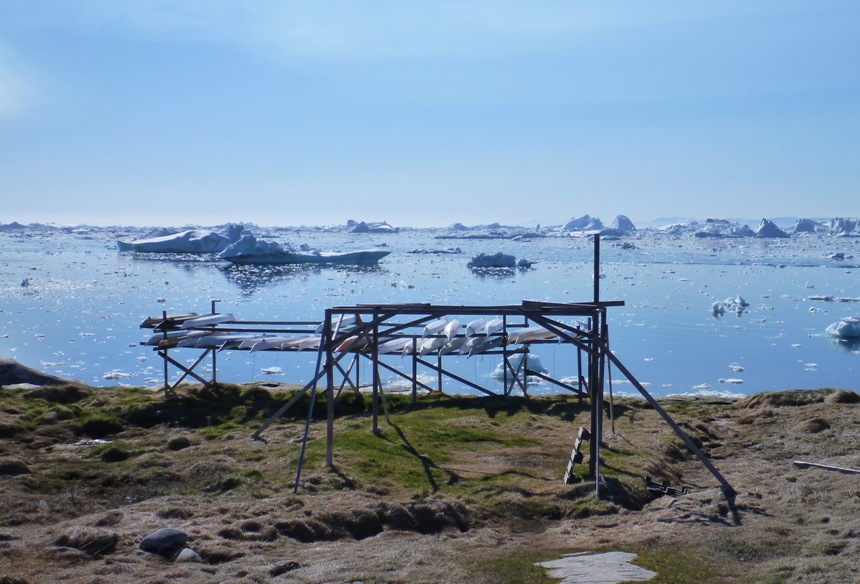
18 June 2013: Ilulissat to Uummannaq (2)
Venturi wind, downdrafts, fjord wind, pressure gradient winds, Foehn winds, katabatic wind, advection fog, sea fog; these were all the conditions we can expect in the Uummannaq area according to our helicopter pilot who flies the leg from Qaersut to Uummannaq. The different islands with their steep cliffs create venturi winds of different pressure gradients and the winds speed up and accelerate around the islands. At Ukussigsat he explained were the worst downdrafts; the locals in Niaqornat walk hunched over from the wind and at Mamorilik on Agpat he experienced winds of 67 knots while in the helicopter. Stefan, our Air Greenland pilot was also stranded with us in Ilulissat as we waited for the very thick morning fog to lift for our now delayed flight. The air temperature has been unseasonably warm causing condensation over the very cold water, and combined with the north-westerly wind direction, a very heavy fog rolled into the fjord.
Our helicopter pilot, Stefan gave us a “pressure gradient” lesson which helped me to understand Foehn winds a bit better. High pressure builds over the ice cap while a low forms over to the West (for Northwest Greenland and to the East for East Greenland). Nature always wants to achieve equilibrium. The air temperature of the low pressure systems are usually warmer and when the low pressure system meets the high pressure, the high pressure air wants to flow towards the low pressure to equalize. Warm air above the ice cap flows down slope like a river causing very strong winds. The smooth edges of the alto cumulus lenticularis (lenticular clouds) are formed by high speed upper atmospheric winds that create upper level waves.
Another slight complication in this increasingly complex trip was the late melting of the fast ice (fjord ice) because of the very cold May. Just two weeks before we left, the ice in the Ikerasak area was 9/10 concentration according to ice charts on dmi.dk website. Now we have to wait for the fog to lift.
To land the Dash 8, pilots require a vertical visibility of 900 feet and currently it’s only 100 feet. We may be here until noon today! Although taking off in fog is possible here, since it’s by pilot sight, landing is not possible. So Stefan revealed to us a pilot’s saying, “It’s better to be on the ground wishing you’re in the air, than being in the air wishing you were on the ground.” “These are Arctic conditions and it doesn’t get any harder than this.” It’s so miserably foggy and cold that I hope we get another free night in Hotel Arctic.
Later, the fog lifted just enough for us to take off – darn! I wanted another free night in the hotel! I’m feeling apprehensive about all this thick fog, the open crossings and the higher than normal ice berg density, but I’m excited nonetheless.
The helicopter connection from Qaersut to Uummannaq was exciting and short. All the luggage of the 10 passengers was bound by some type of cargo net stretched across the width inside and separated us from the pilot. On take-off, the whole helicopter shook violently, whisked us across the fjord and was all over in a noisy 30 minutes. After our landing, Stew had a glance in the nearby shed and spotted our two boxes with the kayaks! They had made it here and undamaged.
While sorting out our gear in the small waiting area, quite spaced out and indecisive on how we were to transport a total of over 100kg of gear the 1km or so up the hill to the campsite by the reservoir, a very nice, tall, Danish guy, named René, who works for the Children’s Home was immensely helpful and found a driver with a pick-up truck that took us to the campsite. We were extremely grateful and he invited us for a coffee later at the Children’s Home.
Our campsite was up a hill down a dusty road behind some small wooden houses but far enough for some privacy. Later we went for the coffee and also met Anne, a Faroese lady who spoke English with a Scottish accent who offered us some very sweet watermelon. We also met Mark, a French film producer who was working with “60 Minutes” on a film about Uummannaq. Everyone was so friendly and we greatly appreciated their help.
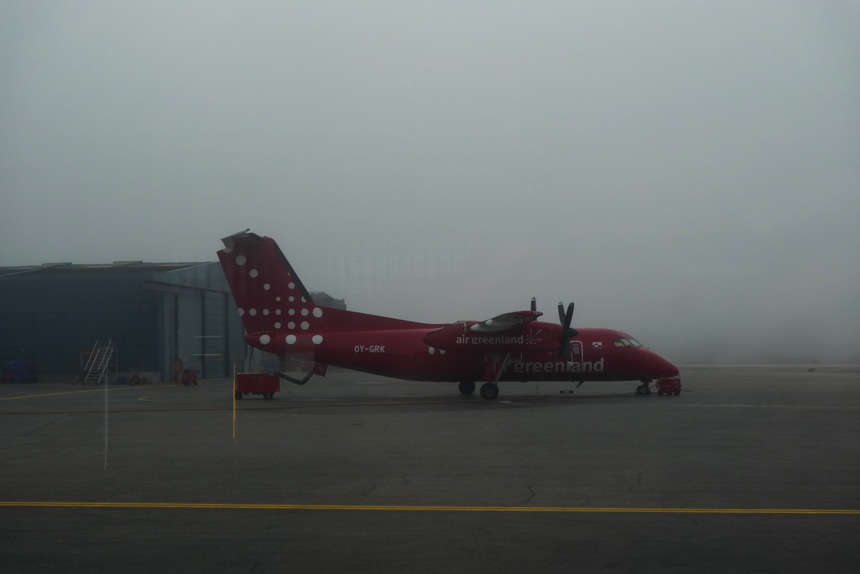
Fogbound, llulissat Airport
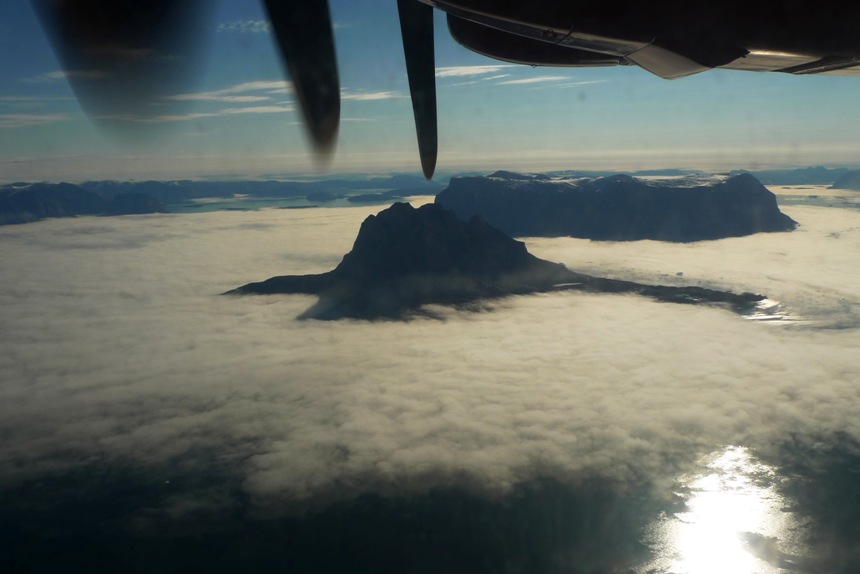
Uummannaq

Qaersut Airport
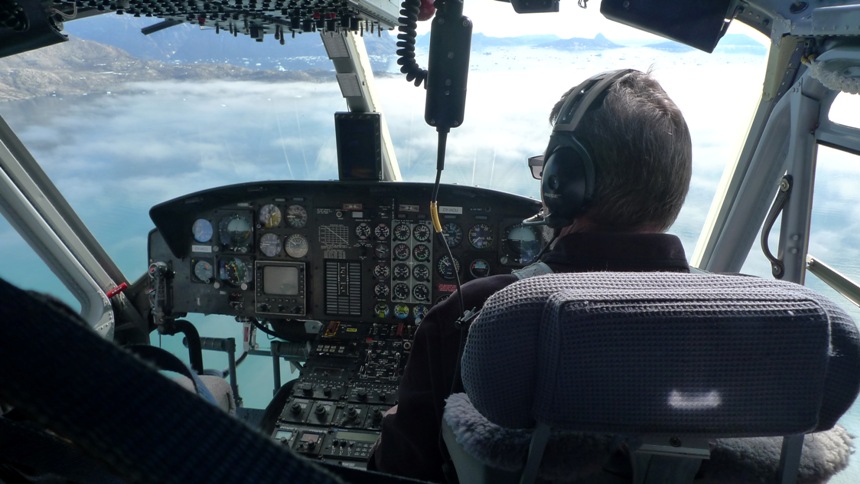
Stefan
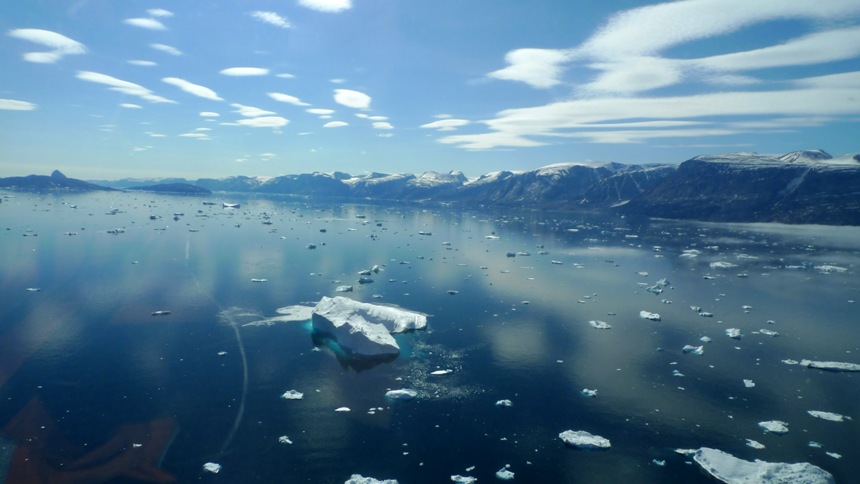
Uummannaq Fjord
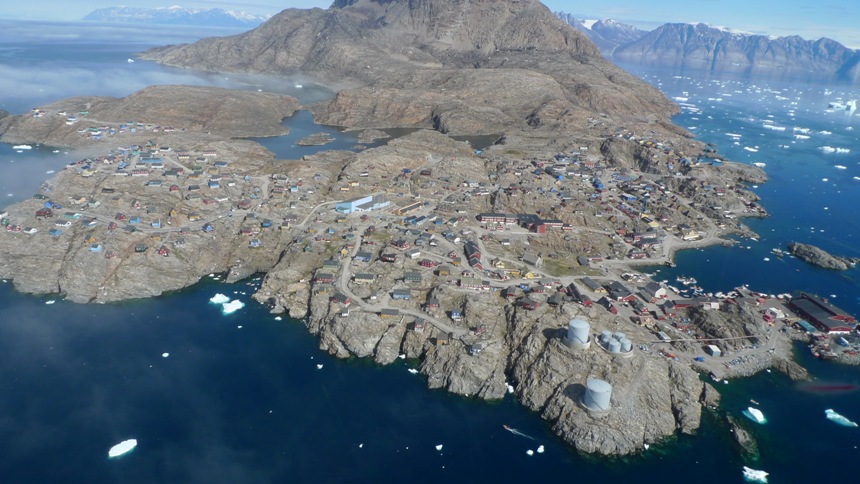
Uummannaq
19 June 2013: Uummannaq to Igldlunguaq, Storøen
Today we finally kayak and we decided to camp at an old Inuit settlement on Storøen which involved an 8km open crossing and what a crossing it turned out to be! Before setting off, however, we had a small SIM card hiccough and discovered the Greenland SIM wouldn’t work in our phone and amazingly, while we were in the Tele-Post Office, Mark walked in and basically saved us! We use the phone to get weather forecasts and we hadn’t enough credit on it when we left and assumed we could get a Greenland SIM. He helped us immensely by inviting us to his house to use his computer and phone to allow us to top up our Vodafone credit.
After a few hours spent of hauling our gear down to the harbour, building and loading our boats, we were finally ready to start paddling at 7.50pm! A few Greenlandic children gathered to give us a good send off and after a push into the water we were off! The Uummannaq area is more visually stunning that I could have imagined, even foreboding. We headed off on a bearing of 127 deg in case of fog, mentally reciting the mantra, “37 deg West, Compass Best”, trying to remember that even though our true bearing on the map was 90 deg, our compass was reading 127 which took a while to get used to.
The mountains were huge and imposing and in the evening light, Storøen looked like it was only 2km away instead of 8km or so and seemed to rise out of the sea like one giant, towering cliff.
The entire day had been calm, sunny and cloudless so I was a bit surprised when the wind began to pick up since the evenings are usually calm and by now it was 9pm and already a stiff 15mph headwind. Out to the southeast in the sky over the ice cap, I saw something I always hoped I wouldn’t see during our trips to Greenland – a lone lenticular cloud over the ice cap. I kept my eye on it and after another half hour or so, as we got closer to the cliffs, I saw another two to three lenticular clouds pop up. Oh no, this means the start of a strong Foehn wind spilling it’s warm air, like a river, from the ice cap down to the fjord straight towards us!
The evening light was lighting up the icebergs and jagged, snow-covered mountain vistas with a dramatic grandeur that was a bit scary. Such overwhelming, unforgiving nature! But now the wind was steadily strengthening and the only landing was still a few kilometres away. As we finally approached the cliffs, the headwind strengthened to an alarming mid- to upper 20s knots with even stronger, gusty downdrafts from Storøen which towered 1400m from its pinnacles straight down to the sea. The old Inuit camp was just a few hundred metres away now, but we were barely inching forward. The thought of having to turn around and go downwind back through the boiling cauldron of wind waves just drove me on to get to shore. Every forward stroke took all my strength, but fear had no place here so I just paddled my wee guts out and we eventually made it! It was well after 10.30pm and took us about 2 ½ hours. I wasn’t exhausted because of the adrenaline, but I don’t know how much longer I could have kept going, especially if the wind got any stronger. I’m so glad we spent the past few months paddling our K1s fully loaded (including a 10L water bag) on every trip, including day trips in stiff headwinds. My 40 push-ups a day, weightlifting, running and core abdominal exercises must have helped also.
We landed on two flat slabs of rock just big enough for our kayaks. I was never so glad to get off the water and our wild campsite was stunningly beautiful. It had the qualities I love – a higher steep mountain backdrop, grassy plateau with nice soil for pegging, a small cliff down to the water, all overlooking icebergs in a grand, blue sparkling fjord. Magical! We finally got to bed at well past midnight (no darkness, just twilight), but had a broken sleep with the strong winds battering our tent and later, driving rain.

Storøen from Uummannaq
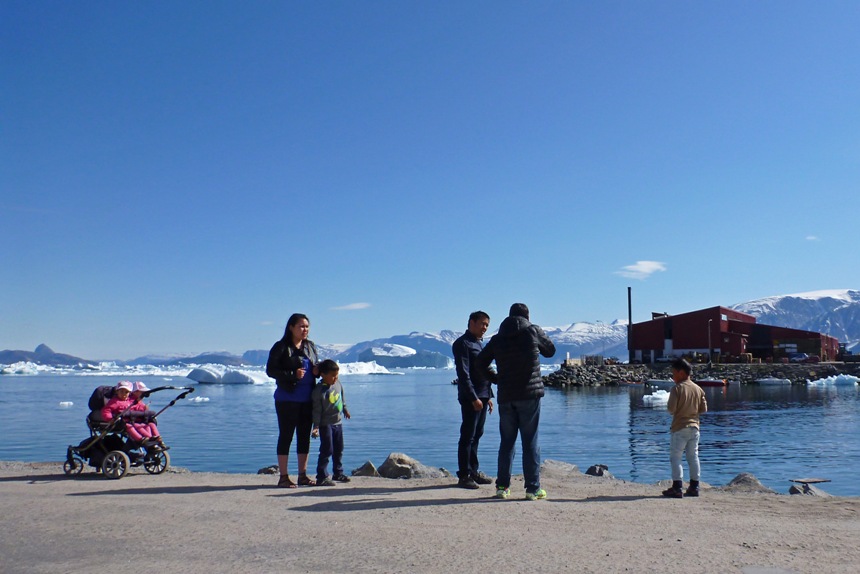
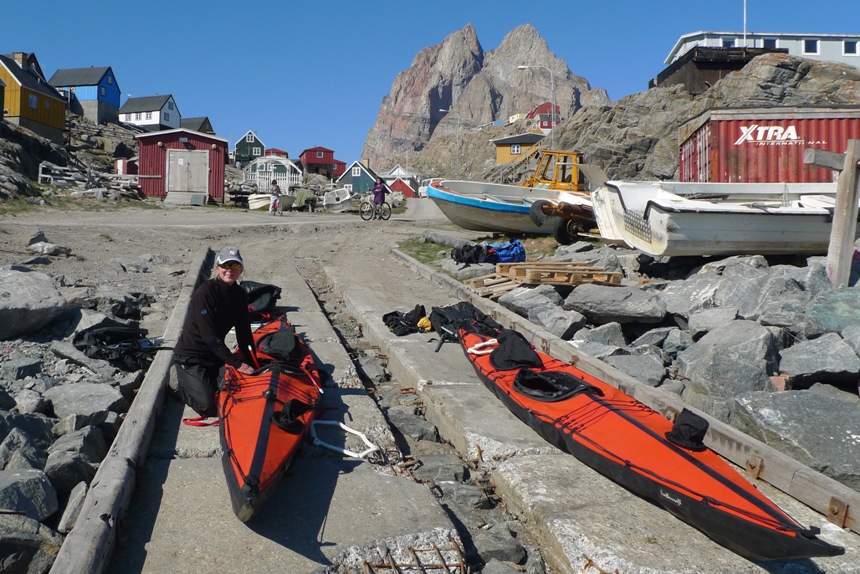
Kayak assembly, Uummannaq
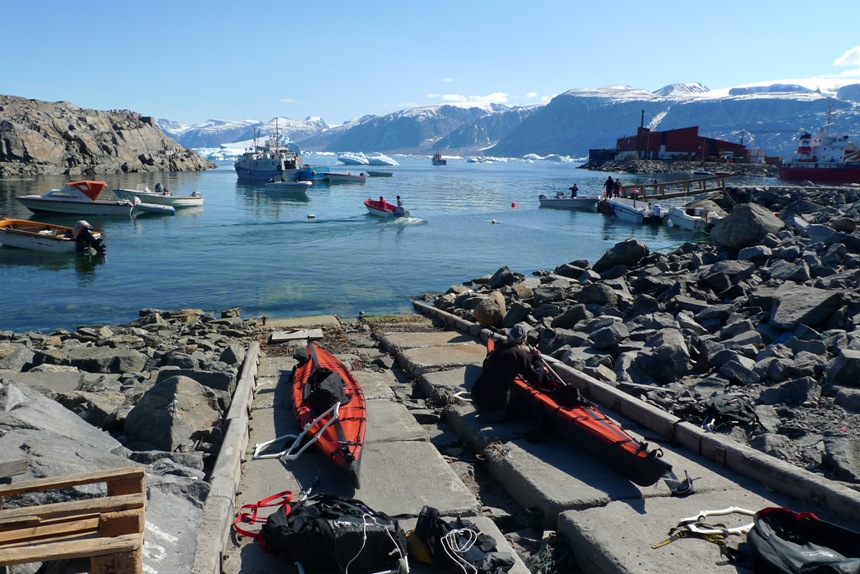
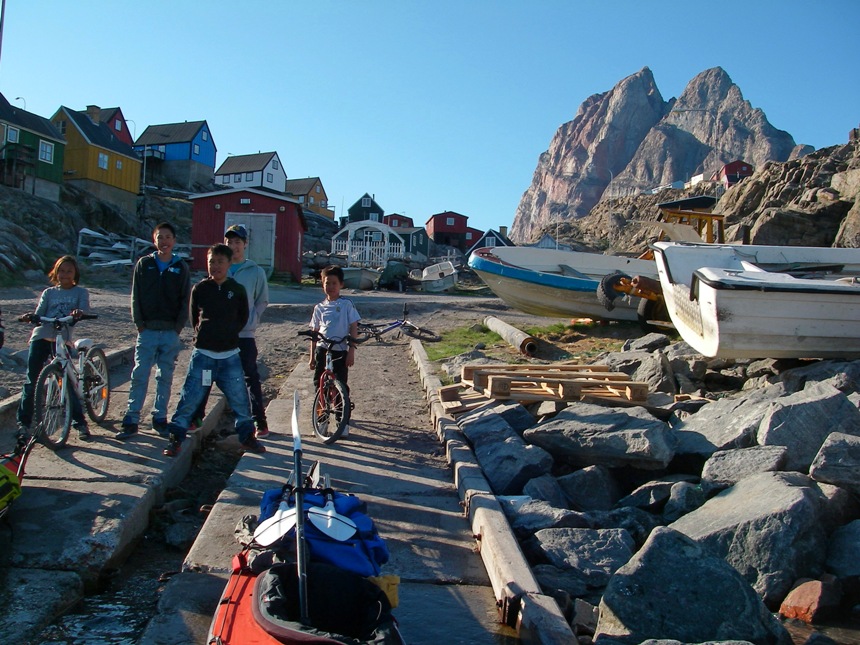
Leaving Uummannaq
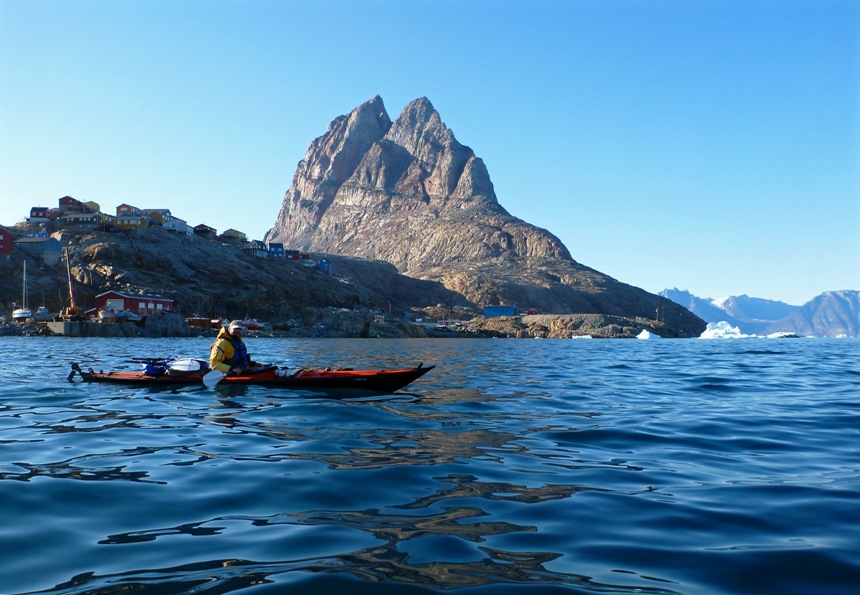
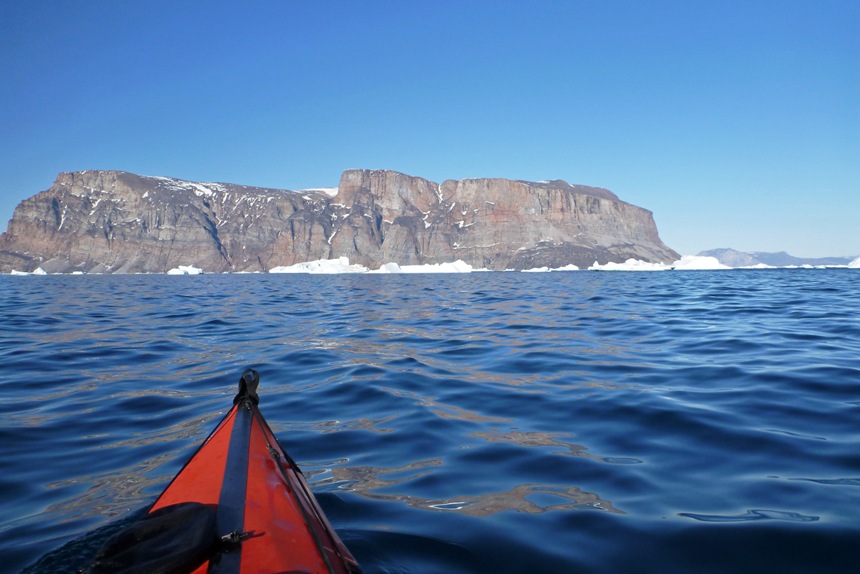
Ivnarssuaq, Storøen

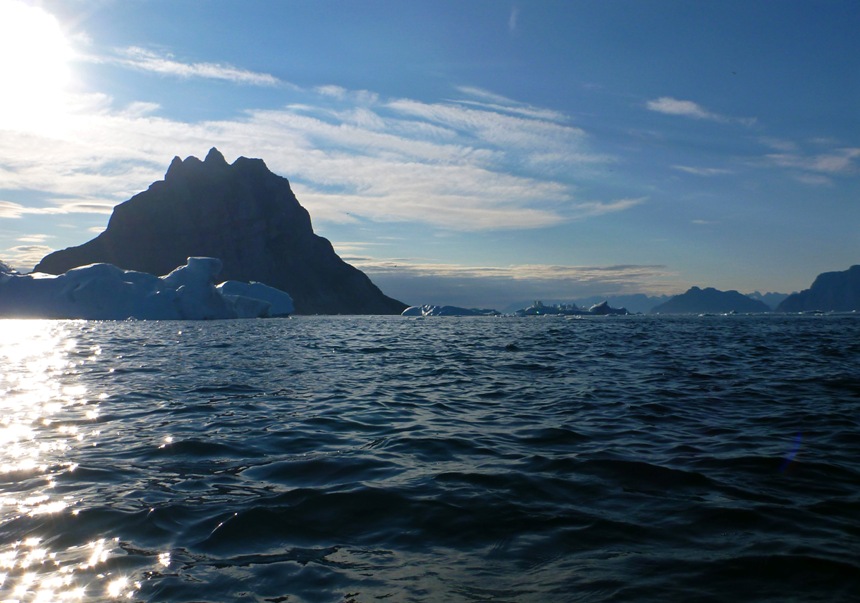
.
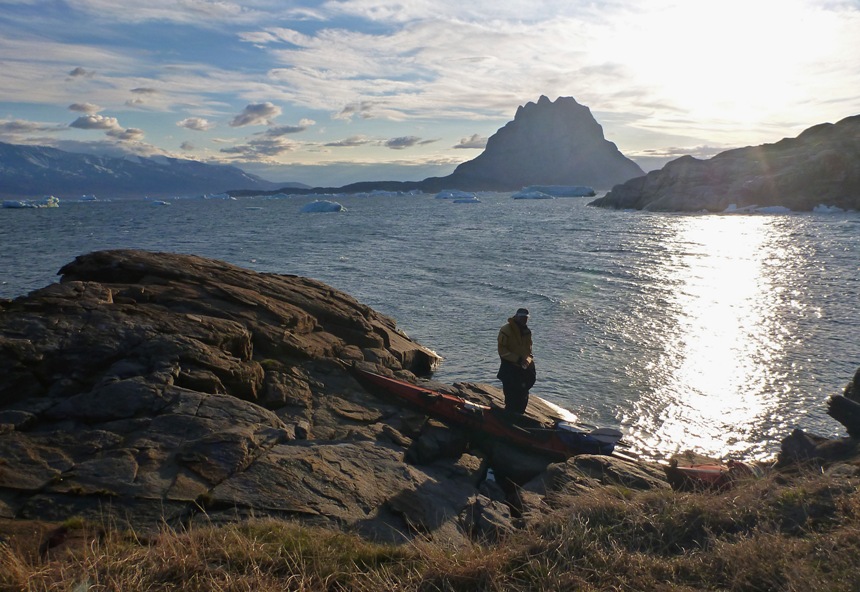
Igdlunguaq, Storøen

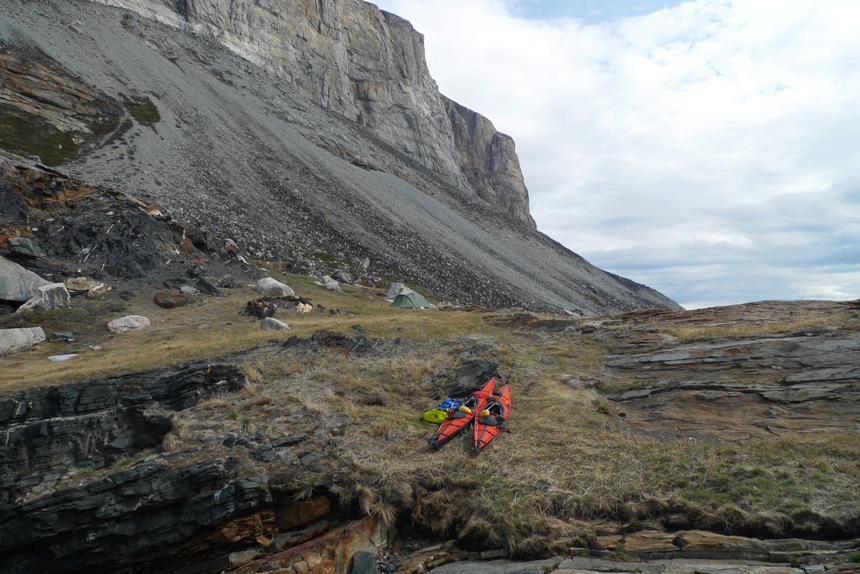
Igdlunguaq, Storøen
20 June 2013: Stormbound, Igdlunguaq, Storøen
A southeast of 15 m/s (30 knots) was forecast so we spent a lovely, although windy relaxing day exploring the small plateau, and photographing the tiny pink willow herbs, yellow arctic marigolds, vast carpets of creeping willows and miniature stream with small waterfalls overlooked by the sheer walls of the mountainside looming over 1200 vertical metres above us
Stew’s expert fishing fed us with a Greenland torsk (cod) and a small Atlantic cod, and also two short-horned skulpin, which although cute, weren’t edible. I also gathered mussels for the starter.
Takanaluk Arnaluk (Mistress of the Sea)
A prominent character in both Greenland and Arctic American Inuit folklore is the Mistress of the Sea.
“There was once a girl who refused all offers of marriage, until at last she was enticed away by a petrel disguised as a handsome young man. After living with him for some time she was rescued by her father, but the petrel, setting out in pursuit, raised a violent storm, and the father, in terror, threw the girl overboard to lighten the boat. She clung to the side, and he chopped off, first the tips of her fingers then the other joints, and finally the wrists. And the joints turned into seal and walrus as they fell into the sea. But the girl sank to the bottom, and lives there now, and rules over all the creatures of the sea. She is called Takanaluk Arnaluk; and it is her father who is charged with the punishment of those who have sinned on earth, and are not yet allowed to enter the land of the dead.
Should hunting fail at any season, causing a dearth of meat, then it is the business of the Angakoq to seek out the Mistress of the Sea and persuade her to release some of the creatures she is holding back.
The angakoq sits naked on the bare snow or bare earth and remains in meditation for a while and then he invokes his helping spirits, crying again and again: Tagfa arqutinilerpoq – tagfa neruvtulerpoq! (The way is made ready for me; the way is opening before me.)
When the helping spirits have arrived, the earth opens beneath the angakoq where he sits. Then comes a voice close underground: halala he-he-he and again further off under the passage until at last it is no longer heard; and then all present know that the angakoq is on his way to the Mistress of the Sea.
Meantime, those in the house sing spirit songs in chorus to pass the time. It may happen that the clothes the wizard has taken off come to life themselves, and fly about over the heads of the singers who must keep their eyes closed all the time. And one can hear the sighing and breathing of souls long dead.
On reaching the house of Takanalukarnaluk, a wall has been built in front of the entrance; this shows she is hostile towards men for the time being. The wizard must at once take her by the shoulder and turn her face the other way, at the same time stroking her hair and smoothing it out. He then says:
‘Those above can no longer help the seal up out of the sea.’ To which she replies, ‘It is your own sins and ill doing that bar the way.’
The wizard then exerts all of his powers of persuasion, and when at last her anger is appeased, she takes the animals one by one and drops them on the floor. And now a violent commotion arises, and the animals disappear out into the sea; this is a sign of rich hunting and plenty to come.”
From “Across Arctic America”,1927, Knud Rasmussen

Iceberg Carnival Procession, Uummannaq Fjord
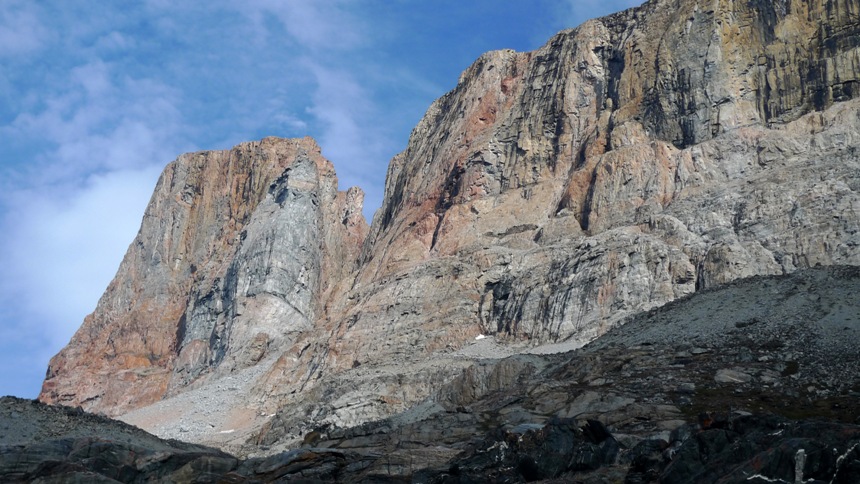
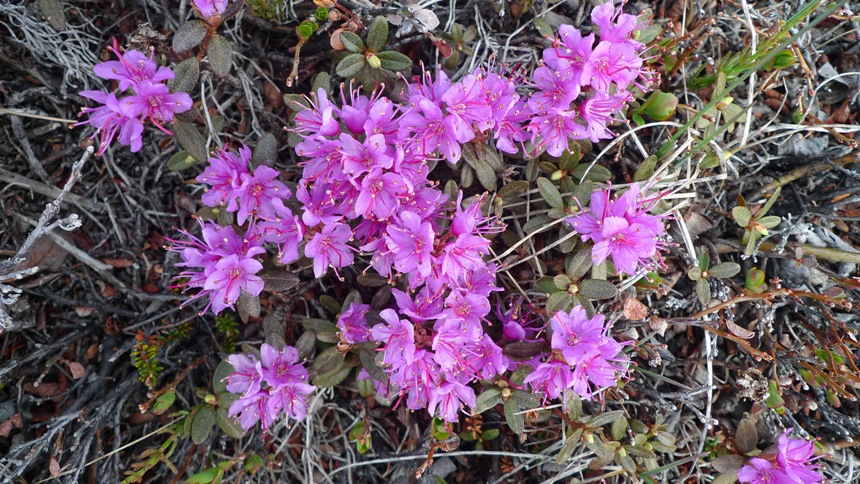
Broad-Leaved Fireweed
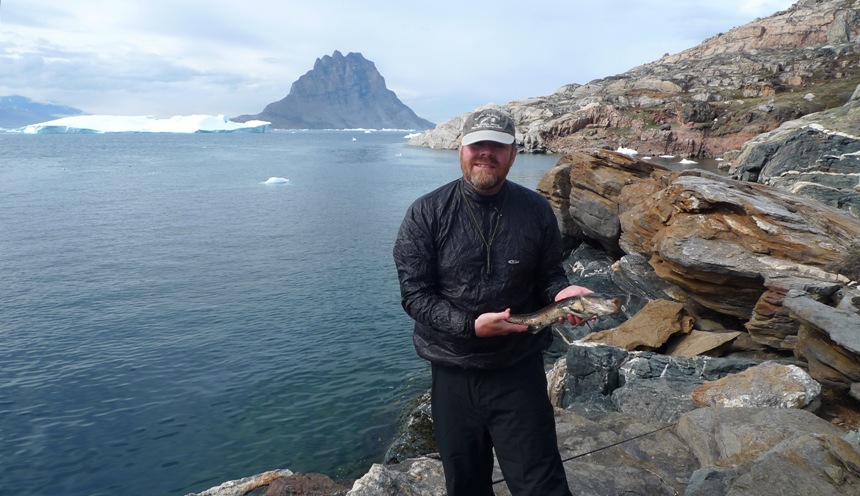
Greenland Cod
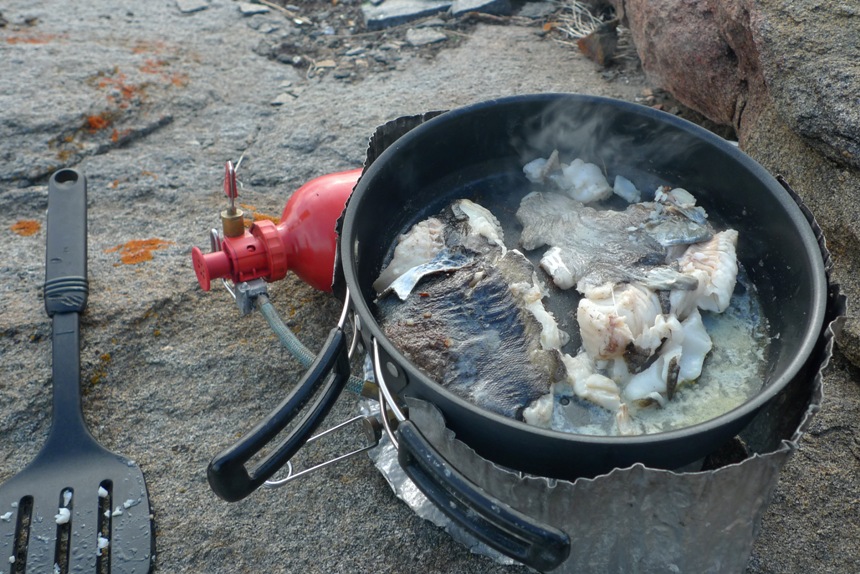
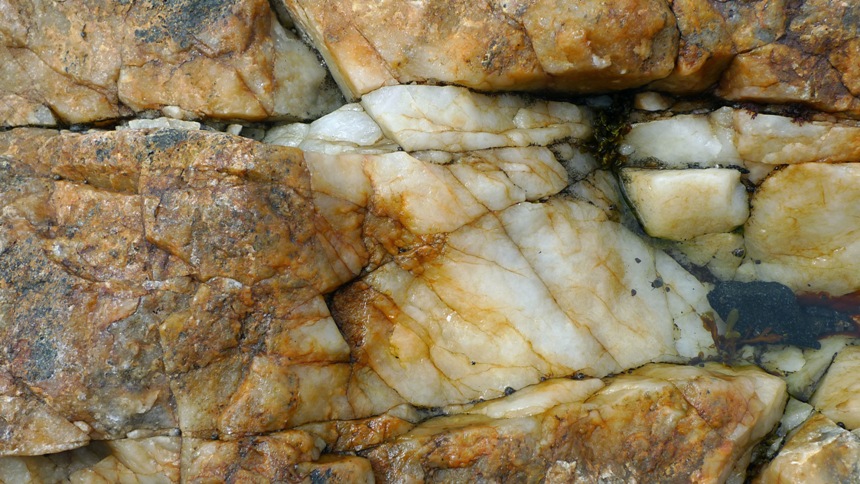
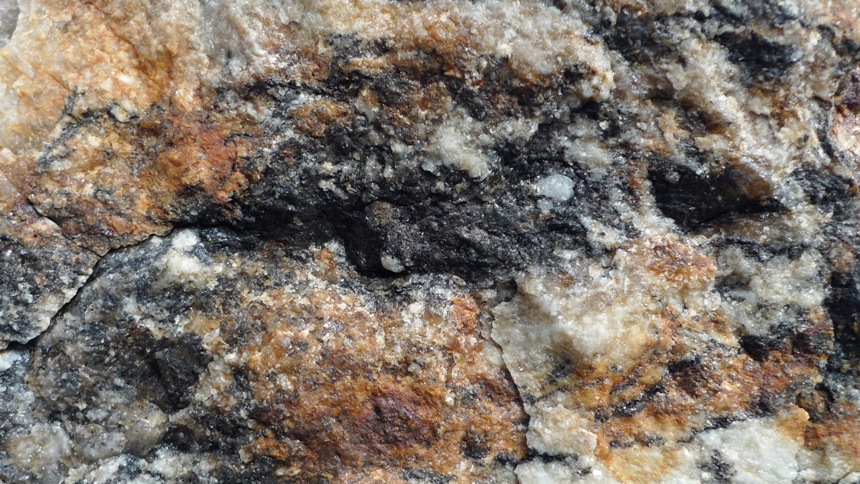

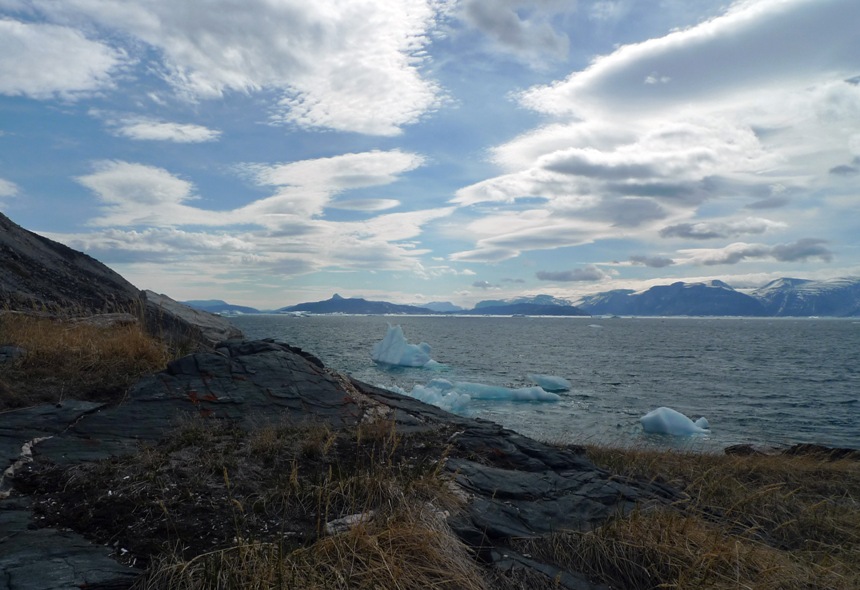
Lenticular Sky, Uummannaq Fjord
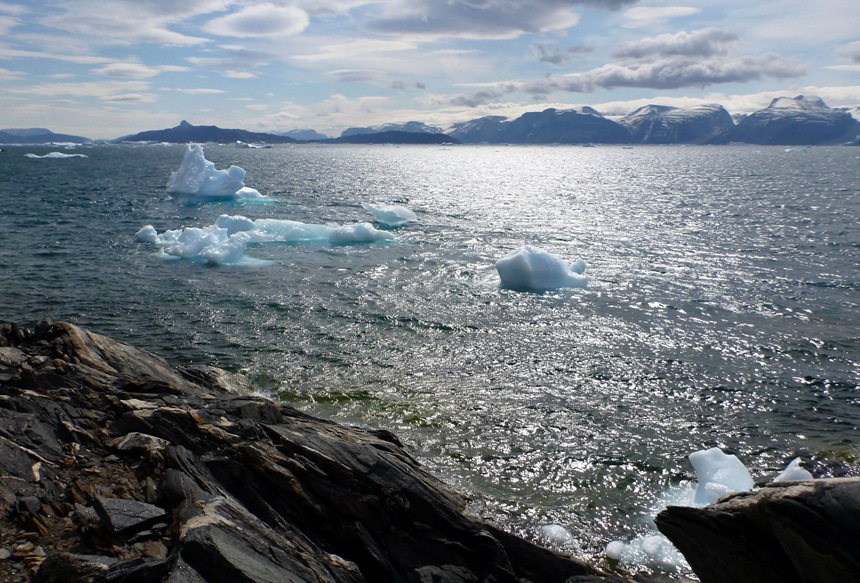
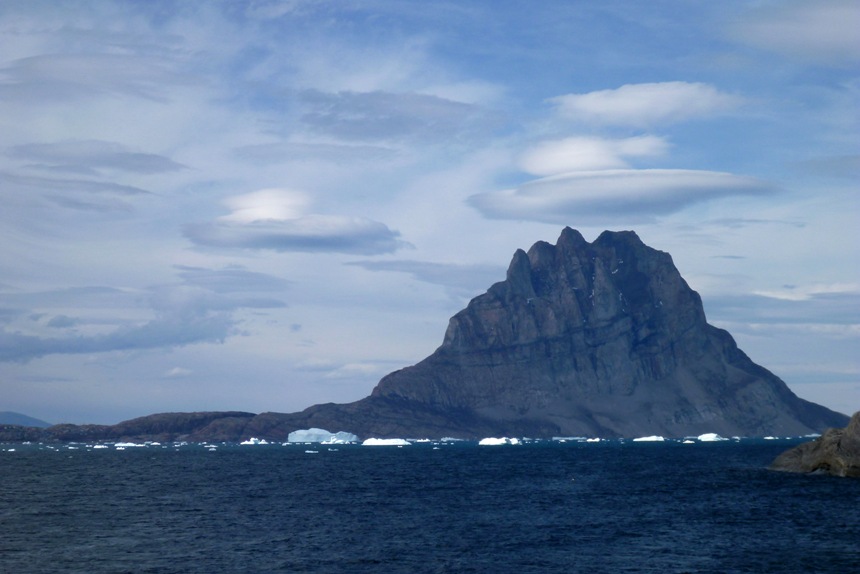
Lenticular clouds over Uummannaq
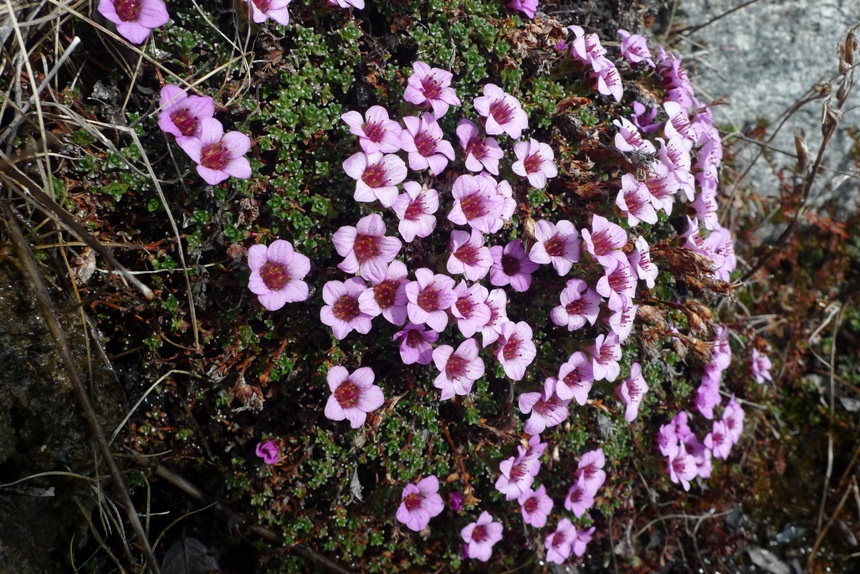
Purple Saxifrage
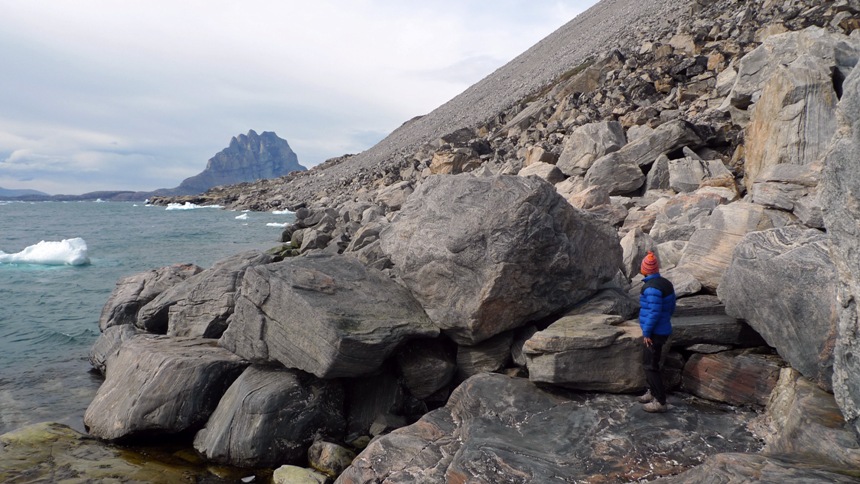
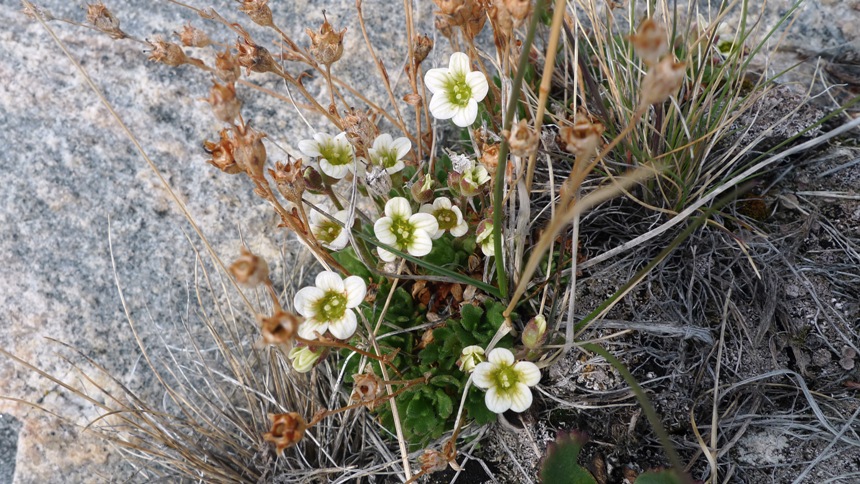
Grass of Parnassus
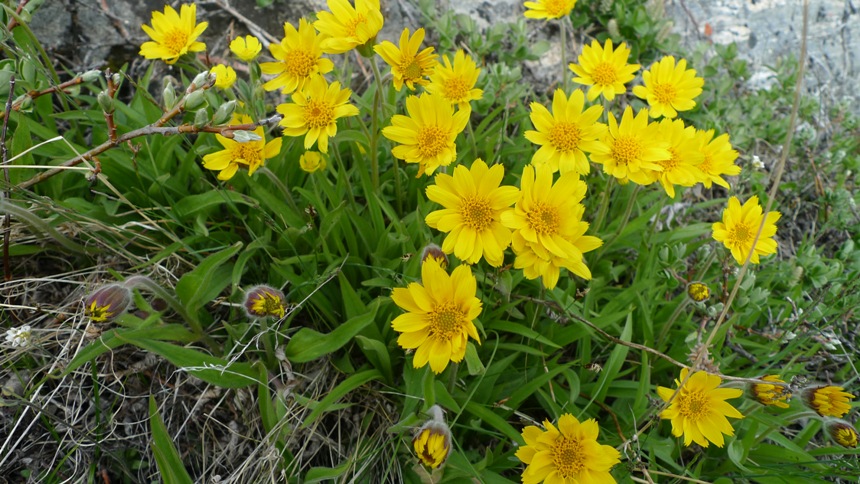
Arctic Arnica
21 June 2013: Stormbound, Igdlunguaq, Storøen
The Foehn wind persists and the forecast is southeasterly winds of 12 m/s or 25 knots. Even when it’s overcast and windy and cold, this place sparkles and glitters. Sitting overlooking the fjord, giant icebergs float past, pushed by the strong winds as if in a hurry to their journey to the open sea. Since the gales of yesterday (about 15m/s or 30+knots), the ice from the late melting of the fast ice near Store Gletscher, combined with the large icebergs that were bound in the fast ice, have now been released and pushed down the fjord near us, filling the entire fjord to Uummannaq. We had planned to go near Ikerasak area which was as recently as two weeks ago 9/10 covered with ice floes and bergs whereas here, the water at first was relatively clear of ice. Now, all the area to Ikerasak is probably 50% filled with ice and I’m not sure if that’s good or bad for us as we are now still stormbound for the third day. But what a magnificent place; it must be the most beautiful place we have ever camped.
Today we discovered the remains of an Inuit sod house and one could only imagine the type of beautiful but brutal subsistence existence they must have had. The icebergs are increasingly gathering along the shore of this island and blocking our landing spot. I honestly don’t know how we’re going to land at our next camp.

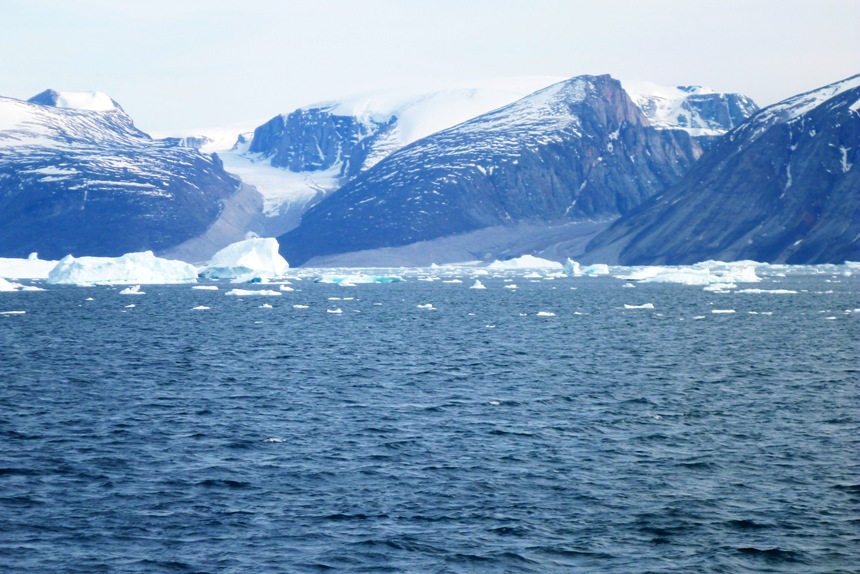
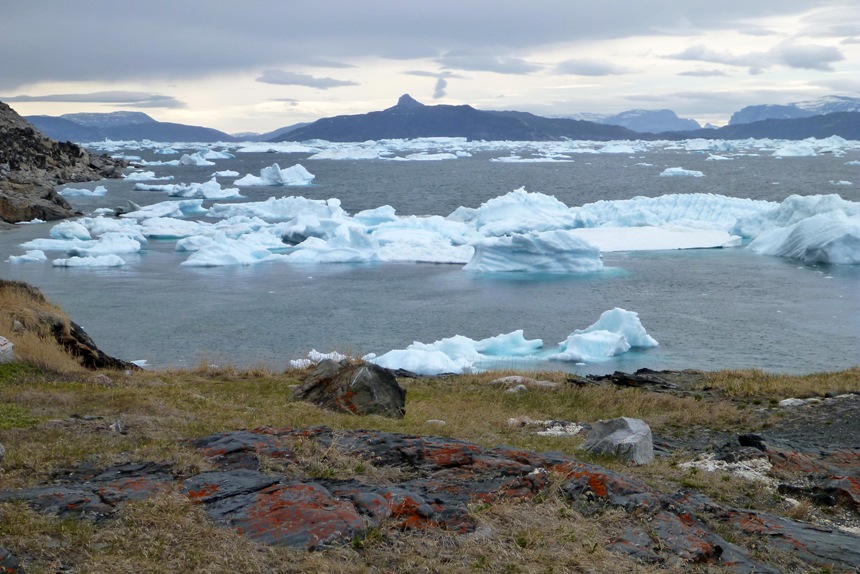
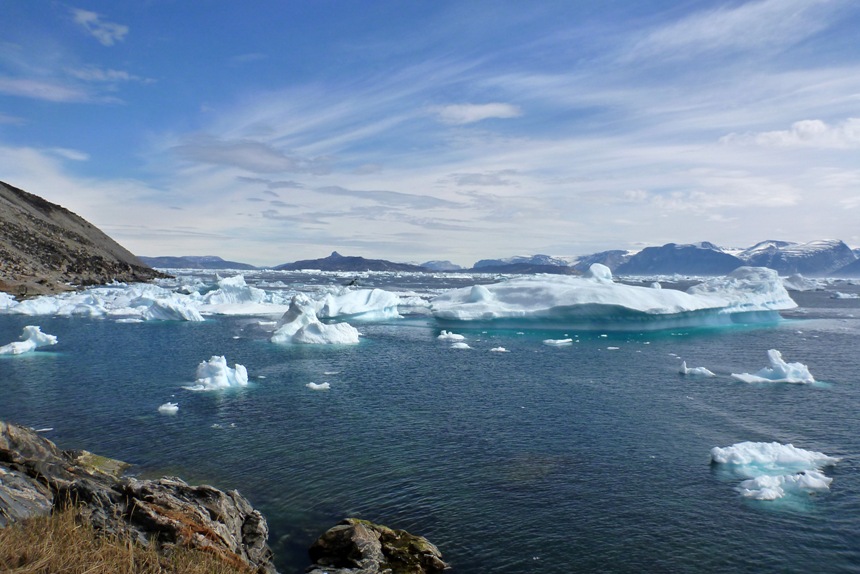
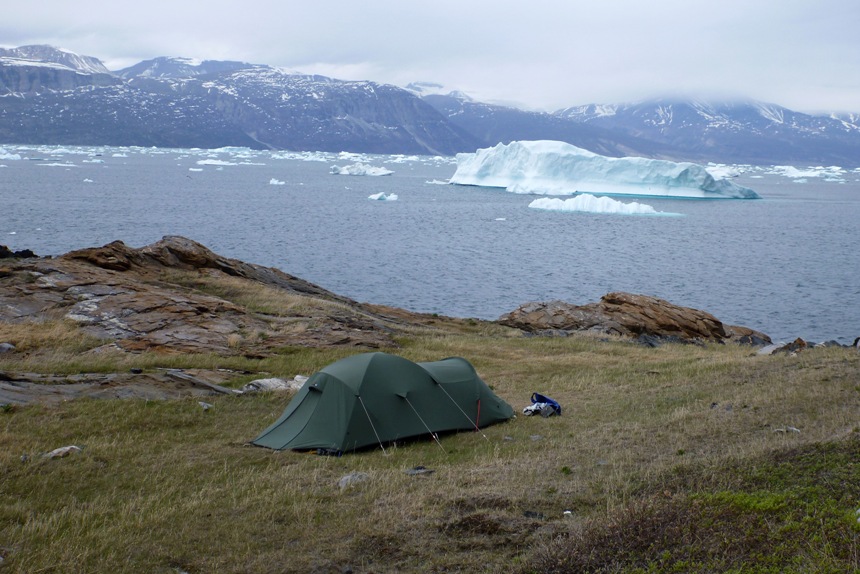
Igdlunguaq, Storøen
22 June 2013: Stormbound, Igdlunguaq, Storøen
Since the wind is still strong, (12 m/s or 25 knots), we’ll stay put today. The lenticular clouds of yesterday are today replaced by altostratus and nimbostratus so it’s a bit showery, but the arctic light is atmospheric and one can get shelter from the strong wind behind a rock and watch the icebergs on their journey and even observe them rolling, exploding and breaking up.
I’ve been curious to witness a Foehn event but yet not really want to, but all the ingredients were there these past few days to produce this dramatic weather phenomenon. It started a few days ago with exceptionally warm, cloudless, sunny skies; the barometric pressure started to drop as a low over Baffin Island formed. Lenticular clouds started forming over the ice cap to the southeast just as we kayaked across and we experienced wind in the mid-20’s knots. It was dry and unseasonably warm (14 C) and the sky was filled with amazing blue black lenticular clouds which indicate strong wind waves above the ice cap. The Foehn started during our open crossing.
It still persists and the wind last night was especially fierce as the gusts pressed down and shook the tent like a giant hand of an angry wind god. I was awoken several times by the bomb-like echoing of cracking or exploding icebergs. I felt a bit vulnerable and a little scared but our trusty Quasar tent was steadfast and true, like my husband who chose it! There was no collapsing over one’s face or broken poles.
Angry Storm Spirits
“The heavens are full of naked beings rushing through the air. Naked men and women, rushing along and raising the storm, raising the blizzard.
“You hear it? A rushing as if the wings of mighty birds, up in the air. It is the fear of naked beings, the flight of naked beings, the flight of naked men.
“The spirit of the air drives forth the storm, the spirit sends the whirling snow out over the earth, and the helpless storm-child Narsuk, shakes the lungs of the air with its weeping.
“Hear the crying of the child in the shrieking of the storm!
“And see now – there among the hosts of naked ones in flight is one, a single figure, a man pierced all into holes, and the wind howls through them – Tchee-u-u-u; tchee-u-u-u. Hear! He is the mightiest of them all.
“But my helping spirit shall bring him to a stand; bring all to a stand. Here he comes striding down sure of victory towards me. He will conquer, he will conquer – Tchee-u-u-u, Tchee-u! Hark to the wind! Hist, hst, hst! See the spirits, the storm, the wild weather, rushing by above us, with a sound as the wings of mighty birds!”
(Angakoq’s (shaman) invocation to appease angry storm spirits during a three-day blizzard from Knud Rasmussen’s “Across Arctic America”, 1927).
Because of the strong winds yesterday, Stew wasn’t able to catch any fish so I gathered mussels and tossed them in buttery pasta and even gathered some bladder wrack seaweed to boil up. The taste wasn’t as disgusting as I thought, but the texture was unappetising and after a few forkfuls we decided to toss it and only gather it after we’ve completely run out of food. Anyway, I hope Stew catches some fish today. Tomorrow the weather is to finally settle enabling us to move on.
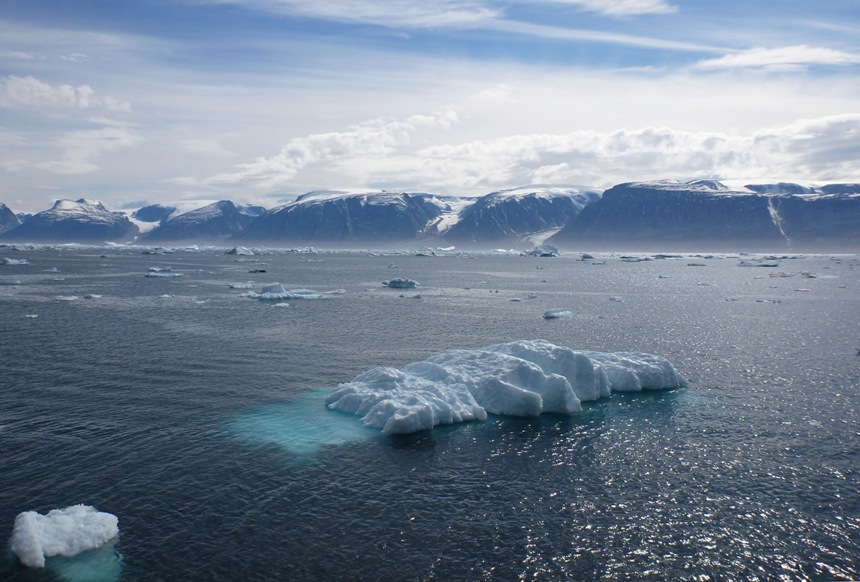
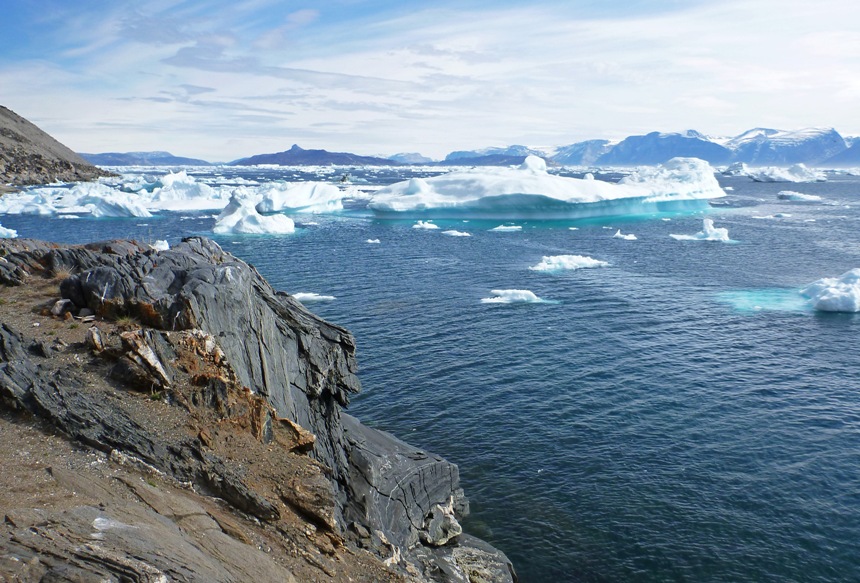
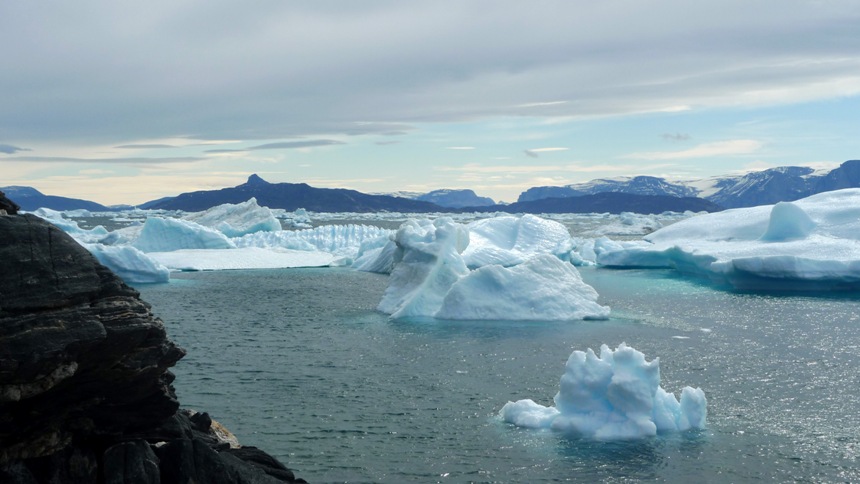
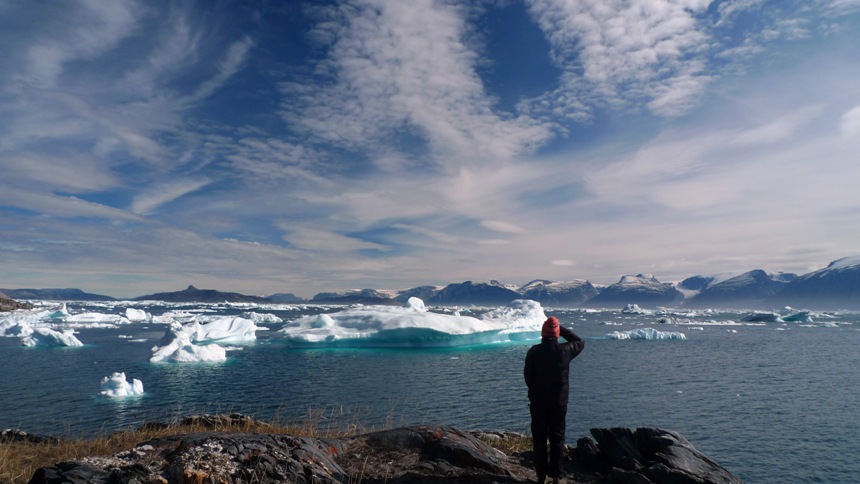
23 June 2013: Igdlunguaq to east Akia, Storøen
We finally paddled today! It was finally calm enough to negotiate the cliffs which were unforgiving rising vertically straight from the water up to 1400m. It was calm, but for a good 10 km there wasn’t even a rock ledge to get out.
Akia is the eastern end of the island and the waters teemed with millions of small fish and loads of icebergs. The gales blew many of the icebergs out of the fjord into the more open areas and explosions were heard frequently throughout the day. We passed by a group of young Greenlandic teens camping on the shore and other families were out speeding along in their motorboats enjoying the bright day. At this end of the island, the landscape flattened out and consisted of desert-like red sandstone and ochre-coloured hills and beaches.
We camped on scrubby tundra and an arctic fox circled our camp looking for an easy meal to steal. We caught seven tiny fish and could’ve caught more if we had a net. It was a very warm sunny evening. Stew encountered a dead dog on the beach which he buried. How did it get there? It must have been part of a dog sled team which came over the frozen fjord in the winter. Greenlandic dogs are always howling mournfully.
Perhaps the mournful howling of the sled dog could best be described in Jack London’s, “Call of the Wild”:
“With the aurora borealis flaming coldly overhead, or the stars leaping in the frost dance, and the land numb and frozen under it’s pall of snow this song of the huskies might have been the defiance of life, only it was pitched in minor key, with long-drawn wailings and half-sobs, and was more the pleading of life, the articulate travail of existence. It was an old song, old as the breed itself – one of the first songs of the younger world in a day where songs were sad…When he moaned and sobbed it was with the pain of living that of old the pain of his wild fathers, and the fear and mystery of the cold and dark that was to them fear and mystery.”
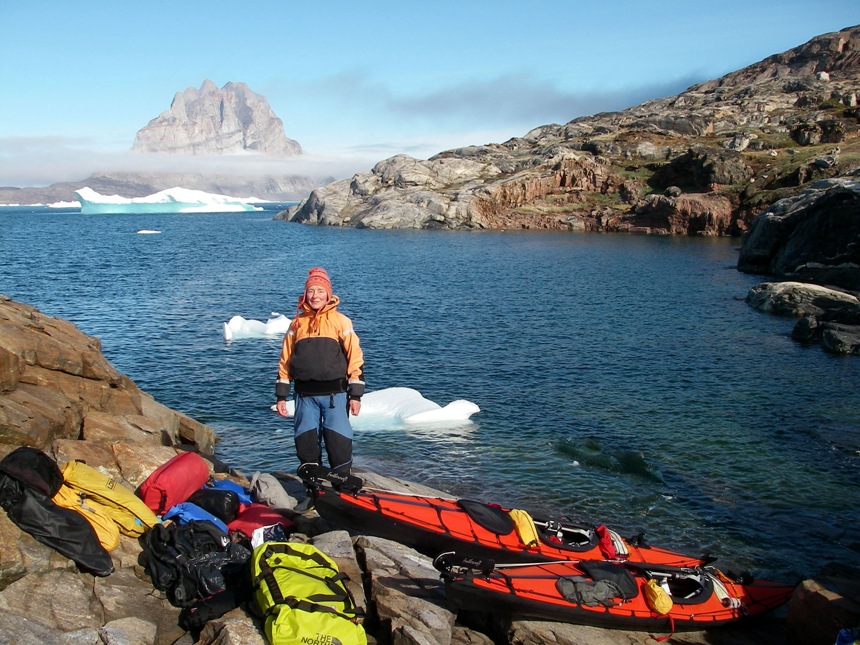
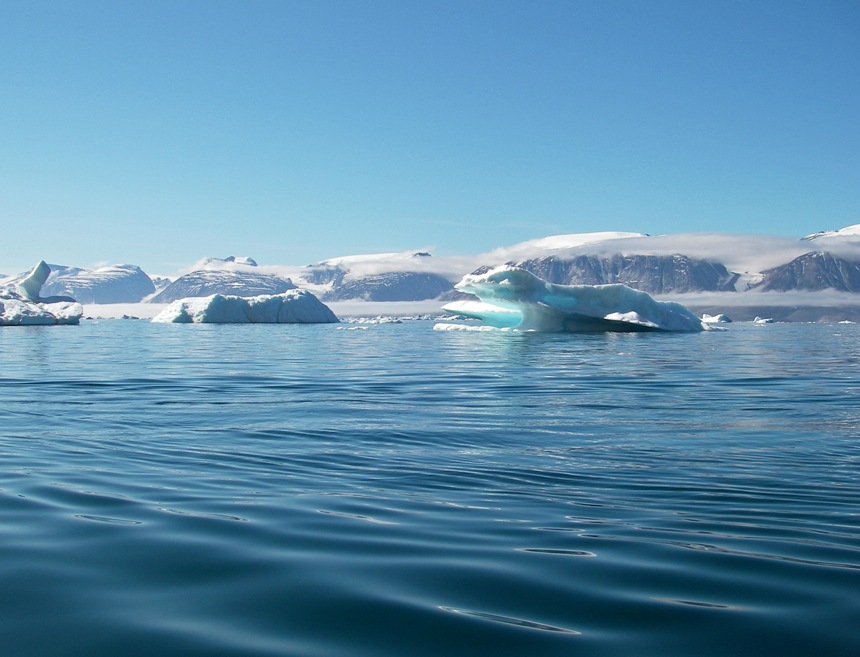
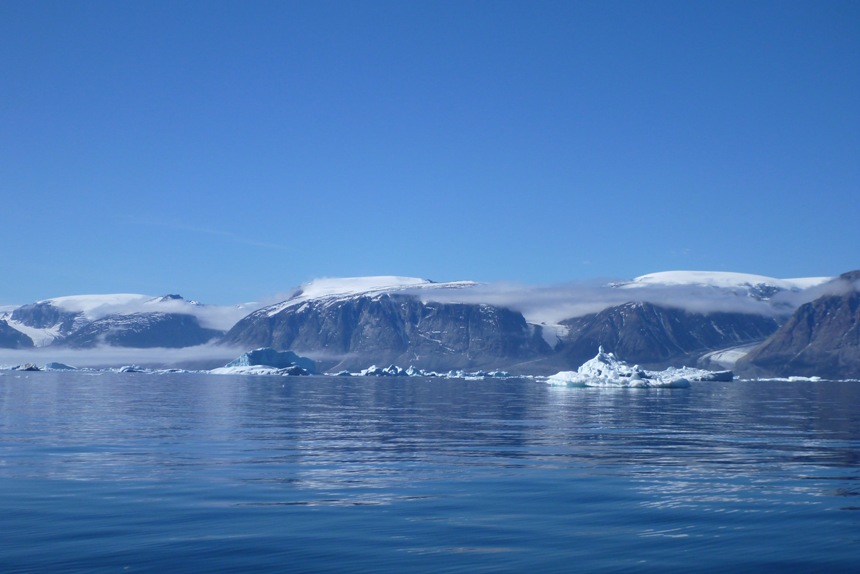
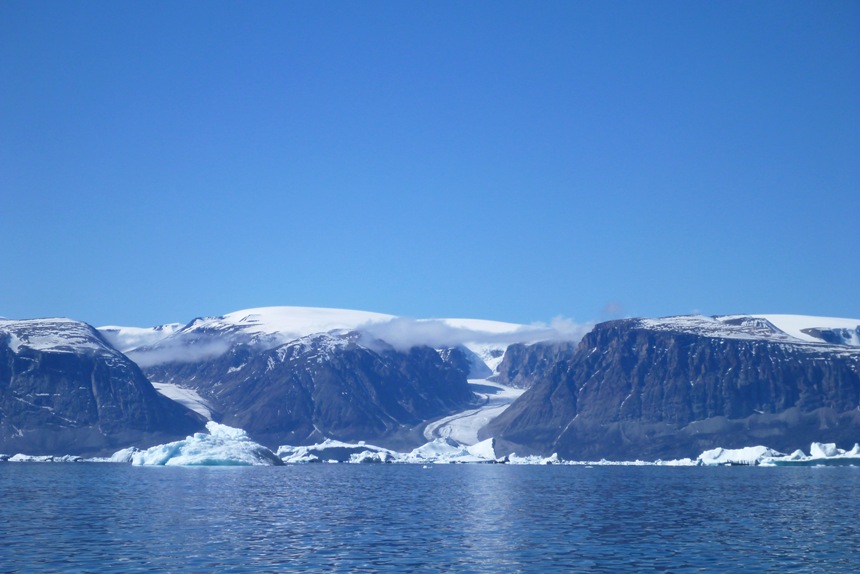
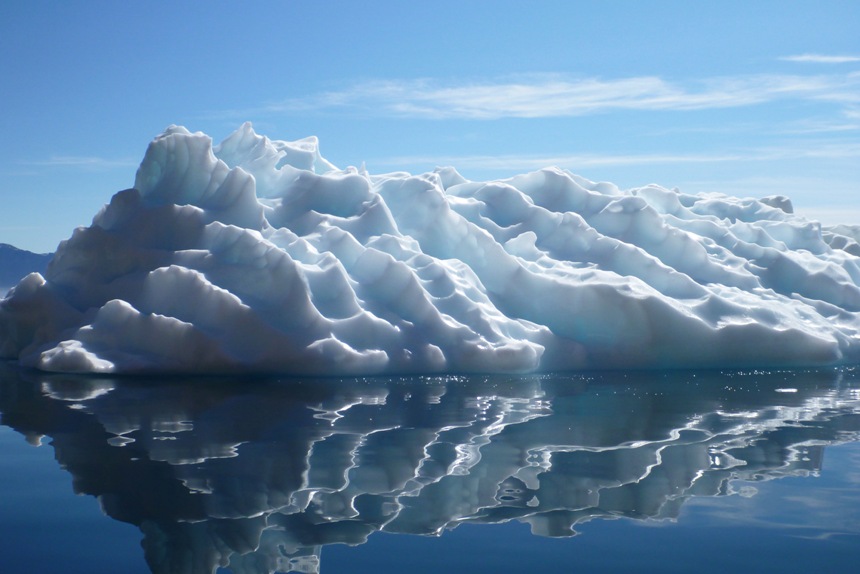
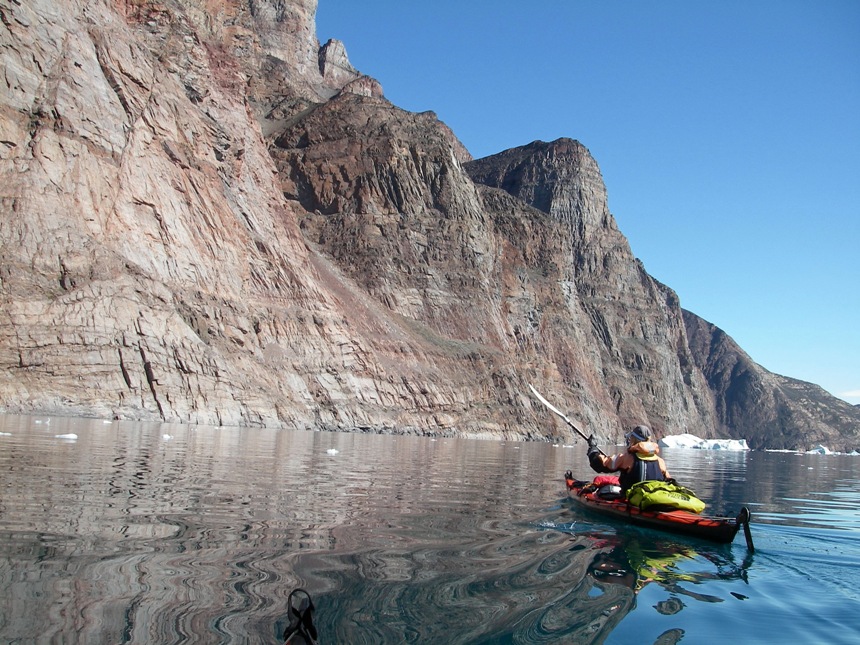
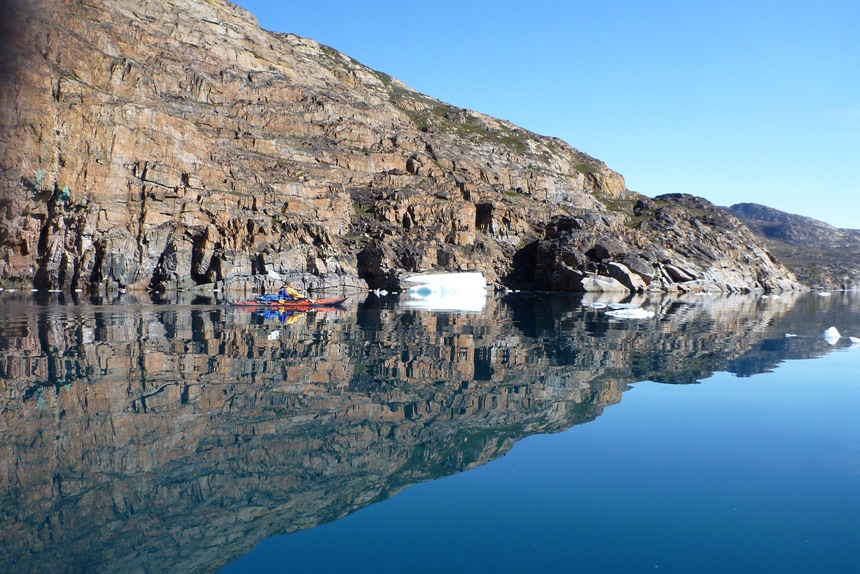

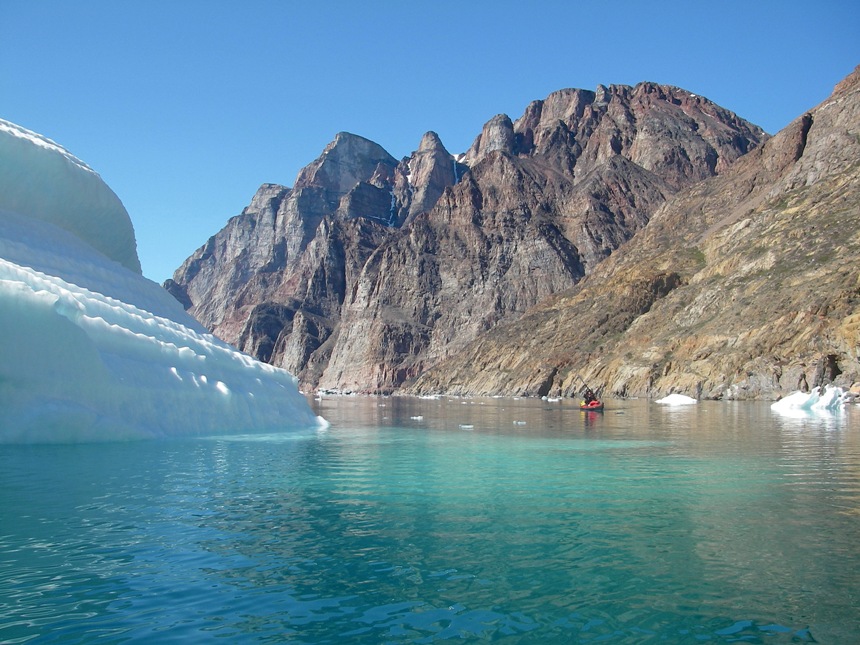
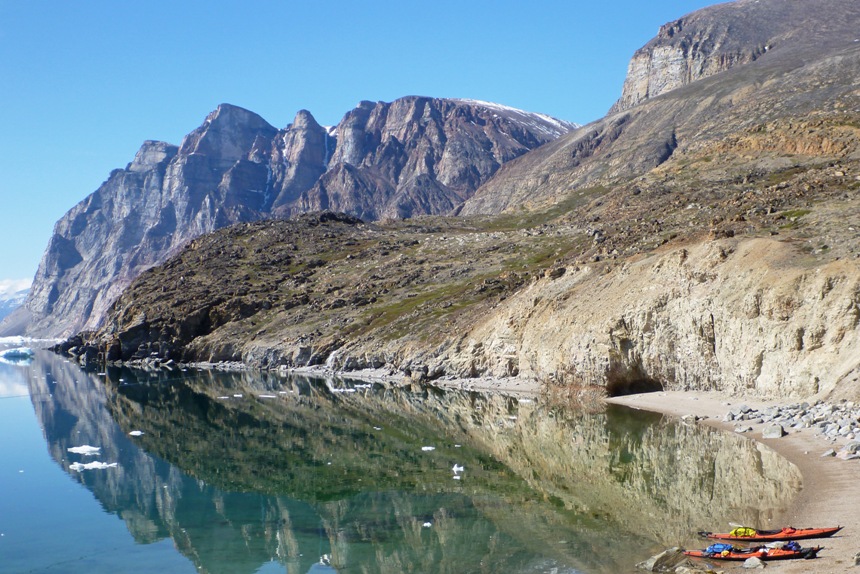
Tuperssuatsiait, Storøen
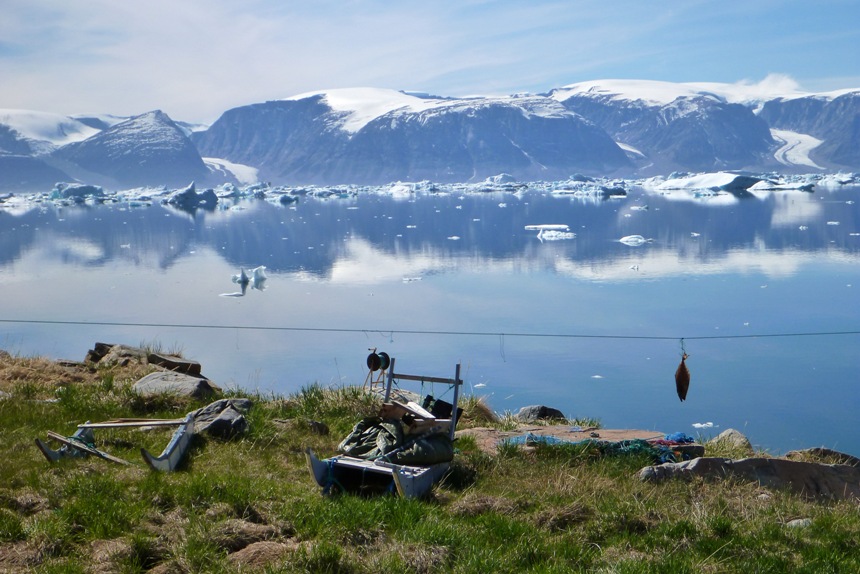
Sleds and halibut, Tuperssuatsiait, Storøen
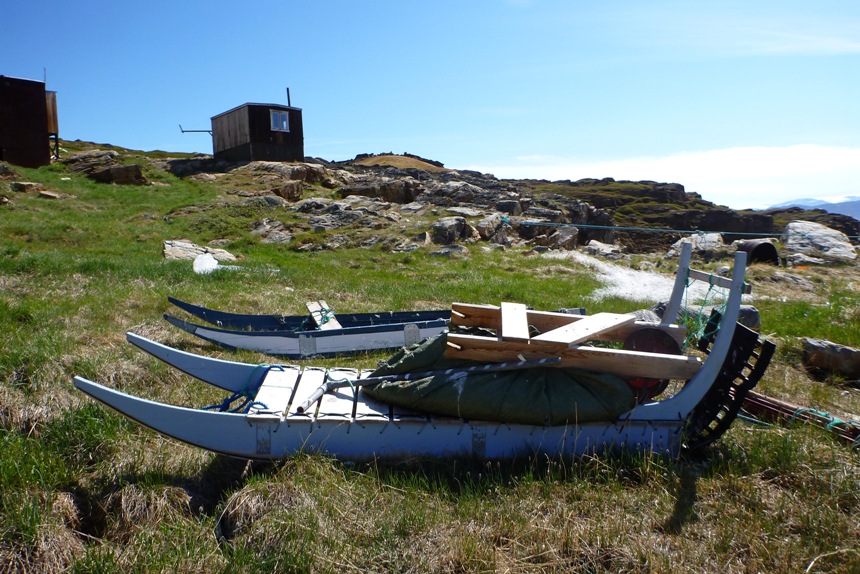
Sleds, Tuperssuatsiait, Storøen
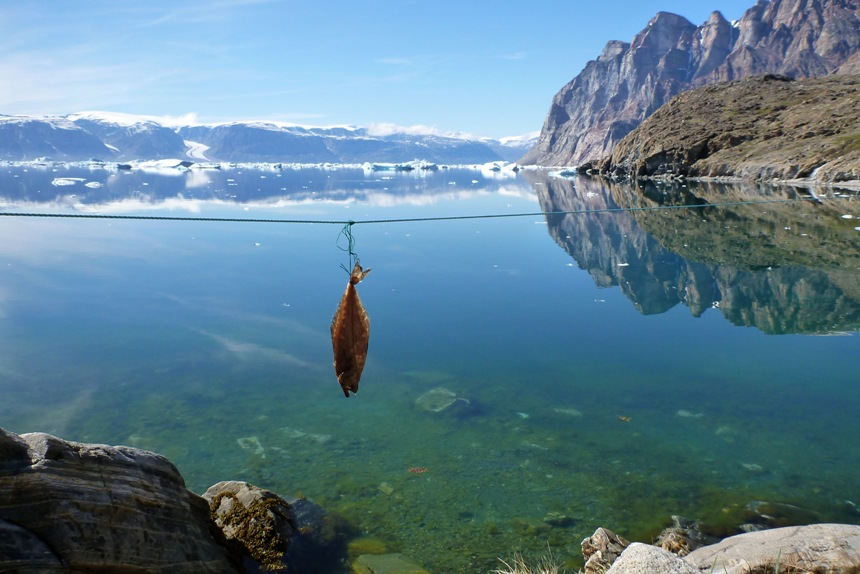
Tuperssuatsiait, Storøen

Tuperssuatsiait, Storøen
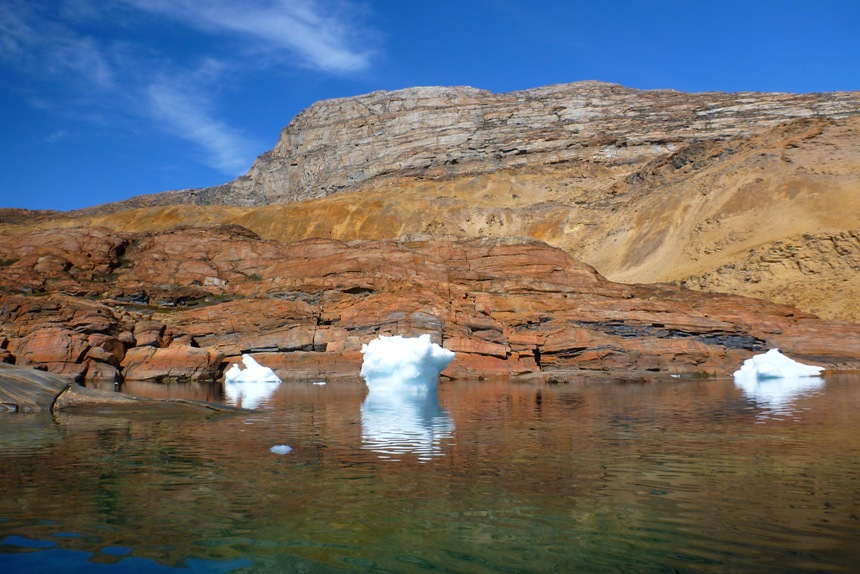
Akia, Storøen
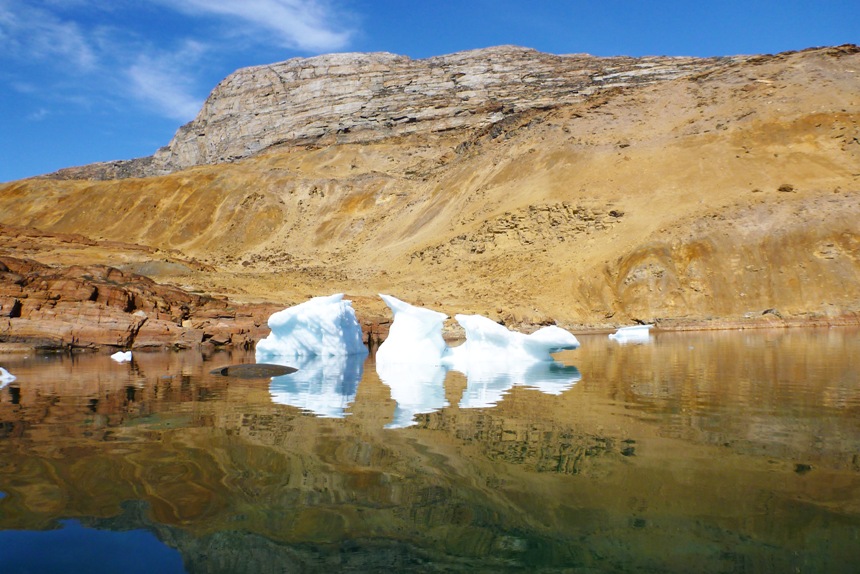

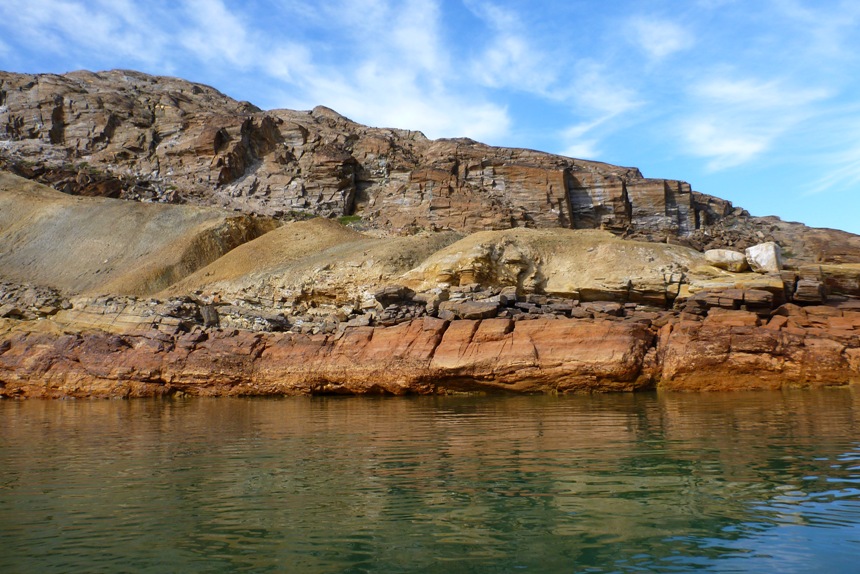
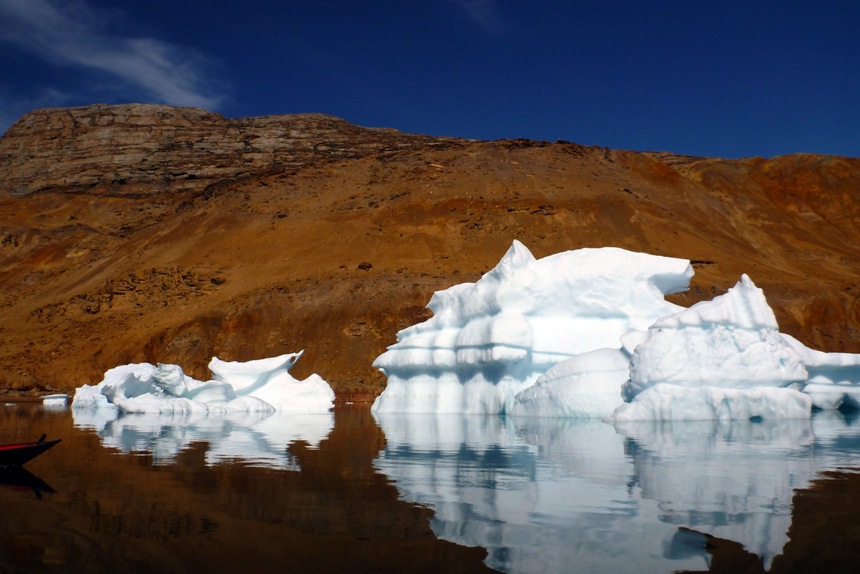
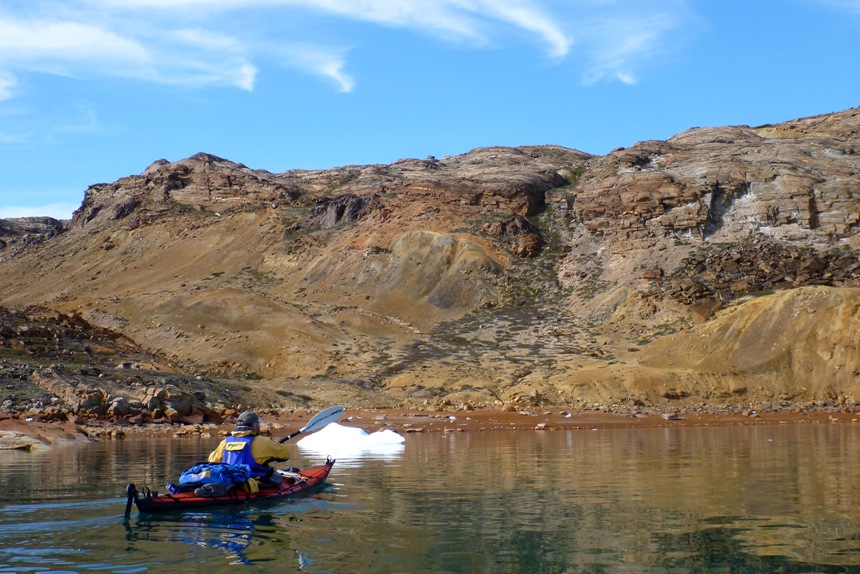
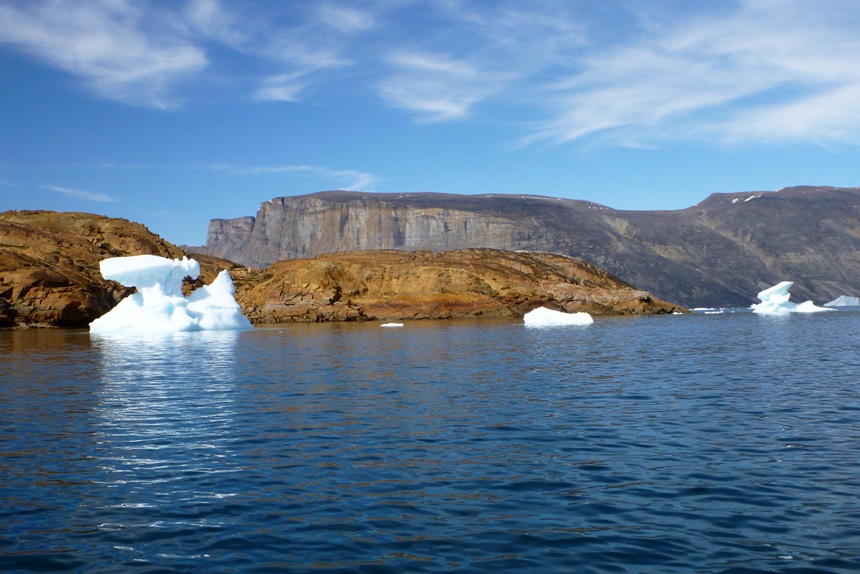
Cliffs at Ujarait, Qaqugdlugssuit from Akia, Storøen

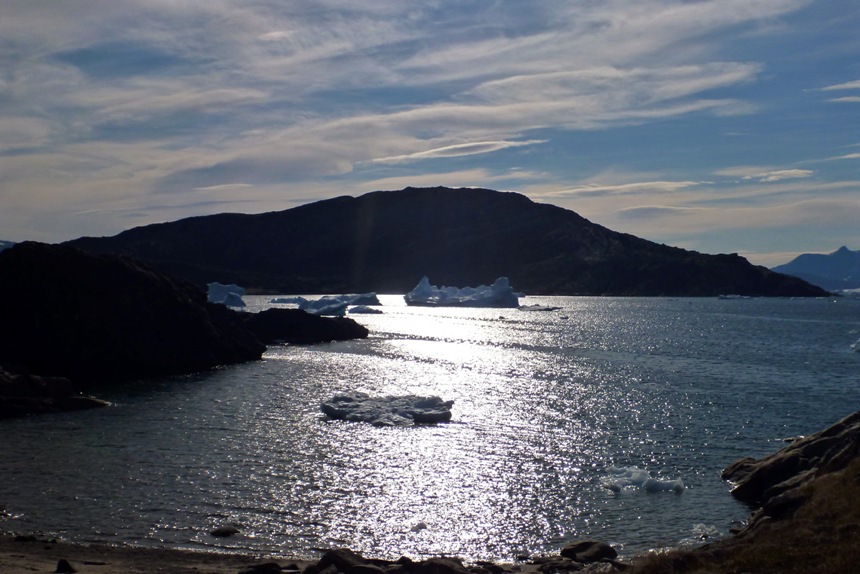
24 June 2013: Storøen to Akuliaruseq
Today we crossed from Stoøren to north of Akuliaruseq. We woke to altocumulus clouds (mackerel sky) and although the barometer dropped by 5mb yesterday over several hours, it rose by 2mb today. The forecast was for light wind, but it was a good strong 15 knots against us where we were planning to cross over (open crossing of 8km) so we sat tight until about 3pm when it became more calm. I’m a bit tentative now after our first day of paddling, after experiencing it blow up to an unpredicted wind of 25 knots. Today a north wind of 8m/s or 15knots was predicted in the evening but never came. North winds bring dense sea fog into the fjords and I wanted to be nearer to land if the fog and strong wind blew up. You could encounter a very large iceberg at speed in the dense fog and not know it until it’s right in front of you. It stayed calm all day (again not in the forecast), so I’m perplexed. The only indicators I can make out to remotely predict strong wind is the appearance of lenticular clouds over the ice cap for a southeast wind, for fog if it’s a north wind and for fjord wind, southeast. Otherwise, it’s the Danish weather website forecast which can’t always predict these local winds. So we’re in God’s hands to finish the trip safely! Our camping tonight is spectacularly scenic overlooking the fjord towards Uummannaq. It has a large patch of unmelted snow, flat spot for tent and large flat rocks to dry your clothes, and a dog’s skull. I’ve never experienced such a range of temperatures in one trip. The nights and mornings are very cold and can be damp while during the last two days it’s been absolutely baking. It’s been unseasonably hot 15 C (normal is 7-8C) which is not good because it contributes to katabatic winds and fog formation.
At this latitude of 70degrees north, the sun, with its burning intensity creates an ambient air temperature warmer that the actual air temperature, so 12 degC feels almost hot. The arctic light in the crystal clear atmosphere magnifies colours and gives the optical illusion of islands appearing considerably closer in distance than they actually are.
Stew found a dog skull (another sled dog?) and we crossed a patch of snow to get water from a stream. I collected some good-sized mussels and collected ice chunks for drinking water which melted in only a few hours making 8 litres of water. Sleeping is getting easier in the midnight sun even though I’m all bitten up by the mosquitoes and a bit sore and achy from sleeping on the hard ground. We watched a very large iceberg roll and it kept on tumbling and breaking up but did not cause much of a wave for us while we were on the water. We often hear the sound of distant fishing skiffs trolling for fish.
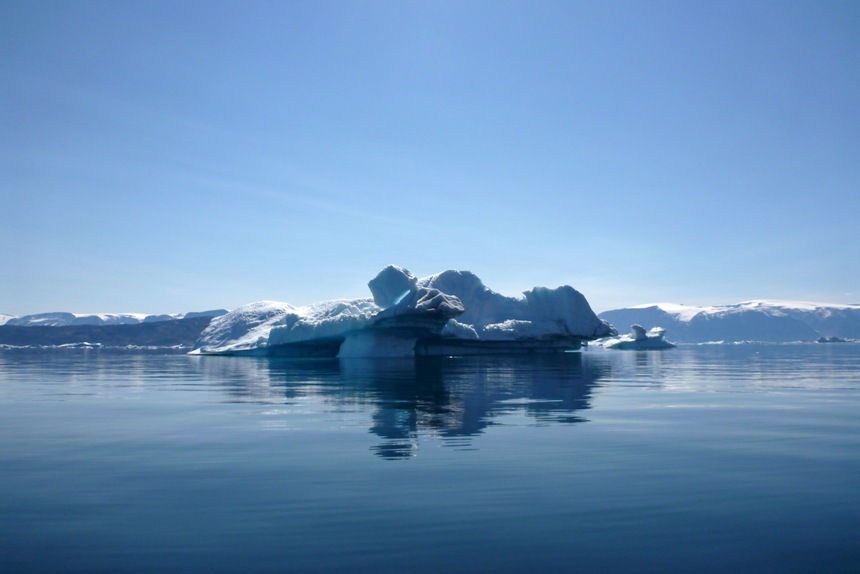
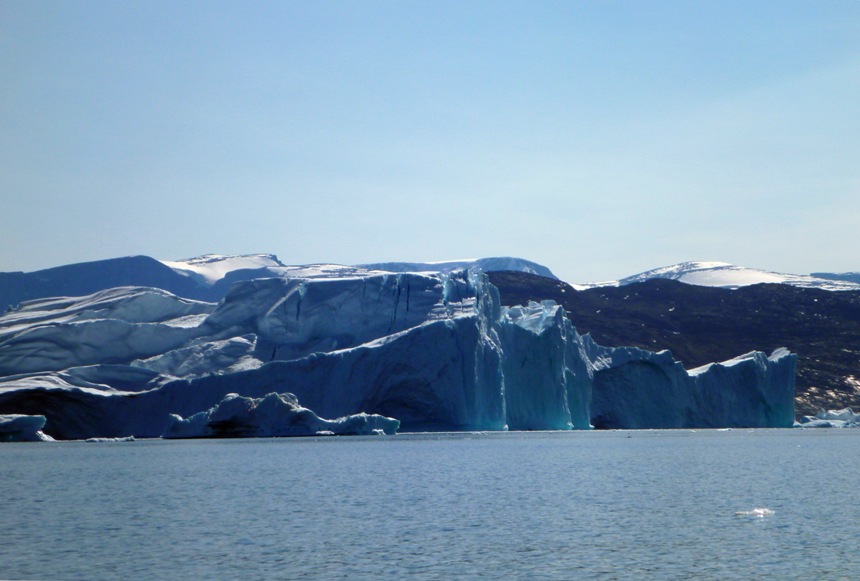
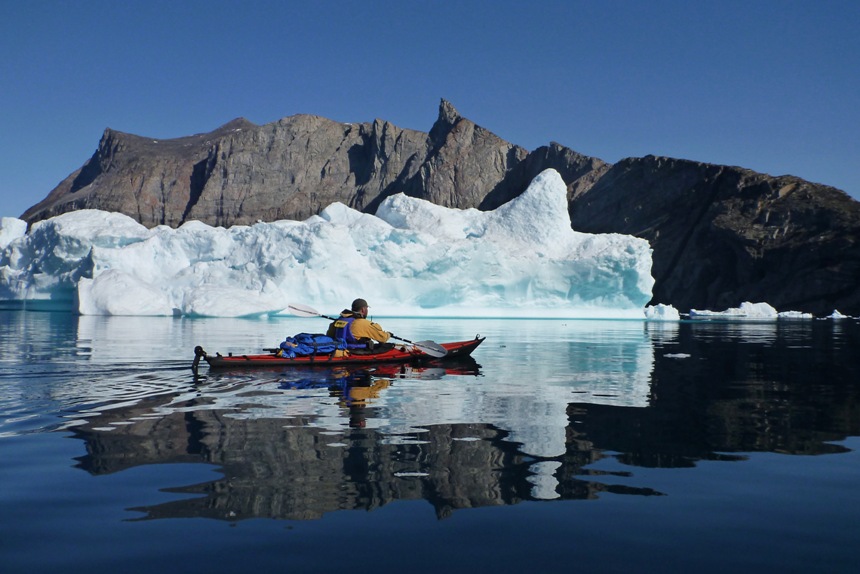
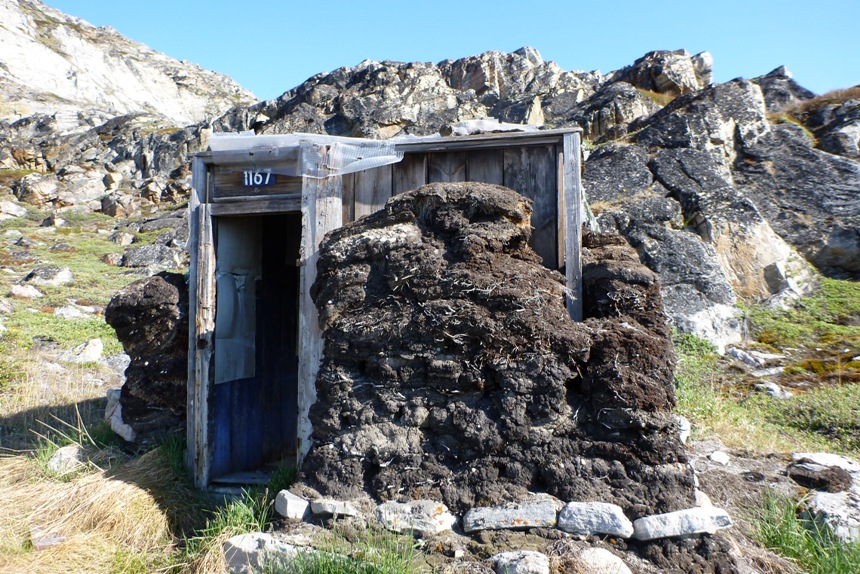
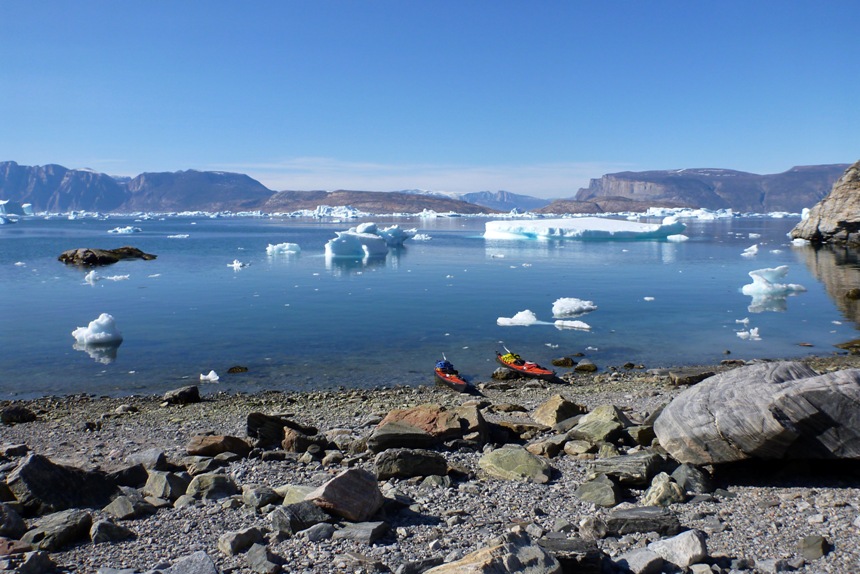
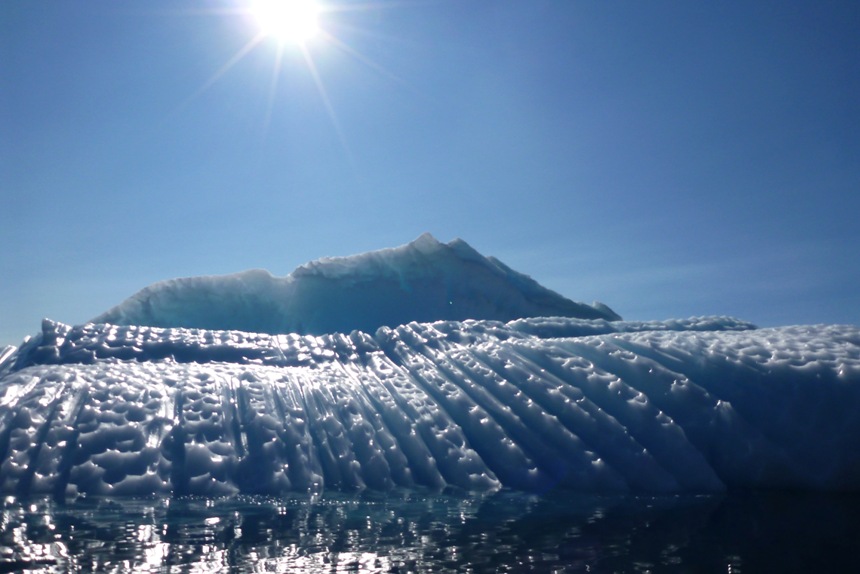
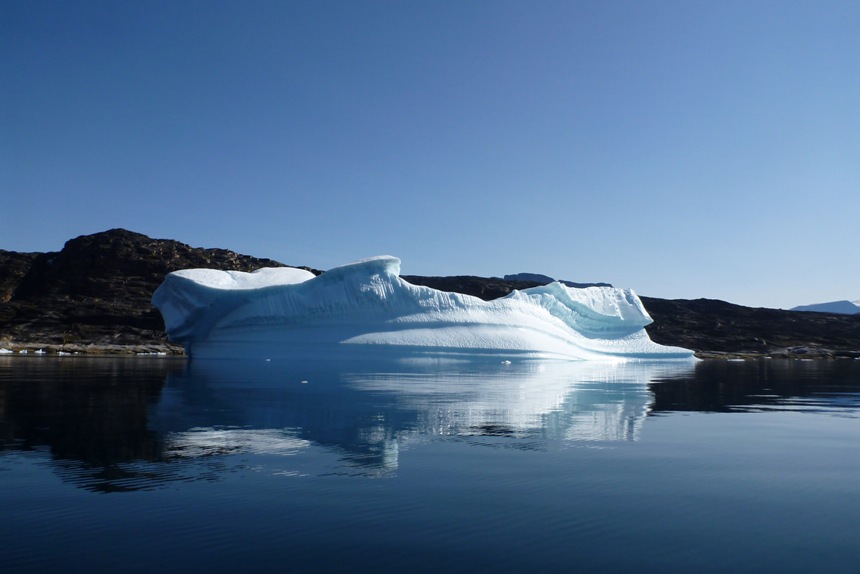
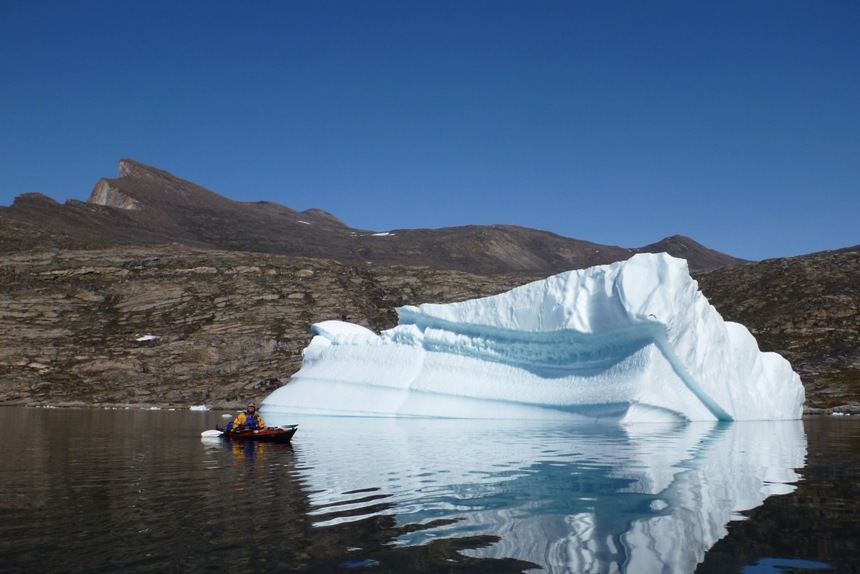
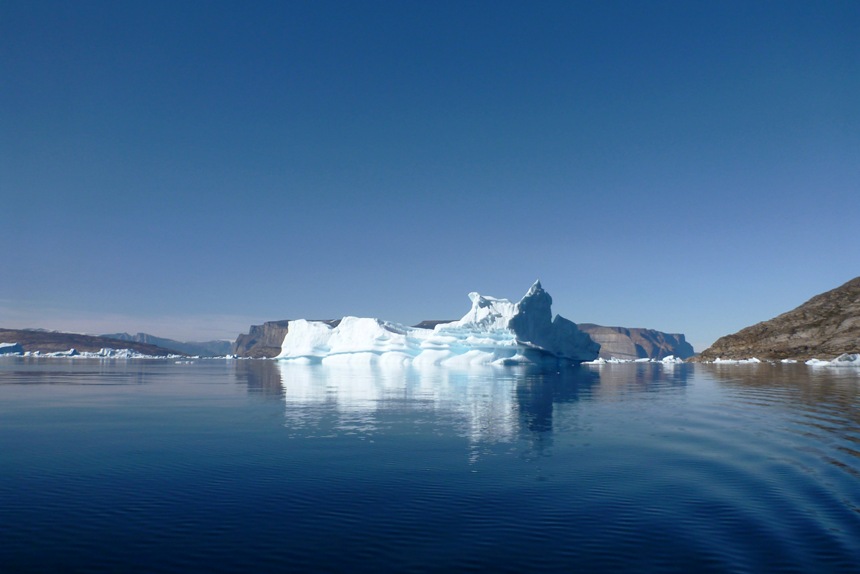
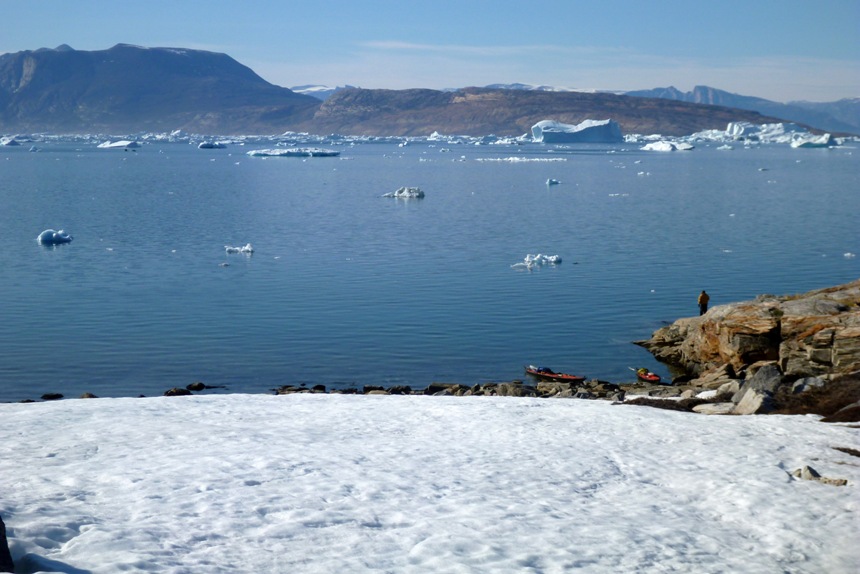

Akuliaruseq Camp
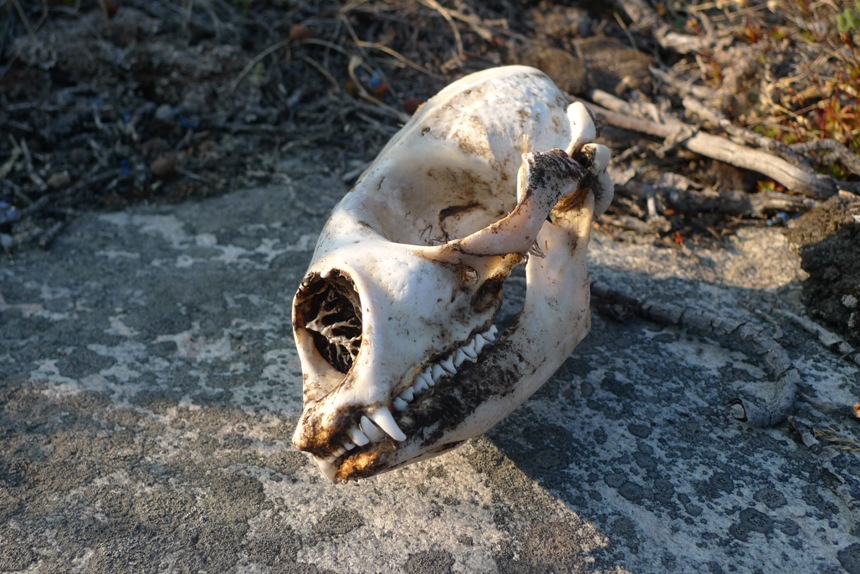
.
25 June 2013: North of Akuliaruseg to break at unnamed abandoned settlement to Igdlukavsak (across from Ikerasak).
It was nice to kayak along a bit of coastline that was greener and had frequent landing places. We got on the water later than I had hoped and were forced off the water after only an hour and a half by strong katabatic winds (>10m/s or low to mid 20’s knots) that were again coming off the ice cap. After continuing until we were no longer making forward progress, we got off the water at an abandoned settlement in a small plateau surrounded by crags filled with pink saxifrage. One could imagine living here watching the changing seasons of ice and snow, fjord freezing and melting, icebergs exploding as you sewed and repaired kamiks (boots), anoraks, caribou trousers, collected snow to melt for drinking water, cut up meat to feed your dogs, scraped and chewed skins, cut up blubber for the lamps or hung fish to dry.
We found some very old burial cairns or crypts made from stone slabs. These crypts were small, typically only a couple of feet across. They were insubstantial structures with gaps between the stones. Once we noticed them, it became apparent that there was a great many ruinous crypts scattered amongst the small crags and flowers. One did however appear more complete than the others, albeit still with large gaps between the stones. Stew lifted one of the stones on top and I saw what I thought was a human femur. I stooped to look in further and gasped when I saw a human skull. I exclaimed to Stew, “Put the stone back on top. I don’t want to desecrate this grave! Wait, let me get a picture first!” I know. That was bad.
Death and Endless Life
“Heaven is a great country with many holes in. These holes we call the stars. Many people live there, and whenever they upset anything, it falls down through the stars in the form of rain or snow. Up in the land of heaven live the souls of dead men and beasts, under the Lord of Heaven, Taspasum Inua.
“The souls of men and beasts are brought down to earth by the moon. This is done when the moon is not to be seen in the sky; it is then on its way to earth, bringing souls. After death, we do not always remain as we were during life; the souls of men, for instance, may turn into all kinds of animals. Pinga looks after the souls of animals, and does not like to see too many of them killed. Nothing is lost; and blood and entrails must be covered up after a caribou has been killed.
“So we see that life is endless; only we do not know in what form we shall reappear after death.”
From Knud Rasmussen’s “Across Arctic America”, 1927
After a few hours of relaxing in the sun, the wind eased quite a bit although the narrow bit of the fjord looked as if it was choked with ice. We headed out onto the water for the next abandoned settlement of Igdludavasak. It was a brilliantly sunny early evening and what a beautiful site we encountered. This was a different fjord named Qarajaqs Isfjord) that continued southeast to Store Gletscher. I was hoping we could get closer to this fast moving glacier that was producing all this ice, but there was just too much of it and we’d have to weave between some very, very large icebergs with bits calving off and creating big waves or whole bergs rolling and all the dangers that presents to us. This glacier spills down from the ice cap churning out massive iceberg blocks at a rate greater than any other in Greenland. (Ilulissat isfjord is the largest and produces more icebergs but at a slower rate.) But what a beautiful, beautiful sight! High snow-covered mountains with glacial tongues like icy highways meandering down to a mirror sea. Just two weeks ago this entire area was solidly frozen according to the Danish Meteorological Institute (DMI) website and the day before we left it was 9/10 frozen.
To the west was Ikerasak village at the base of the 460 metre mountain Ikerasak, and to the southeast, the rocky, barren peninsula of Akuliaruserssuag on which was another cluster of abandoned dwellings. There was far too much ice to go further south or even towards Talerua so we have to retrace the way we came.
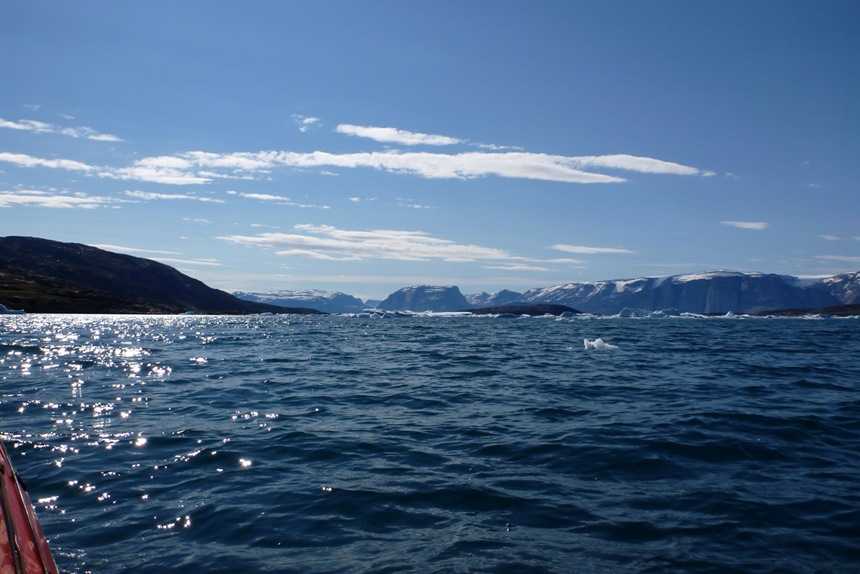
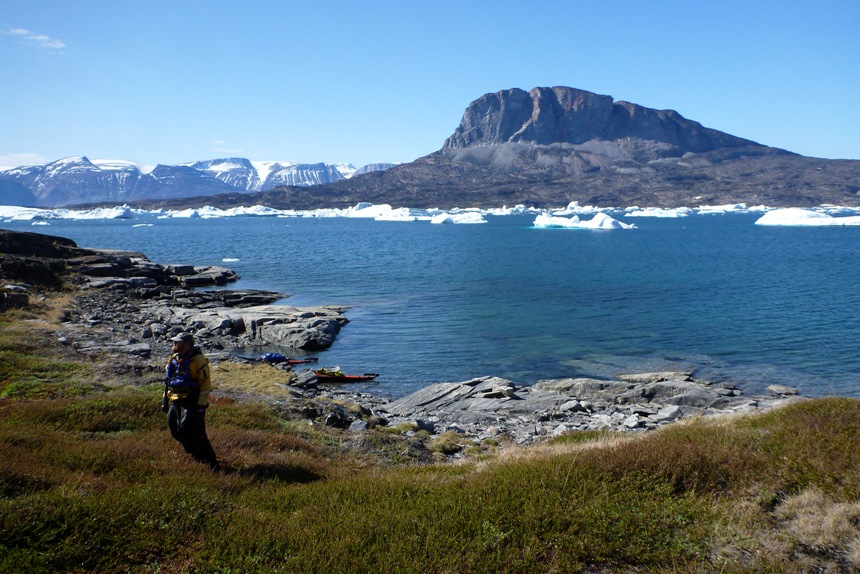
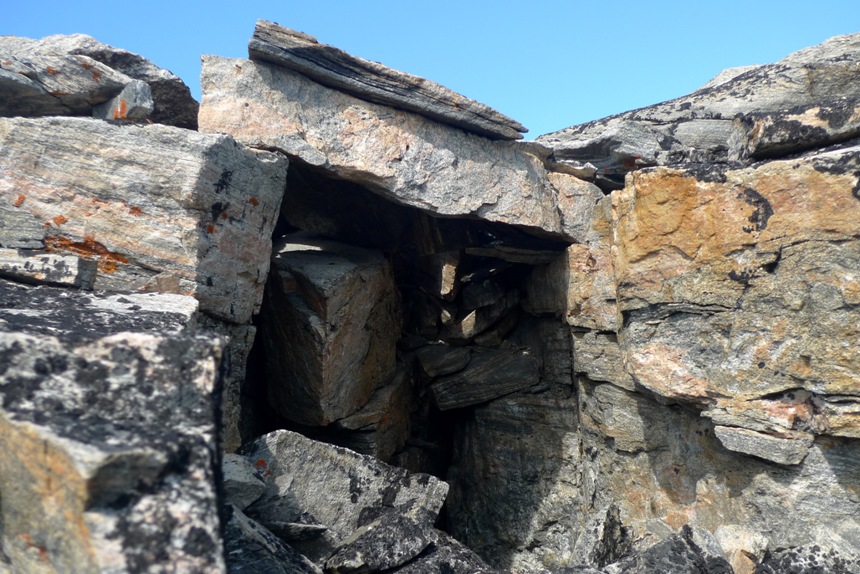
Crypt

Crypt
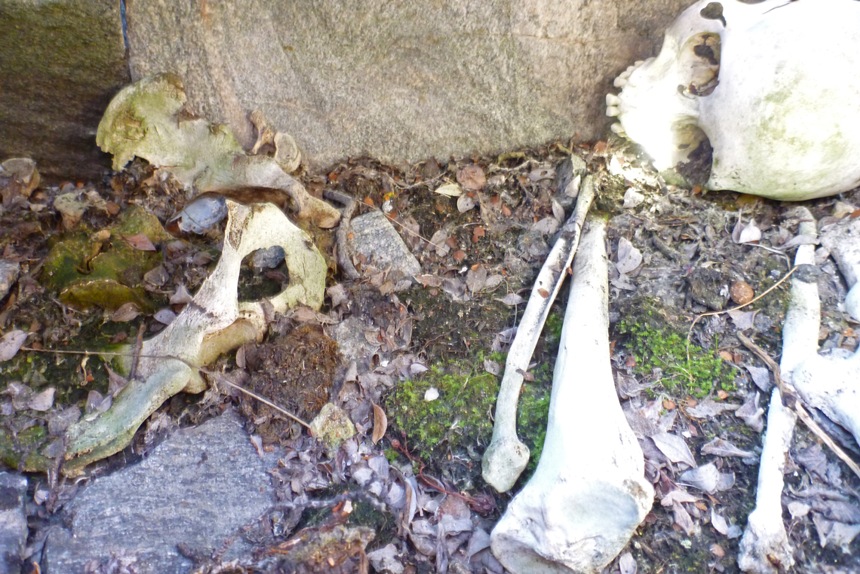
Death and Endless Life
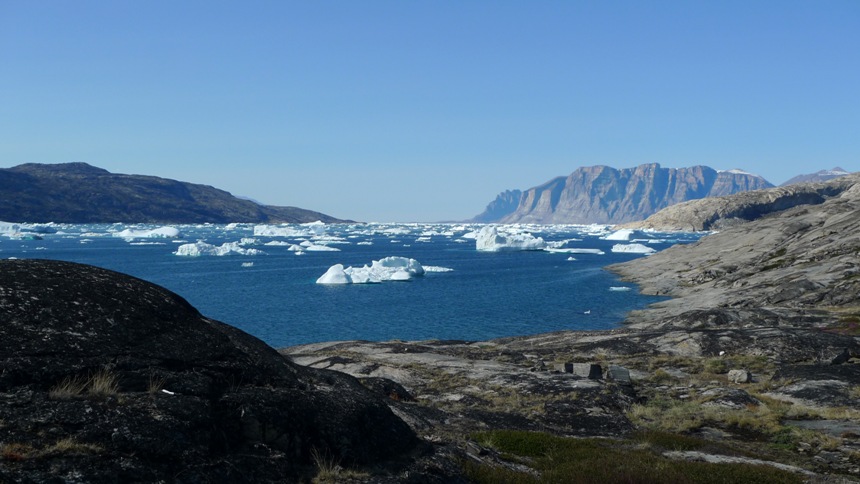
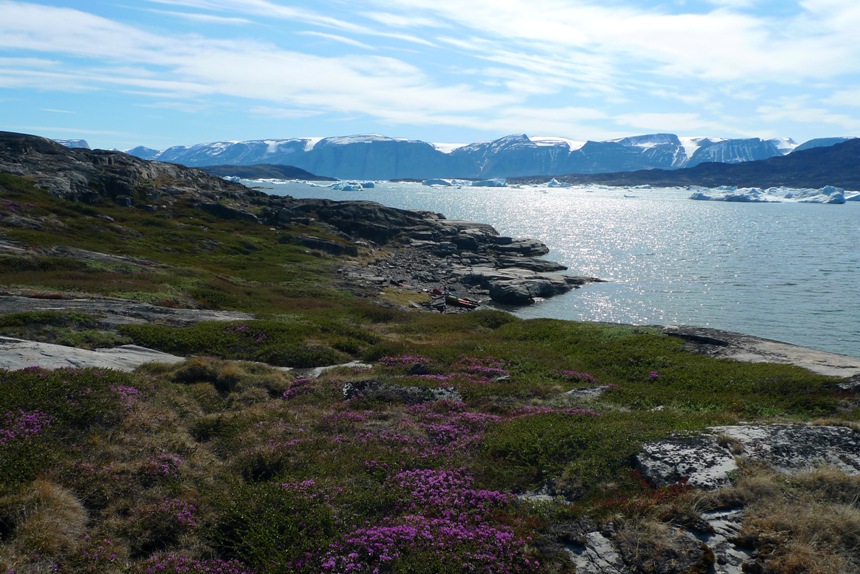
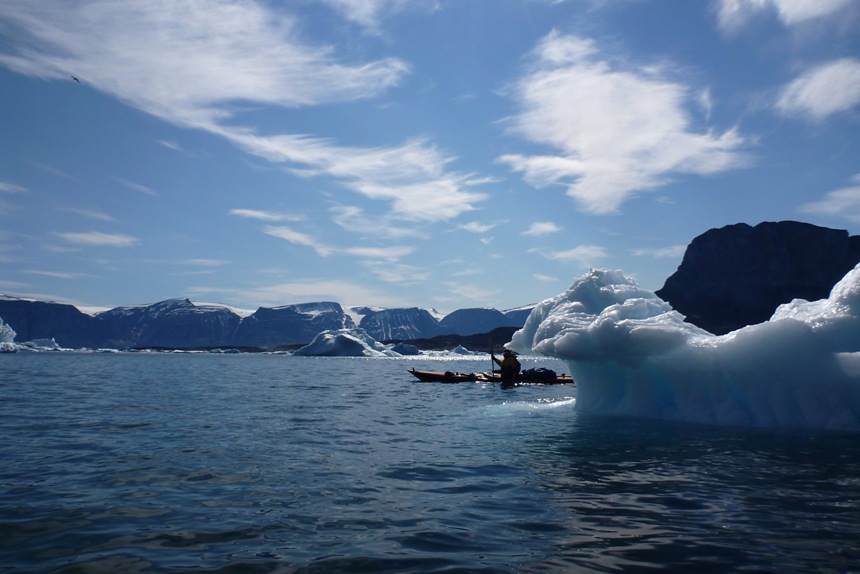
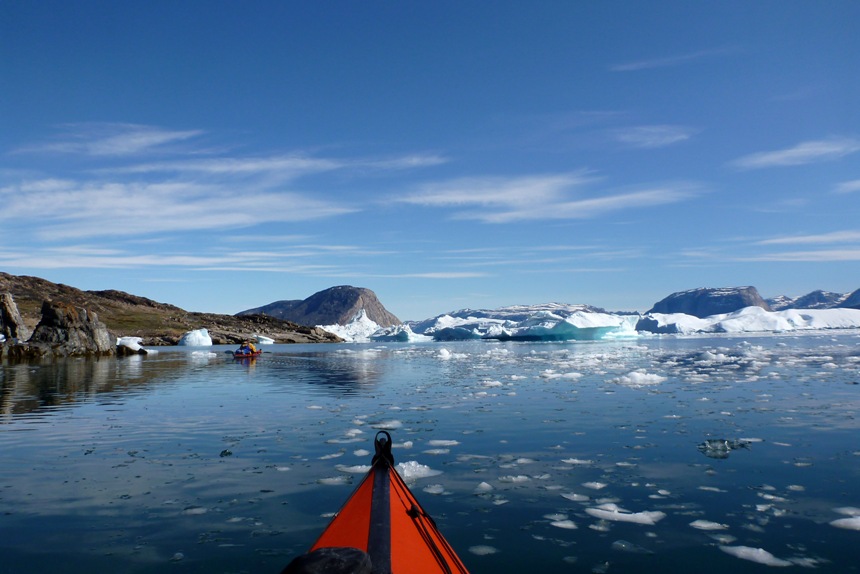
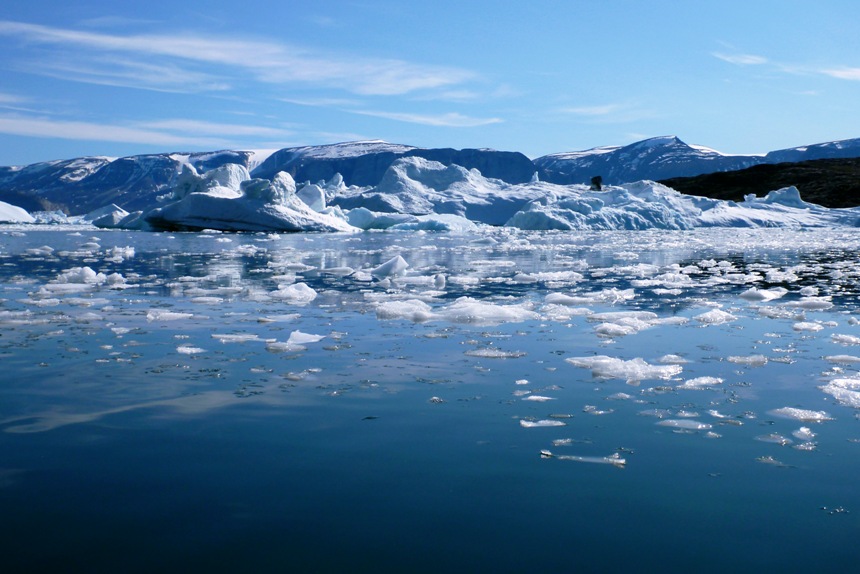

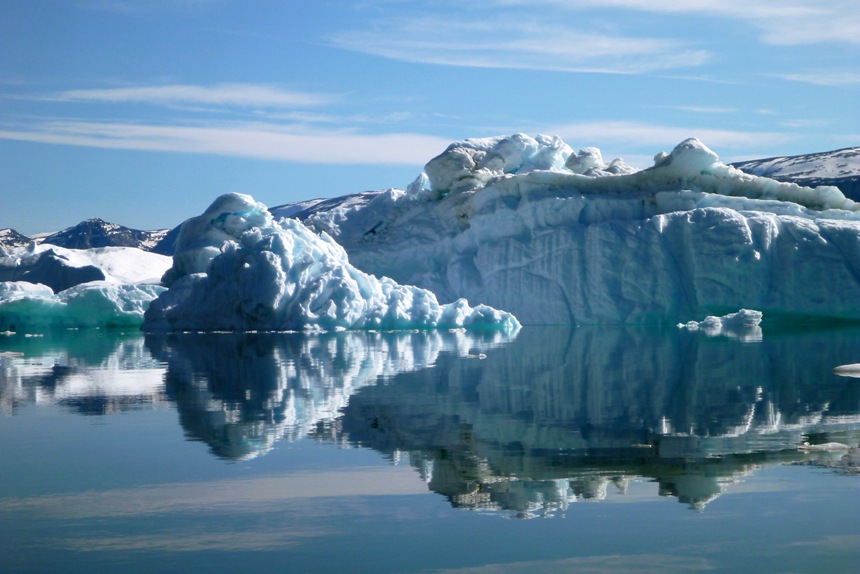
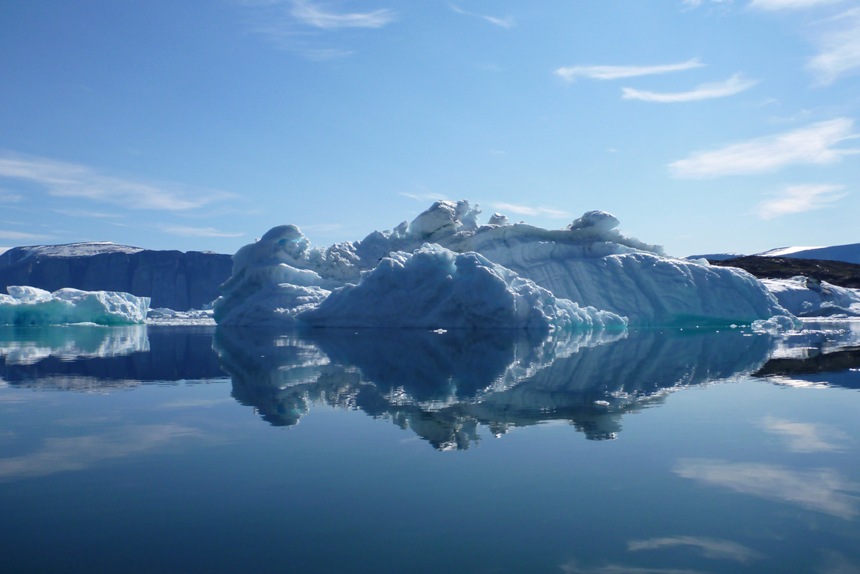
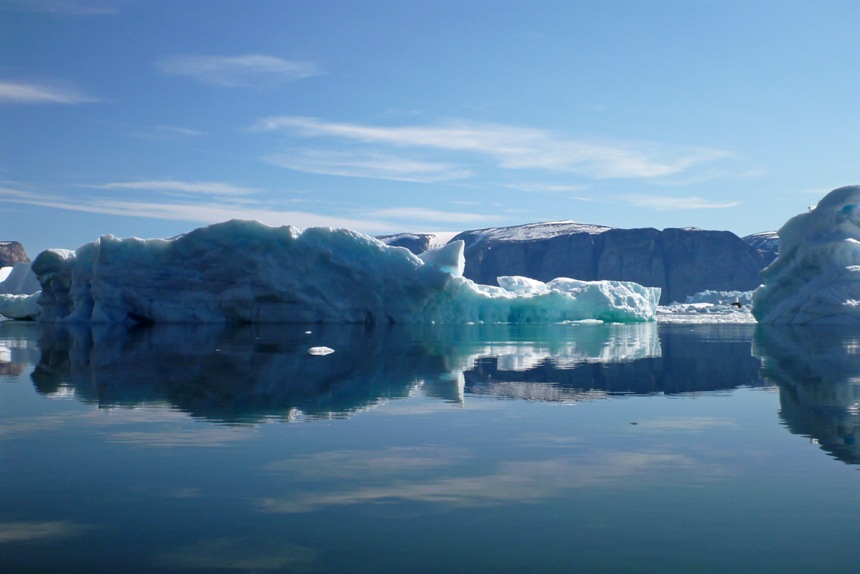
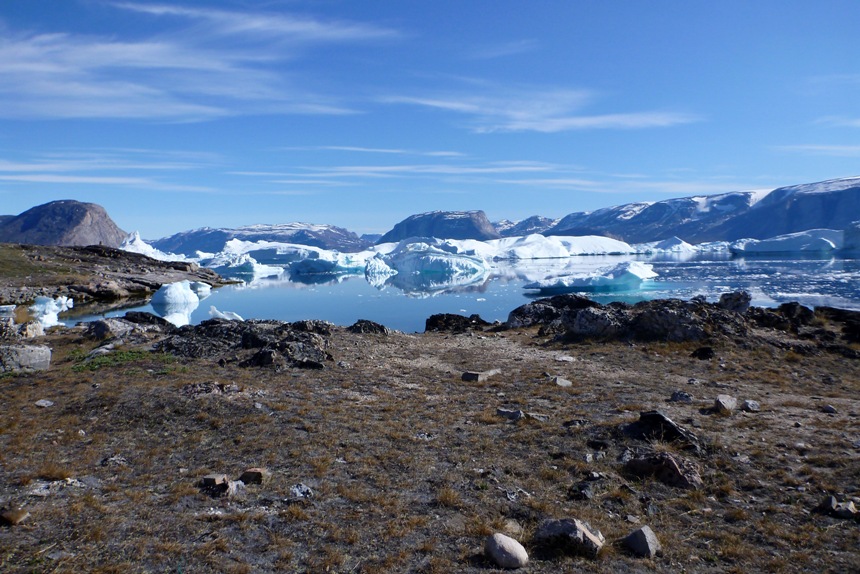
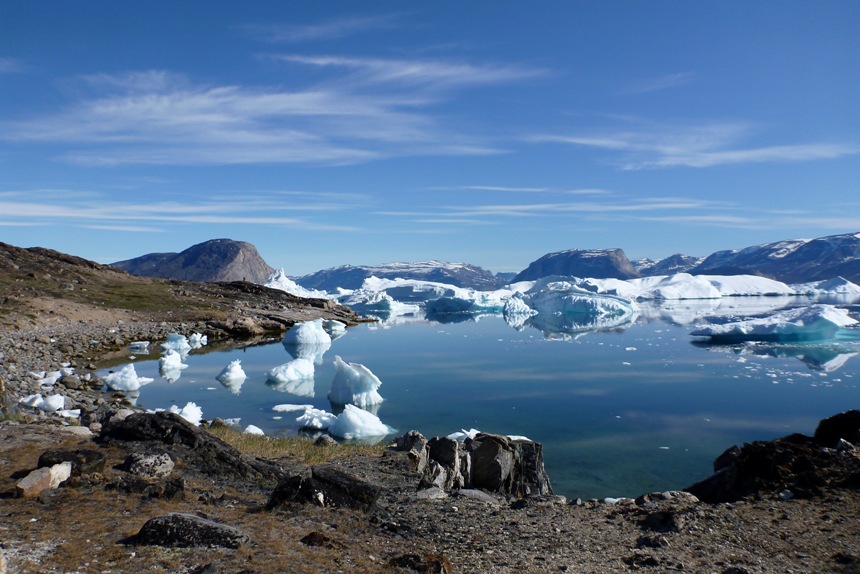
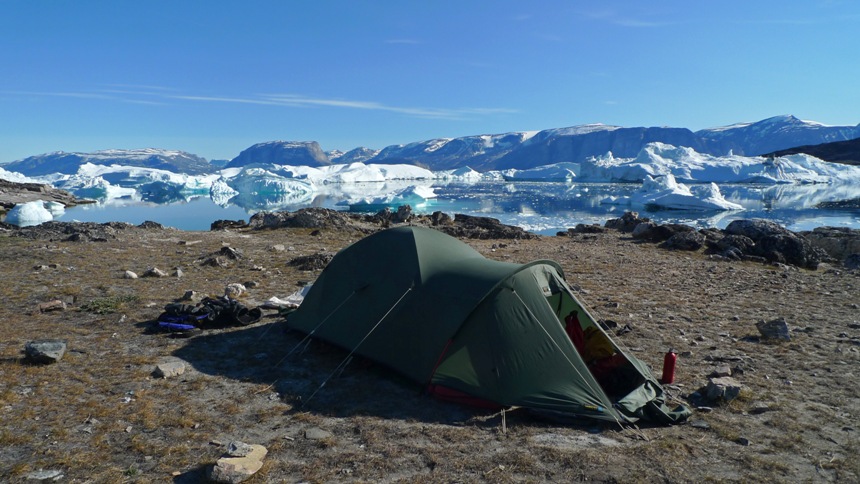
Igdlukavsak Camp
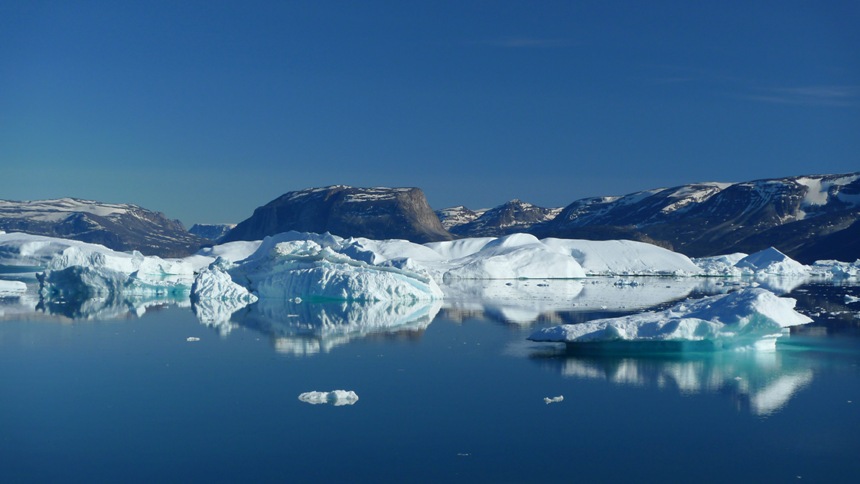
Akuliaruserssuaq from Igdlukavsak
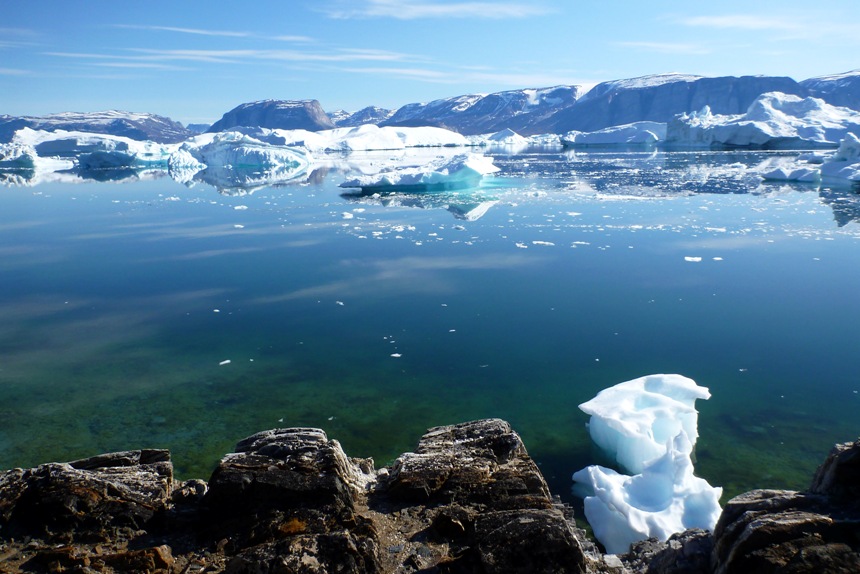
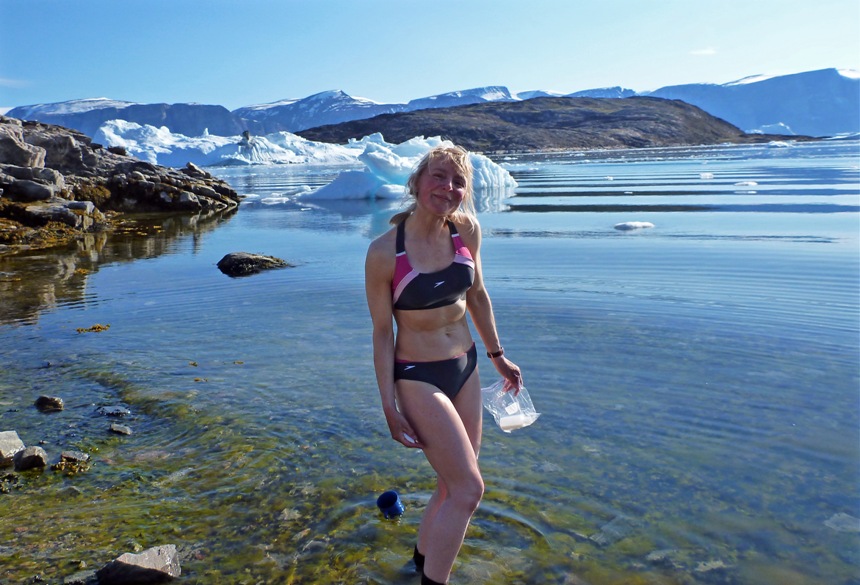
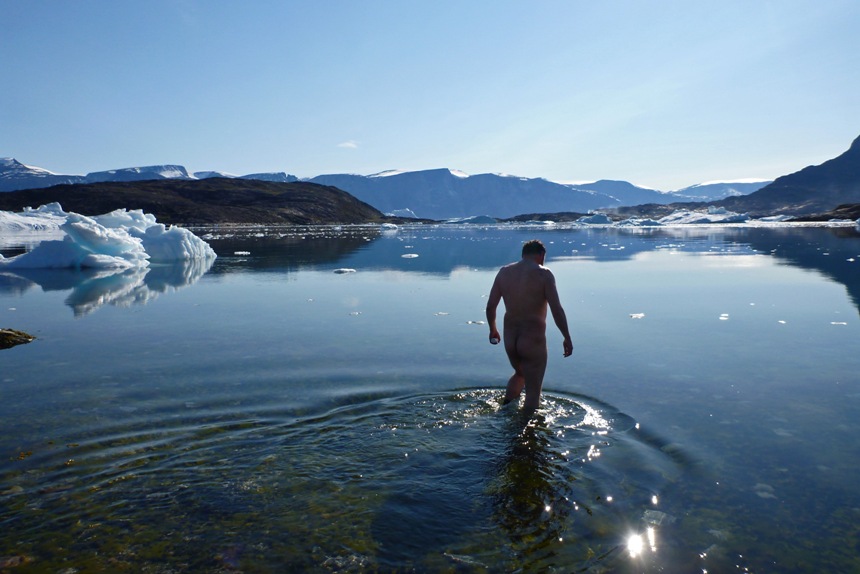
Knud Stewart
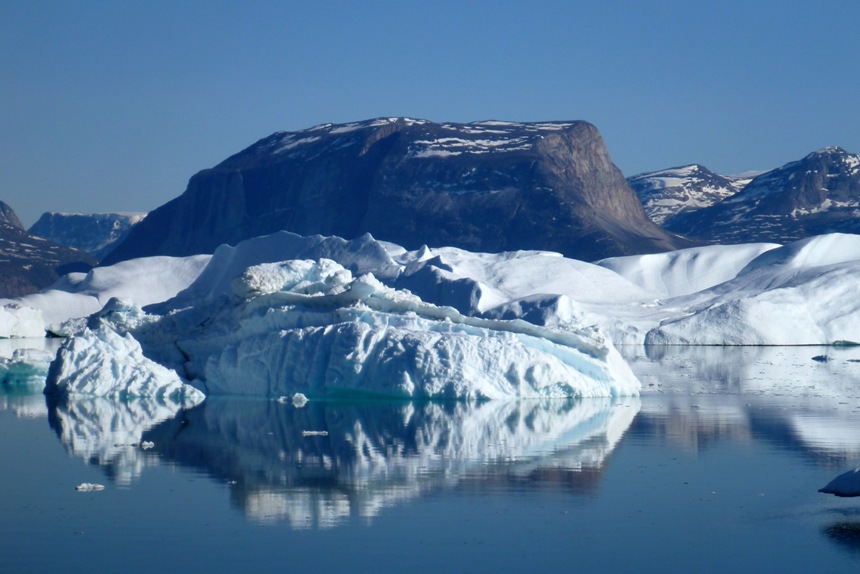
Akuliaruserssuaq
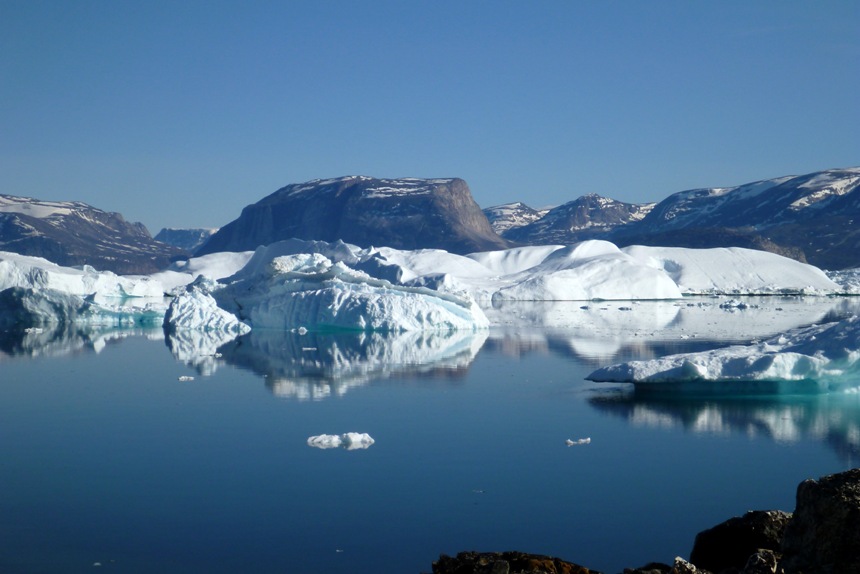

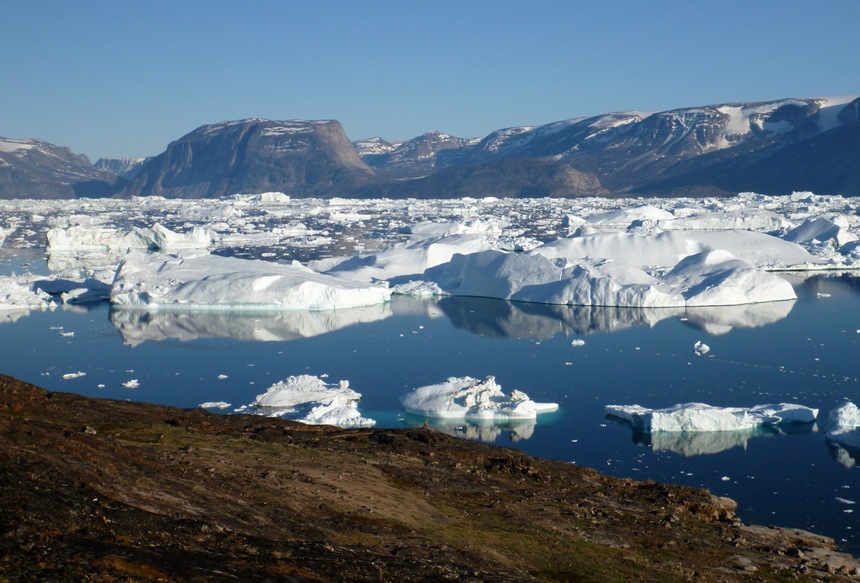
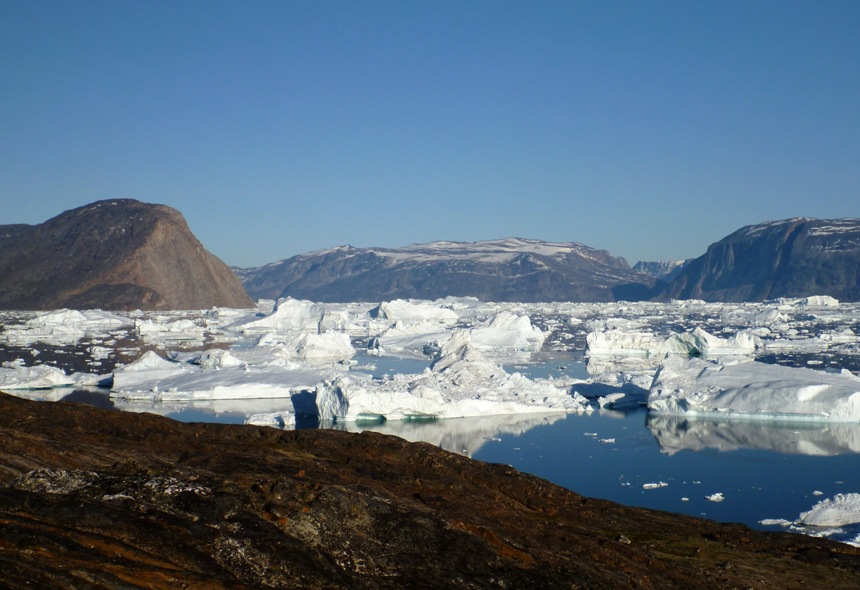
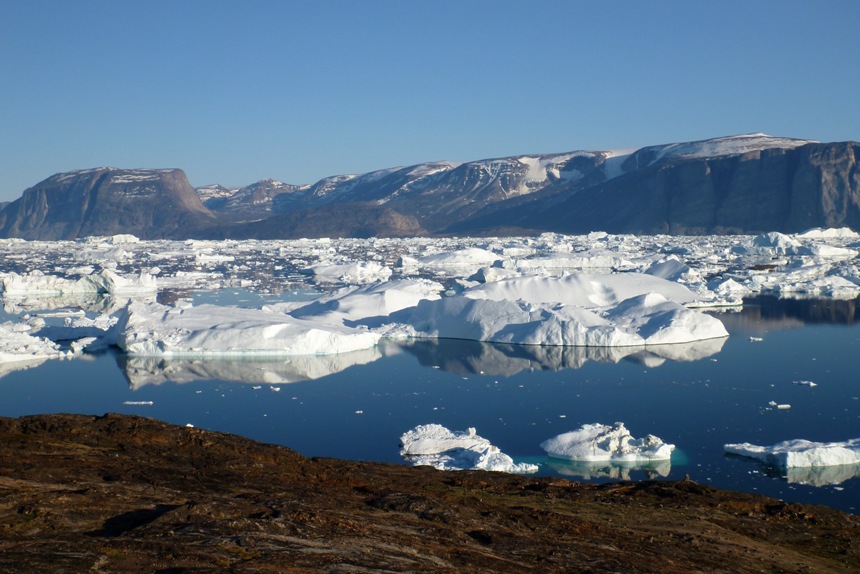
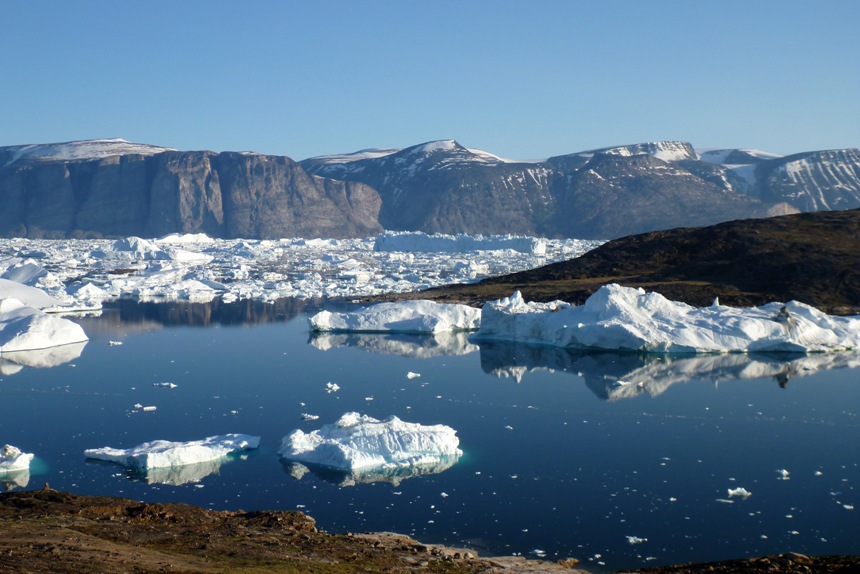
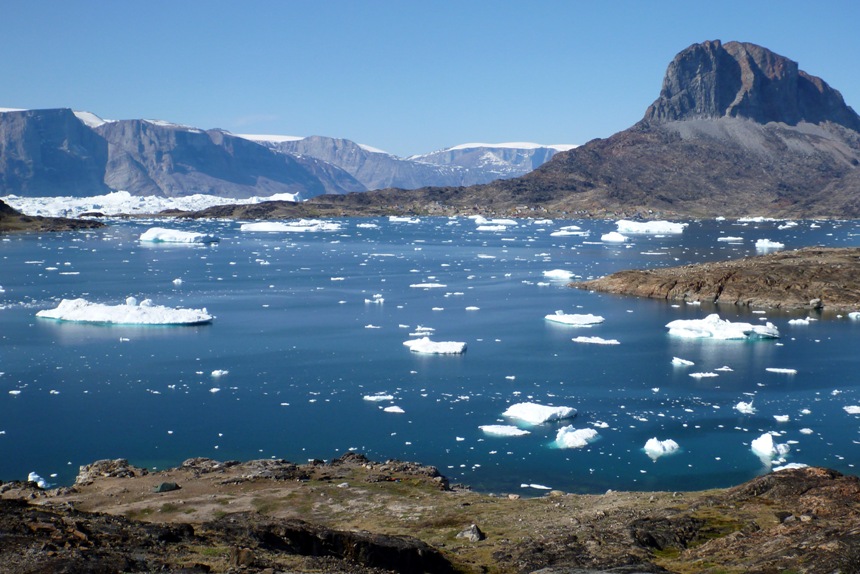
26 June 2013: Day Hike up Qaersuorssuaq
I woke briefly at 2.30am and it was so bright I thought it was morning! It was such a lovely, scenic spot that I wanted to stay an extra day and hike up Qaersuorssuaq (470m) to get views over towards Talerua island to get an idea if it was at all possible to kayak in that area. It looked worse than we had hoped and I was a bit disappointed that we wouldn’t be going between Nussuaq Peninsula and Talerua. We spent 6-7 hours walking up easy gneiss and granite slabs and had more truly breathtaking views than I could imagine. The descent chosen by Stew was a “shortcut” straight down what must have been the steepest, most bouldery, heathery, ankle-cracking gully on the mountain. To say I was not happy during our descent was an understatement. While marital harmony can at times come under strain on our trips, hopefully it will never come to this:
Imarasugssuaq, Who Ate His Wives
It is said that the great Imarasugsuaq was wont to eat his wives. He fattened them up, giving them nothing but salmon to eat, and nothing at all to drink. Once when he had just lost his wife in the usual way, he took to wife the sister of many brothers, and her name was Misana. And after having taken her to wife, he began fattening her up as usual.
One day her husband was out in his kayak. And she had grown so fat that she could hardly move, but now she managed with difficulty to tumble down from the bench to the floor, crawled to the entrance, dropped down into the passage way, and began licking the snow which had drifted in. She licked and licked at it, and at last she began to feel herself lighter, and better able to move. And in this way she afterwards went out and licked up snow whenever her husband was out in his kayak, and at last she was once more quite able to move about.
One day when her husband was out in his kayak as usual, she took her breeches and tunic, and stuffed them out until the thing looked like a real human being, and then she said to them:
“When my husband comes and tells you to come out, answer him with these words: I cannot move because I am grown so fat. And when he then comes in and harpoons you, remember then to shriek as if in pain.”
And after she had said these words, she began digging a hole at the back of the house, and when it was big enough, she crept in.
“Bring up the birds I have caught,” said Imarasugssuaq. But the dummy answered, “I can no longer move, for I am grown so fat.”
Now the dummy was sitting behind the lamp. And the husband coming in, harpooned that dummy wife with his great bird-spear. And the thing shrieked as if with pain and fell down. But when he looked closer, there was no blood to be seen, nothing but some stuffed-out clothes. And where was his wife?
And now he began to search for her, and as soon as he had gone out, she crept forth from her hiding-place, and took to flight. And while she was thus making her escape, her husband came after her, and seeing that he came nearer and nearer, at last she said: “Now I remember, my amulet is a piece of wood.”
And hardly had she said these words, when she was changed into a piece of wood, and her husband could not find her. He looked about as hard as ever he could, but could see nothing beyond a piece of wood anywhere. And he stabbed at that once or twice with his knife, but she felt no more than a little stinging pain. Then he went back home to fetch his axe, and then, as soon as he was out of sight, she changed back into a woman again and fled away to her brothers.
When she came to their house, she hid herself behind the skin hangings, and after she had placed herself there, her husband was heard approaching, weeping because he had lost his wife. He stayed there with them, and in the evening, the brothers began singing songs in mockery of him, and turning towards him also, they said:
“Men say that Imarasugssuaq eats his wives.”
“Who said that?”
“Misana has said that.”
“I said it, and I ran away because you tried to kill me,” said she from behind the hangings.
And then the many brothers fell upon Imarasugssuaq and held him fast that his wife might kill him; she took her knife, but each time she tried to strike the knife ony grazed his skin, for her fingers lost their power.
And she was still standing there trying in vain to stab him, when they saw that he was already dead.
Here ends the story.
“Eskimo Folk Tales”, collected by Knud Rasmussen, edited by W. Worster, 1921
The weather was predicted to be much colder next week, and fortunately, we have been able to get a mobile phone signal nearly every day for our daily weather report which has been correct only part of the time due to local terrain and ice cap winds. We can hear the barking and howling of the dogs of Ikerasak, the occasional fishing boat and deep booming as ice bergs explode and break up. The soil is very dry, dusty with small flowers and rocks covered with lichen, and we even found a large vertebrae from a whale.
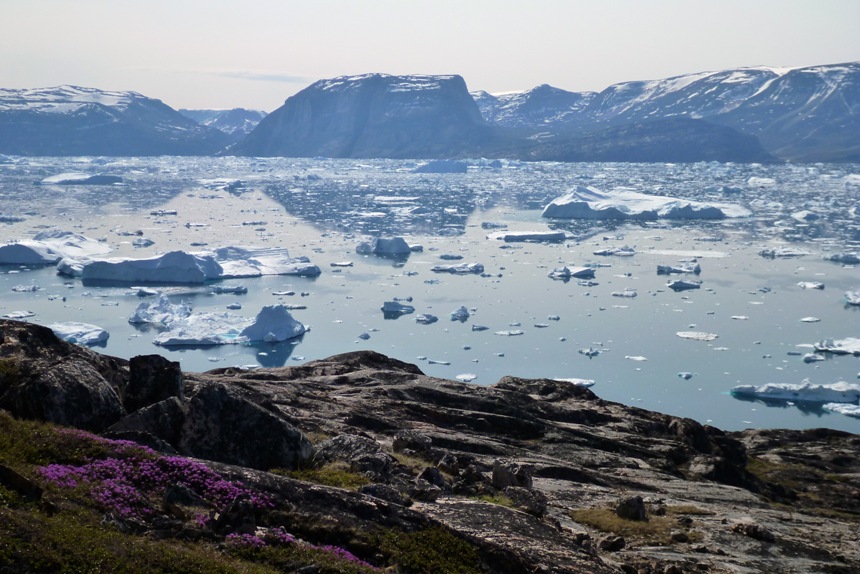
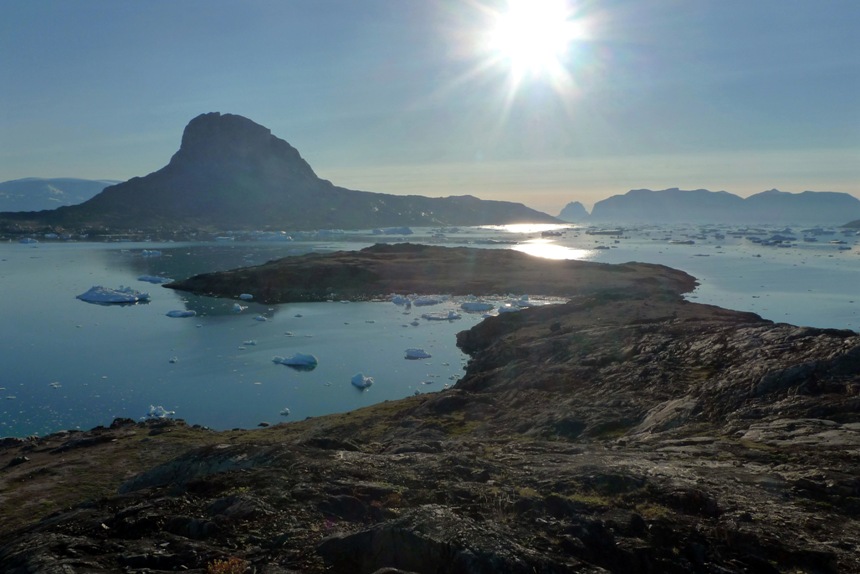
Ikerasak, Uummannaq & Storøen from Qaersuorssuaq
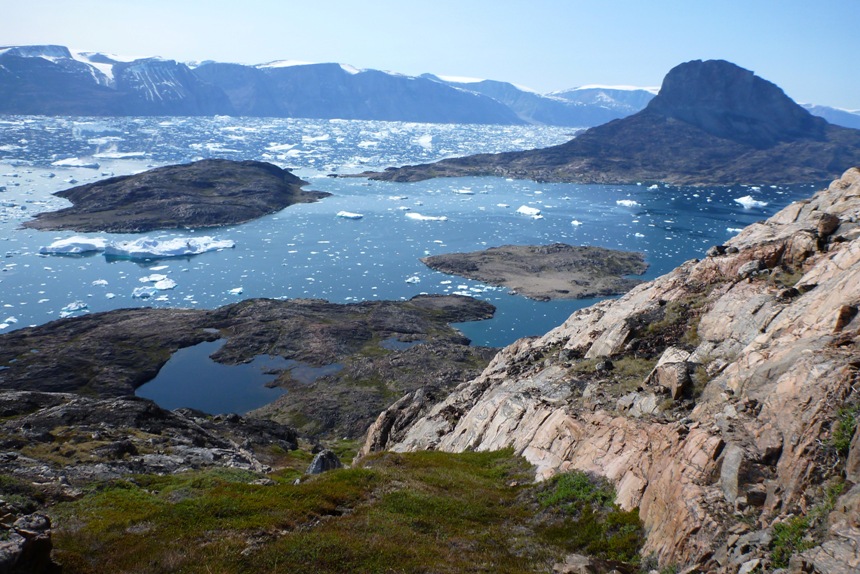
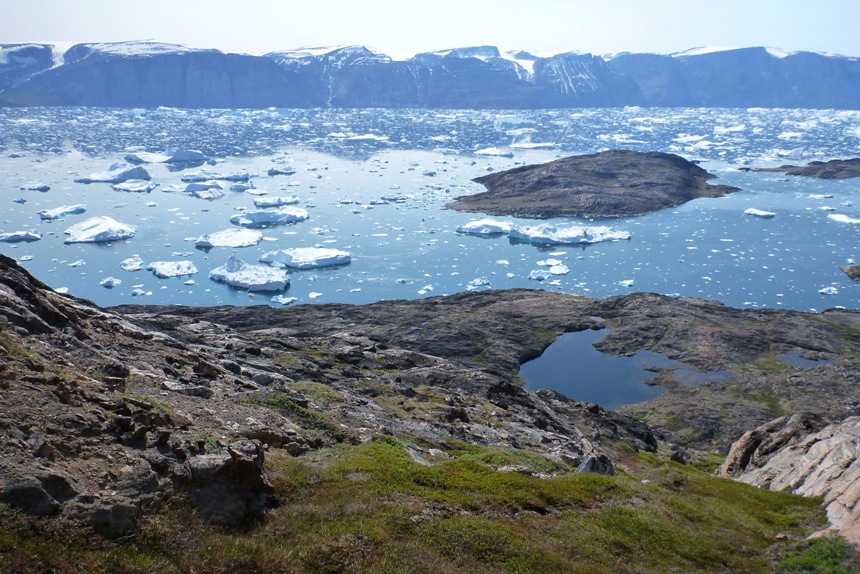
.
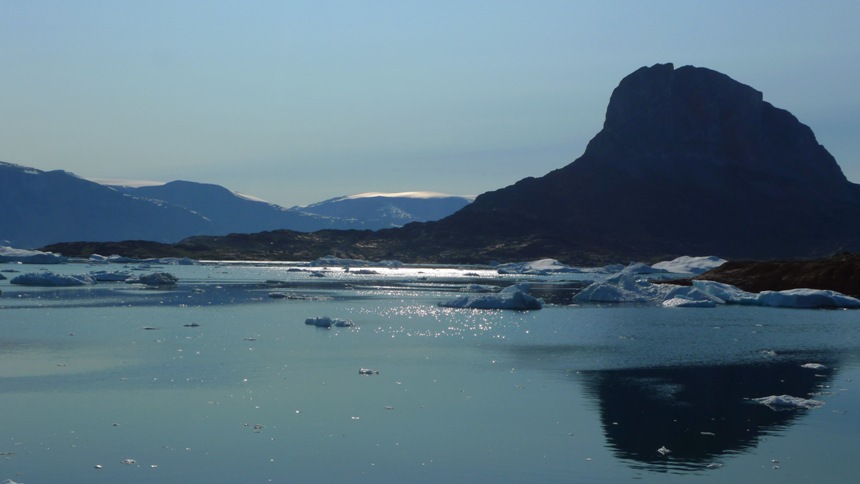
Ikerasak from Igdlukavsak
27 June 2013: Igdlukavsak to Ikerasak to Akuliarseq
What a joyful, exhilarating paddle today! It was so much easier as it was downwind in a 15knot (Force 4) wind that kicked up some enjoyable chop early in the day, as we dodged icebergs of all sizes. I’ve never had to avoid icy chunks and bergs while surfing wind waves before! The weather forecast didn’t seem to apply here and while yesterday was sunny and hot all day without the usual 15knot plus afternoon thermal wind, this evening became very windy. It seems we had another Foehn wind. The barometric pressure dropped several millibars, the night was warm at 12C and as I was looking out of the tent at 0051hrs to see the midnight sun, I spotted of couple of lenticular clouds. We endured yet another fierce, tent-shaking wind last night that wasn’t forecast, so we didn’t wake up until it dissipated which was 8am instead of our usual 4am. Rain was forecast for the past couple of days which never materialized, but tonight it looks like it might happen. It’s much cooler today – only 8-10C and very windy so no mosquitoes. The mountains are very high, imposing and grand.
We paddled to Ikerasak today to get some junk food and to see this isolated village that usually has frozen sea ice for a few months longer than Uummanaq. It was colourful and dusty without any paved roads. Fishing is the main occupation and I believe they also hunt seals by dog sled in the winter. We got some strange looks as we landed in the harbour but some locals were friendly and waved to us. A helicopter pilot from Air Greenland was in the supermarket and he kept staring at us try to figure us out. We head back to our previous campsite at Akuliarseq, and set up camp in a windy, mosquito-free site with magnificent surroundings overlooking the Dryglas peninsula and the cliffs of Qaqugdlugssuit in the distance. Magic! We’re not making massive mileage, but as the weather has been unusually warm, the Foehn, and katabatic winds and the higher than normal amount of ice because of the late, cold May, has been a major consideration in our trip planning since we have so many open crossings. Anyway, it’s good to be alive and kayaking in Greenland!
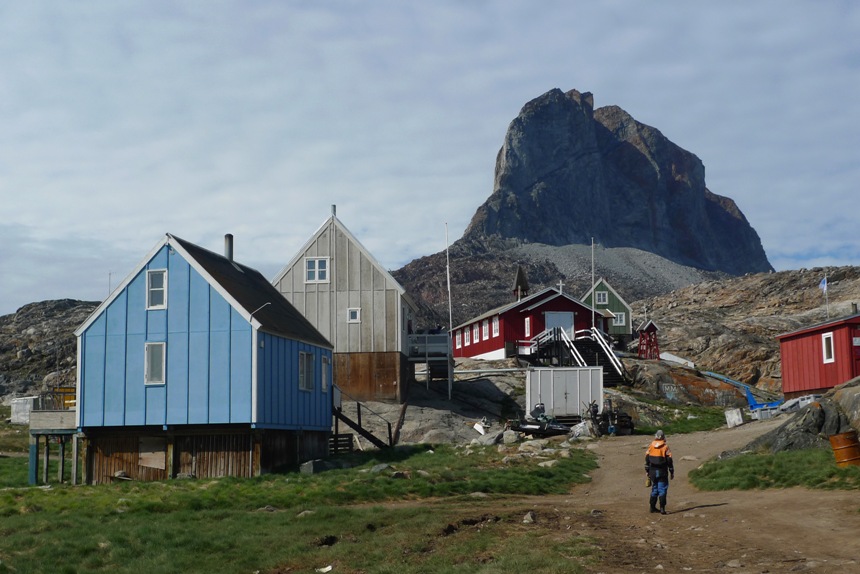
Ikerasak
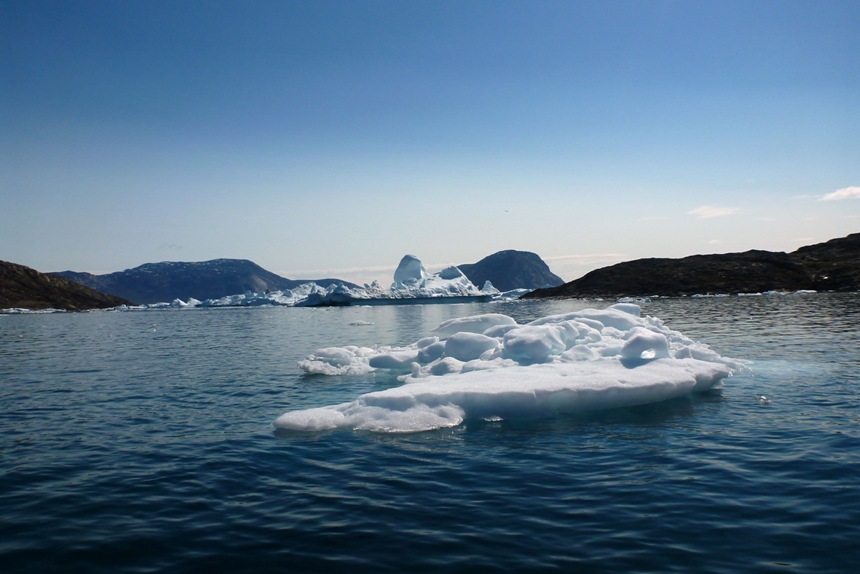
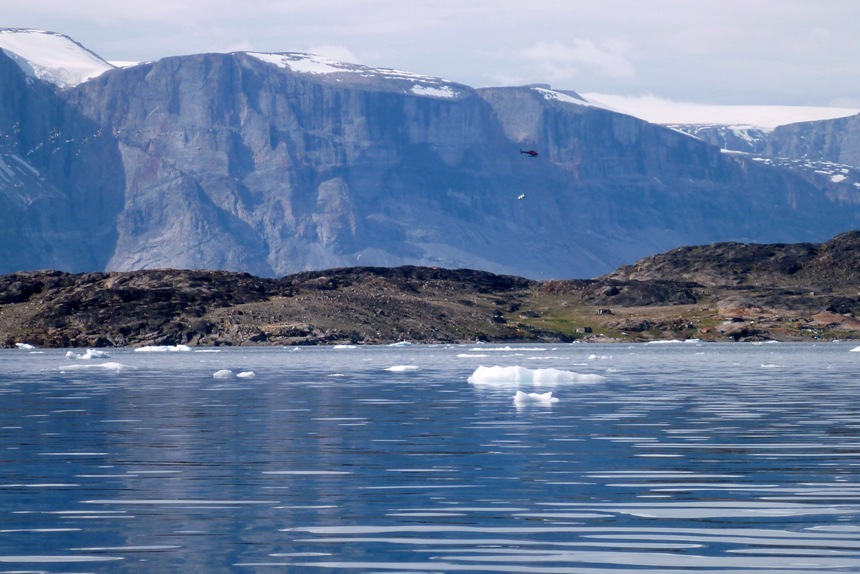
.
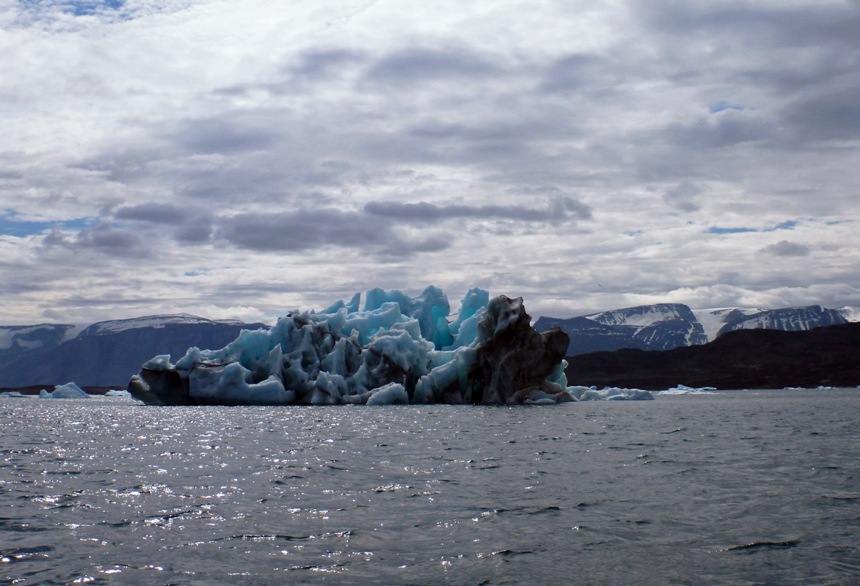
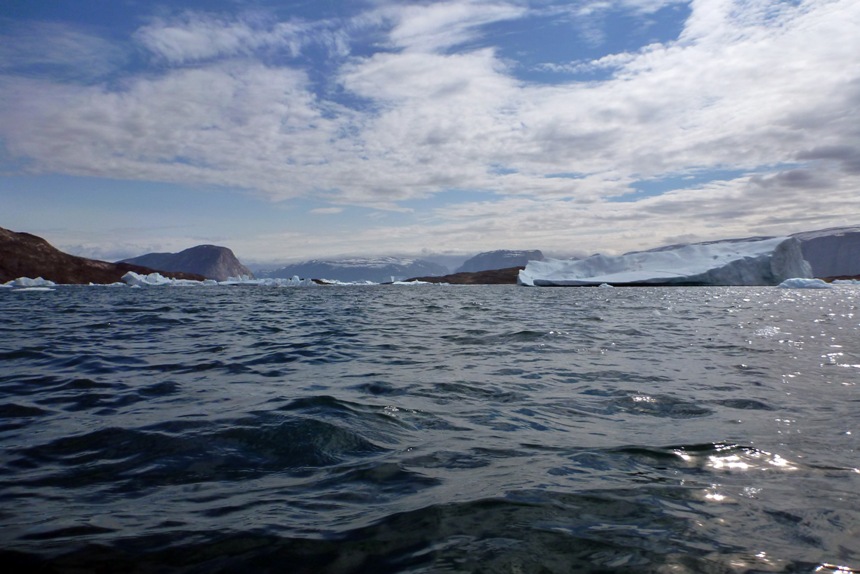
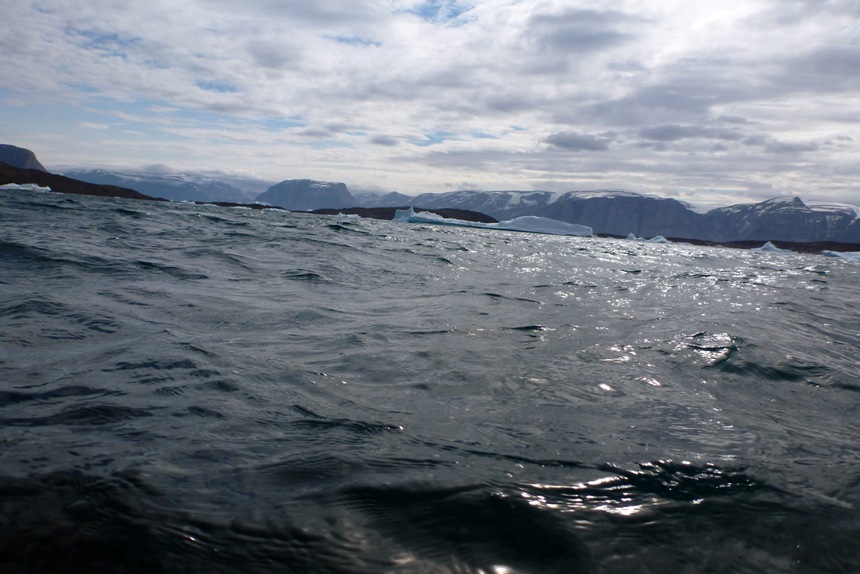
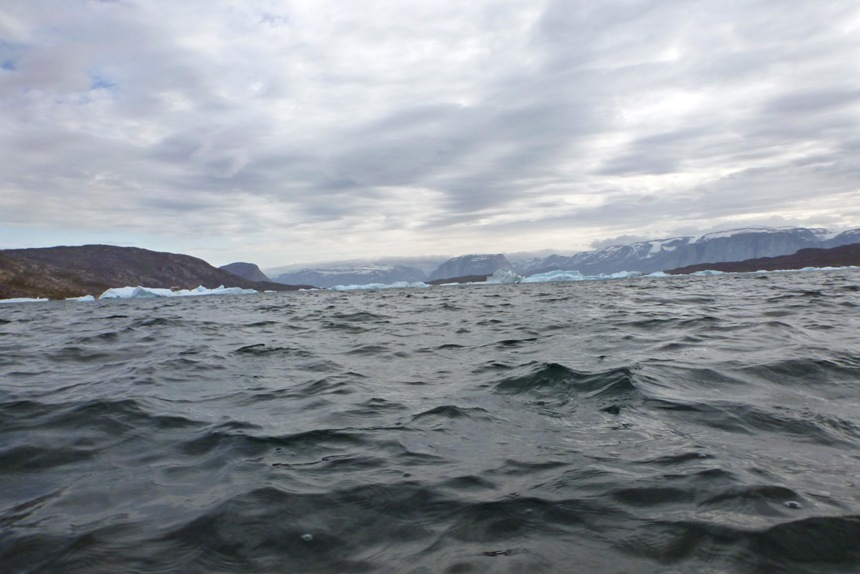
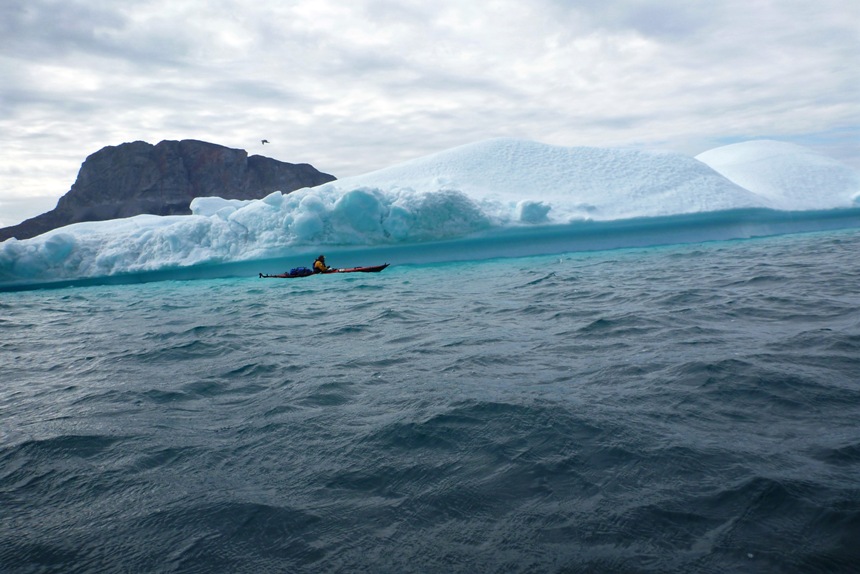
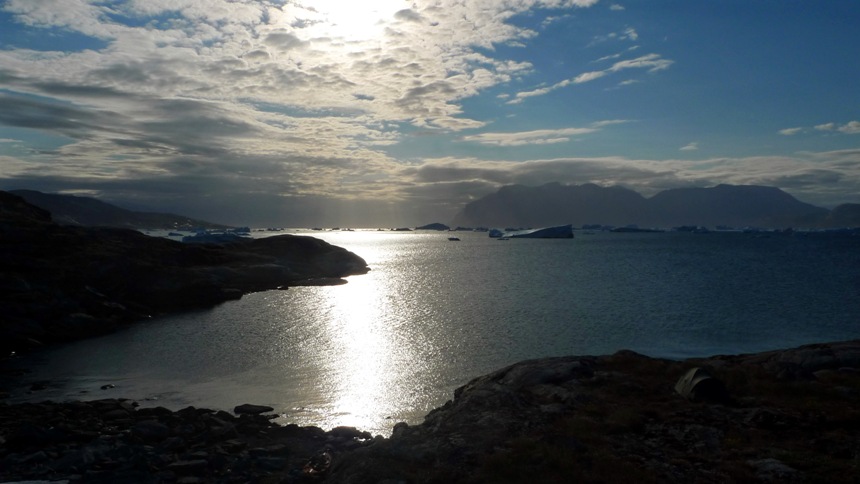
Approaching front

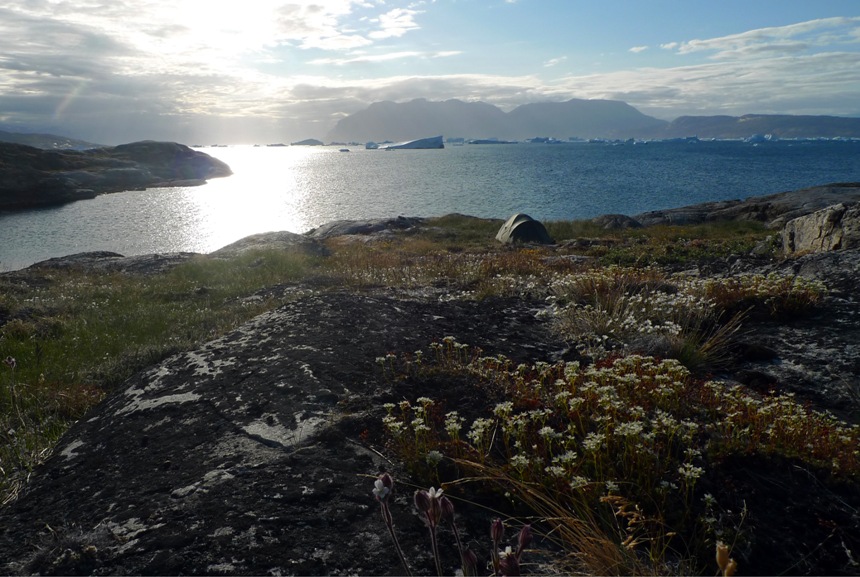
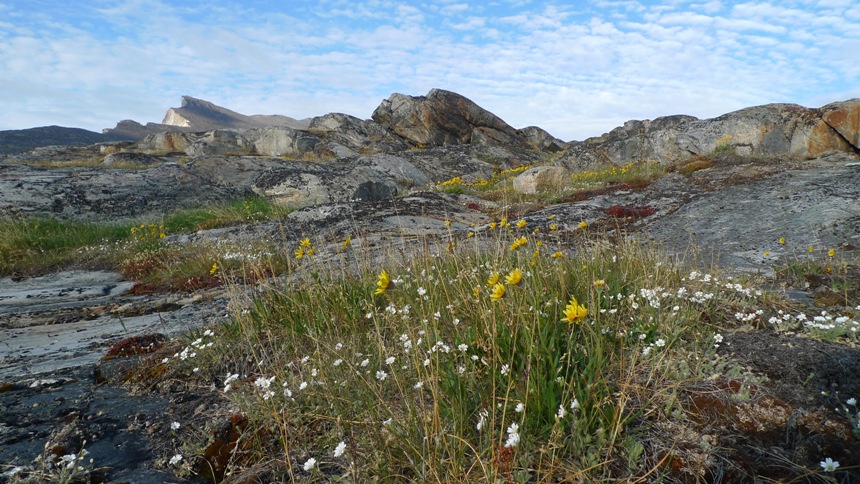
28 June 2013: Akuliarseq to Tulugkap Qeqertai, Ikerasak
We attempted to go to Umanatsiaq on the northern end of Ikerasak Island to see an abandoned settlement but amazingly, after just an hour on the water, a 15-20knot wind (Force 4/5) blew up from the southeast again turning a peaceful, calm crossing into a sporting ride past exploding ice bergs! After we passed a large berg (we were perhaps 200m away), we heard a large deep boom sounding like a detonating bomb exploding and witnessed a giant berg capsizing and rolling with big chunks breaking off which created some wakes which weren’t too big, much to my relief. Another exploded in the middle, collapsed and nearly sank just after I photographed it. Yet another had a large chunk crack and fall off in the small bay close to where we landed! At times it feels like you’re in a war zone and where last week the icebergs were dense, white and square in shape, they are now irregular sculptures of white and blue and are very unstable as they continue to melt and are more likely to roll. Nearly every day we’ve seen at least one very large iceberg roll like a torpedoed sinking ship, rocking to and fro, eventually settling into an unstable position for either the wind, tide, (or kayak?) to destabilize them again until they finally disappear altogether.
The wind is crazy and seems to come and go as if someone is flipping a switch on or off. The wind is either dead still and flat calm or a good stiff force 4/5 or more. I think this must be a particularly stormy period. We were unable to get a weather forecast from our campsite this morning so we didn’t realize that strong south-easterly winds were forecast today.
We landed at another area of abandoned ruins at Tulugkap Qerqertai today. Although the ruins were at first hard to find, the outlines of former stone and sod houses were becoming more clear to make out and it always adds to the charm of this dramatically scenic area. I’m able to collect mussels most evenings and they add a good variety to our bland, stoic diet, but our last junk food stop should carry us out the rest of the trip.
We decided to go on a coastal walk from our campsite to Umanatsiaq to get a look at the ice in Ikerasanguaq. It took us about four hours out and back and we found more Inuit ruins of sod and stone houses. We had lovely coastal views and nice walking on black lichen-covered schist and gneiss rock. While this area is barren and mostly solid rock, there are pleasant areas of willow shrubs, flowers, mosses, lichens and grasses, heather and blueberry and crowberry shrubs. The forecast is for another windy day (10m/s or 20knots, Force 5) with rain, but calm around midnight, so we may do our 9km open crossing then, but even though the forecasts keep changing, at least here we get mobile phone reception.

Artuk, Who Did All Forbidden Things
A man whose name was Artuk had buried his wife, but refused to remain aloof from doings which to those who have been busied with the dead are forbidden to share. He said he did not hold by such old customs.
Some of his fellow-villagers were at work cutting up frozen meat for food. After watching them for a while as they worked at the meat with their knives, he took a stone axe and hacked at the meat saying: “That is the way to cut up meat.” And this he did although it was forbidden.
And on the same day he went out on to the ice and took off his inner coat to shake it, and this he did although it was forbidden.
Also he went up on to an iceberg and drank water which the sun had melted there, knowing well that this was likewise forbidden.
And all these things he did in scorn of that which his fellows believed. For he said it was all lies.
But one day when he was starting out with his sledge, fear came upon him, and he dared not go alone. And as his son would not go with him willingly, he took him, and bound him to the uprights of the sledge, and carried him so.
He never returned alive.
Later in the evening, his daughter heard in the air the mocking laughter of two spirits. And she knew at once that they were laughing so that she might know how her father had been punished for his ill-doing.
On the following day, many sledges went out to search for Artuk. And they found him, far out on the ice, torn to pieces, as is the way with those whom the spirits have punished for refusing to observe the customs of their forefathers. And the son, who was bound to the sledge, had not been touched, but he had died of fright.
“Eskimo Folk Tales”, collected by Knud Rasmussen, edited by W. Worster, 1921
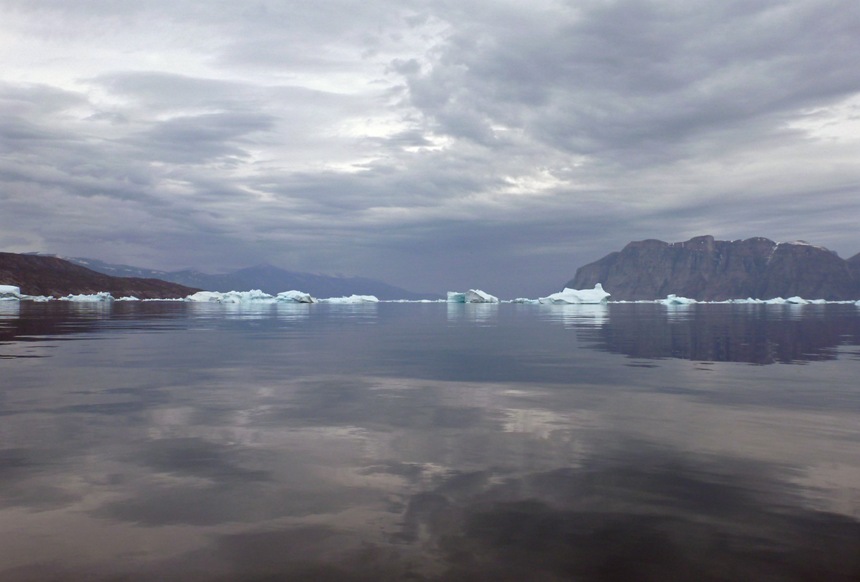
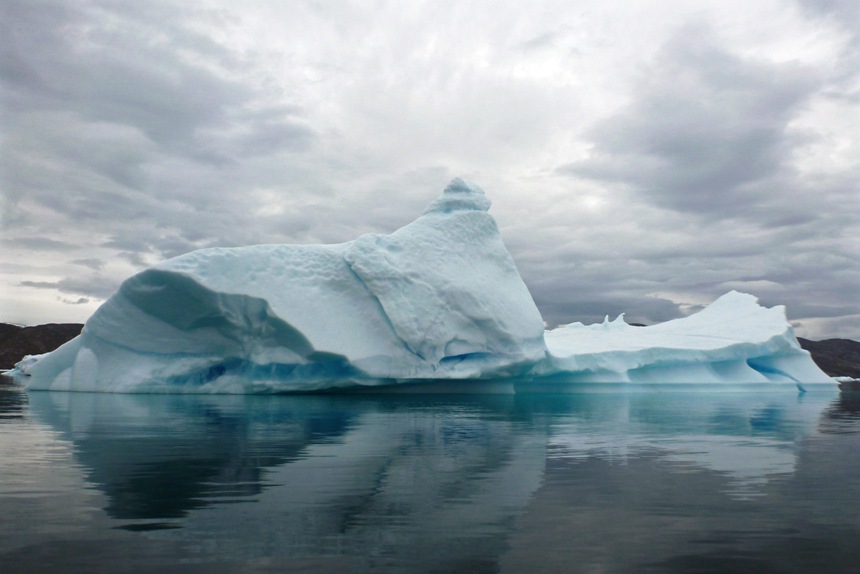
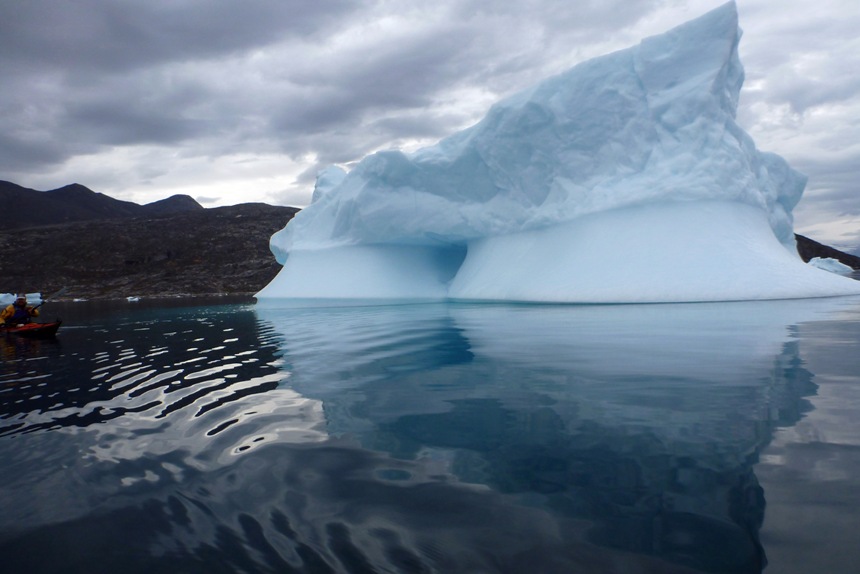
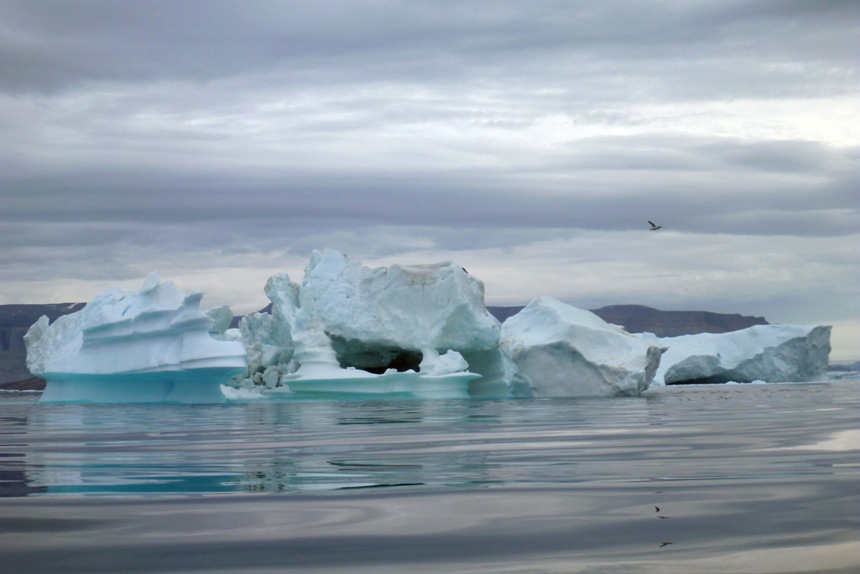
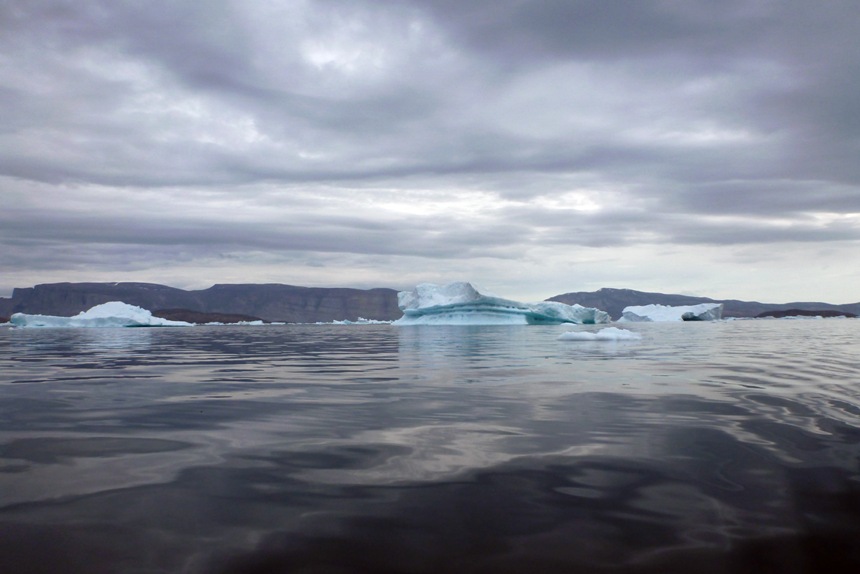
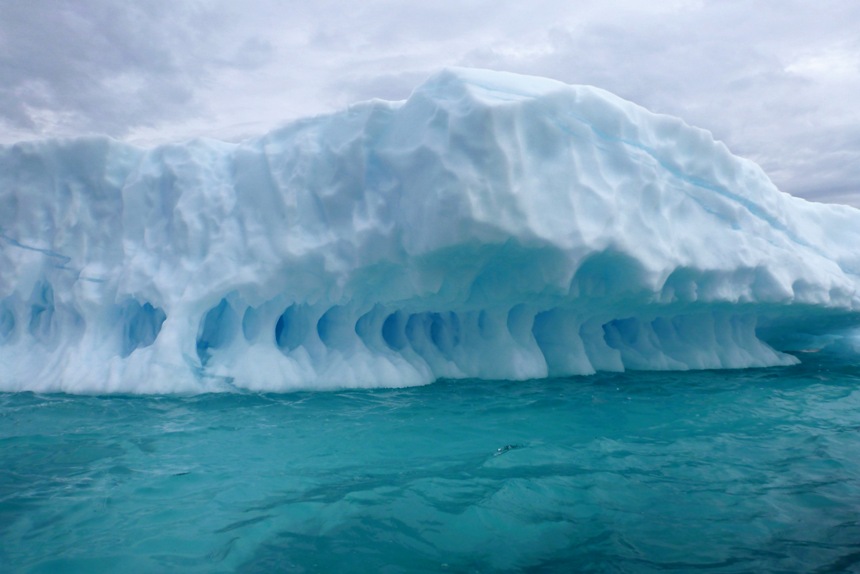
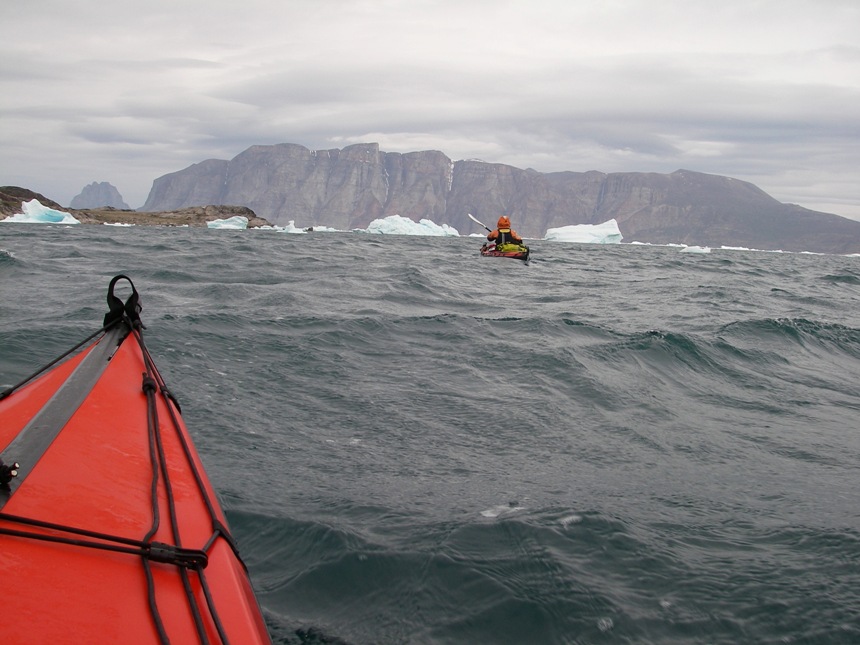
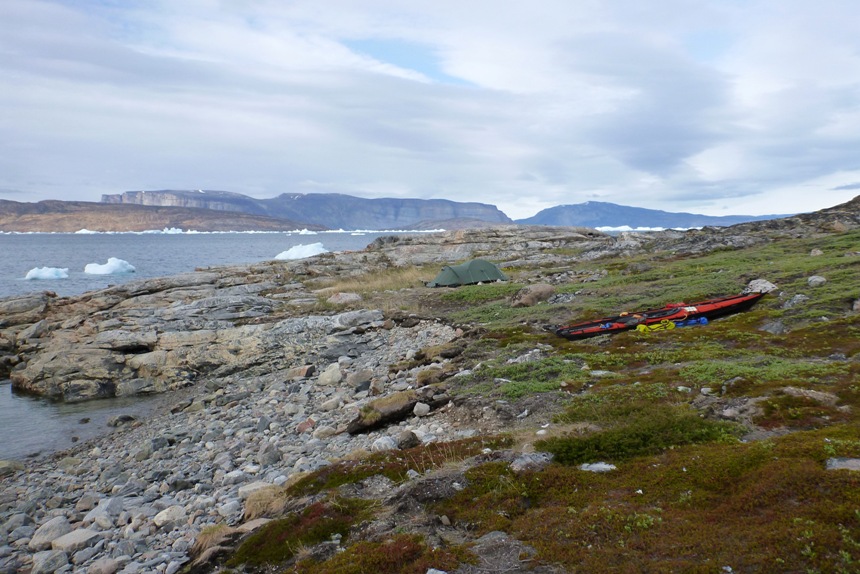
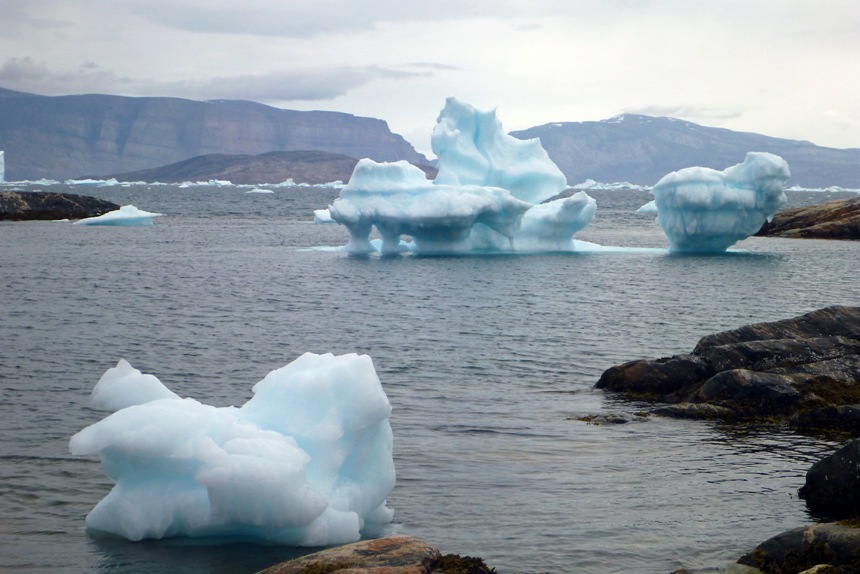
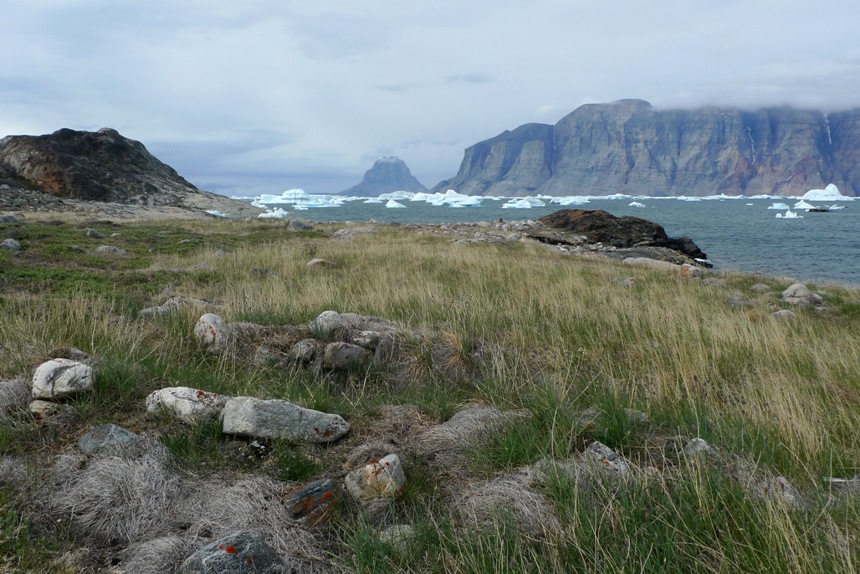
Umanatsiaq, Ikerasak
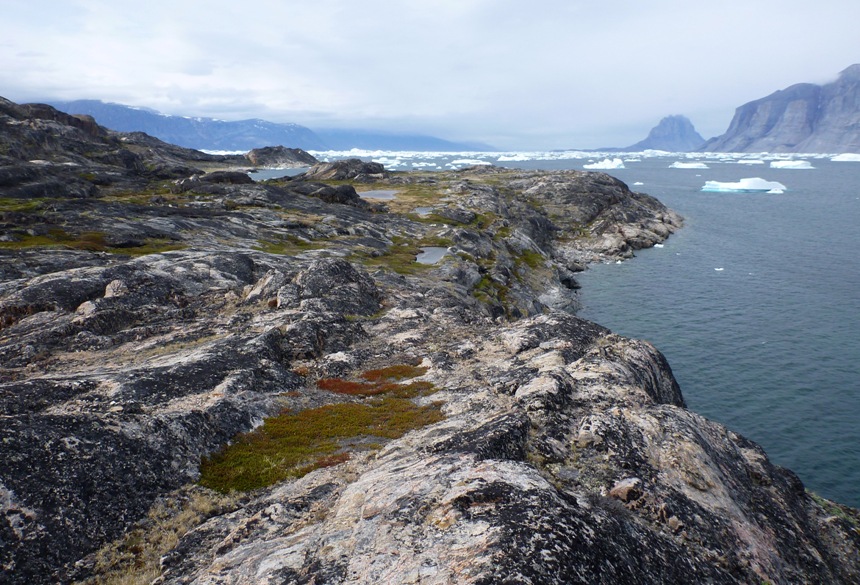

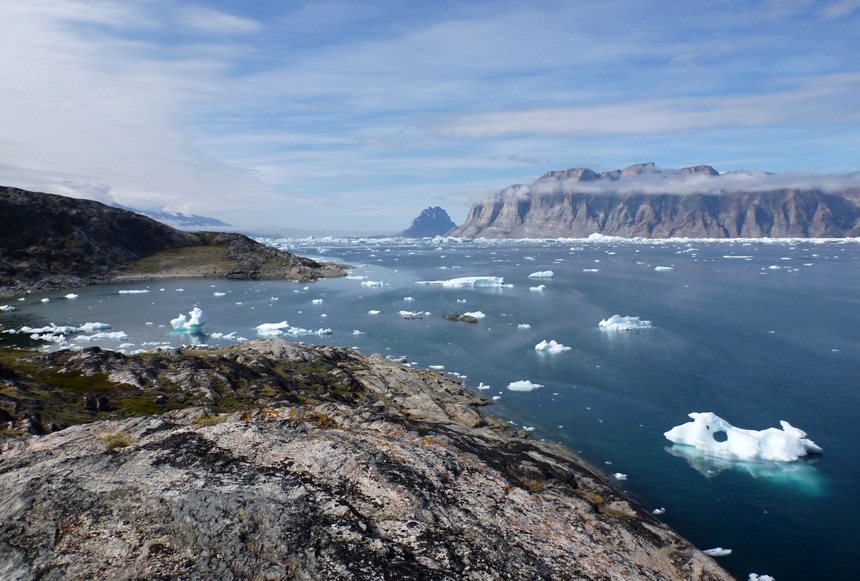
29 June 2013: Tulugkap Qeqertai, Ikerasak
It’s been cold (5C) and overcast in the morning and only 2C at midnight sun night since we left Igdlukavsak campsite on Drygalskis Halvo, but thankfully also fairly mosquito-free in the breezy conditions making it more pleasant living outdoors. I do love living outdoors despite not having all the modern conveniences, and waking up to glorious views every day.
We spent the early part of the day watching and photographing icebergs and feeling how fortunate we are to be here in Greenland. Getting a phone signal was not easy here. After much scrambling, ascending and descending from various directions the rocky outcrops around the campsite to get a signal, Stew finally got one and the wind was forecast to be light from the north. The northerly winds are very cold and biting, but we haven’t been getting the strong katabatics we had earlier in the trip.
We decided to leave about 7pm to coincide with the forecast light wind to make our 9km open crossing to Storøen. Out of the north, toward the open sea, I noticed a dark line of clouds on the horizon that had been there all day, but were now beginning to make their way slowly up the fjord. By the time we had loaded our boats, the line of clouds became very black and advanced closer and closer to us in the form of a dense, heavy, wet cold fog that crept deeper and deeper into the fjord engulfing the mountains, sea and everything in its path. As I stood, mouth gaping open, visibility was reduced to just a hundred feet or so and the mountain on the other side of the open crossing had completely disappeared in the very thick fog and rain.
How the Fog Came
There was a Mountain Spirit, which stole corpses form the graves and ate them when it came home. And a man, wishing to see who did this thing, let himself be buried alive. The Spirit came, and saw the new grave, and dug up the body, and carried it off.
The man had stuck a flat stone in under his coat, in case the Spirit should try to stab him.
On the way, he caught hold of all the willow twigs whenever they passed any bushes, and made himself as heavy as he could, so that the Spirit was forced to put forth all its strength.
At last the Spirit reached its house, and flung down the body on the floor. And then, being weary, it lay down to sleep, while its wife went out to gather wood for the cooking.
“Father, father, he is opening his eyes,” cried the children, when the dead man suddenly looked up.
“Nonsense, children, it is a dead body, which I have dropped many times among the twigs on the way,” said the father.
But the man rose up, and killed the Mountain Spirit and its children, and fled away as fast as he could. The Mountain Spirit’s wife saw him, and mistook him for her husband.
Where are you going?” she cried.
The man did not answer, but fled on. And the woman, thinking something must be wrong, ran after him.
And as he was running over level ground, he cried: “Rise up hills!” And at once many hills rose up. Then the Mountain Spirit’s wife lagged behind, having to climb up so many hills.
The man saw a little stream, and sprang across. “Flow over your banks!” he cried to the stream. And now it was impossible for her to get across.
“How did you get across?” cried the woman.
“I drank up the water. Do you likewise.” And the woman began gulping it down.
Then the man turned round towards her, and said: “Look at the tail of your tunic; it is hanging down between your legs.”
And when she bent down to look, her belly burst. And as she burst, a steam rose up out of her, and turned to fog, which still floats about to this day among the hills.
“Eskimo Folk Tales”, collected by Knud Rasmussen, edited by W.W. Worster, 1921
We decided that a 9km open crossing in 1-2C water filled with rolling icebergs with no visibility was not a good idea! We unloaded our boats, and up went the tent in record time in the cold heavy fog and we were snuggled and asleep within about an hour!
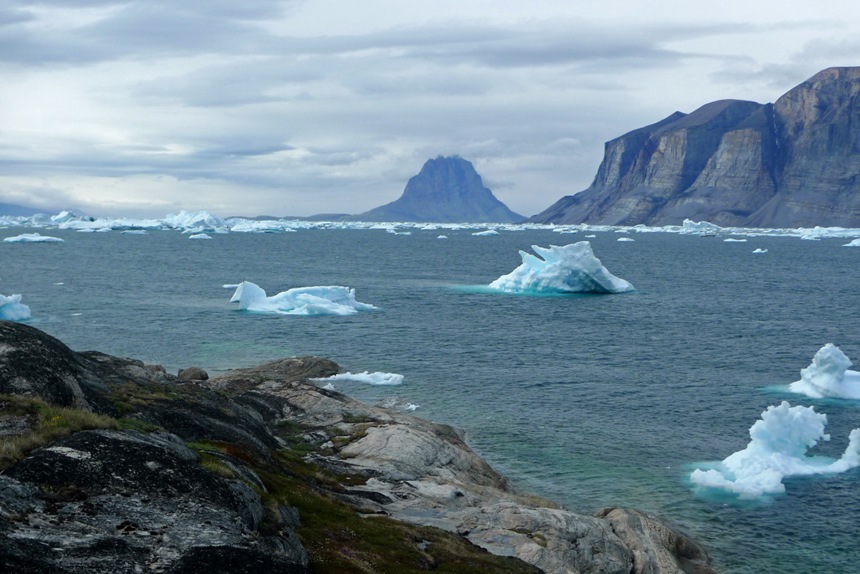
30 June 2013: Tulugkap Qeqerta, Ikerasak to Storøen
The heavy fog persisted all night, but eventually lifted just enough to expose the base of Storoen. We were up sharp at 4.30am and on the water at 6.50 for our 9km crossing back to Storøen and then another 12km to the campsite. It was a perfectly calm, overcast with a moody, brooding sky. I wanted to just dash across to make sure we reached our campsite without the fog closing in or before the afternoon thermals blew up. But I knew the longer the sun was obscured by the clouds and prevented the sun from heating up the land, the longer the calm conditions would persist. It was peaceful and beautiful, quietly weaving among the shockingly pure white and blue mountains of ice glowing against a purple and gray sky and sea. The rumbling and cracking of the distant and sometimes nearby icebergs added to the atmosphere of this beautiful Arctic spectacle.
There were very few landings along the exposed base of the cliffs and after a few hours, we arrived very happy not to have had to encounter a katabatic wind or thick fog. Storøen was massive and seemed even higher and steeper with parts of it plunging 1400 metres from the tops of it’s pinnacles down its sheer sides straight into the sea. There are so few landing areas and with our 1:250,000 map with little detail, we relied on the abandoned settlements marked on the map as possible campsites hoping, but not really knowing if it was possible to land a kayak there. It was, therefore, a lot less stressful today to return to the campsite where we had been stormbound two weeks ago. A Greenlander in a fishing skiff was laying some hooks on the opposite side of the bay where we will camp and Stew will try his hand at fishing there tomorrow. But we did it, we’re here, alive and on dry land.
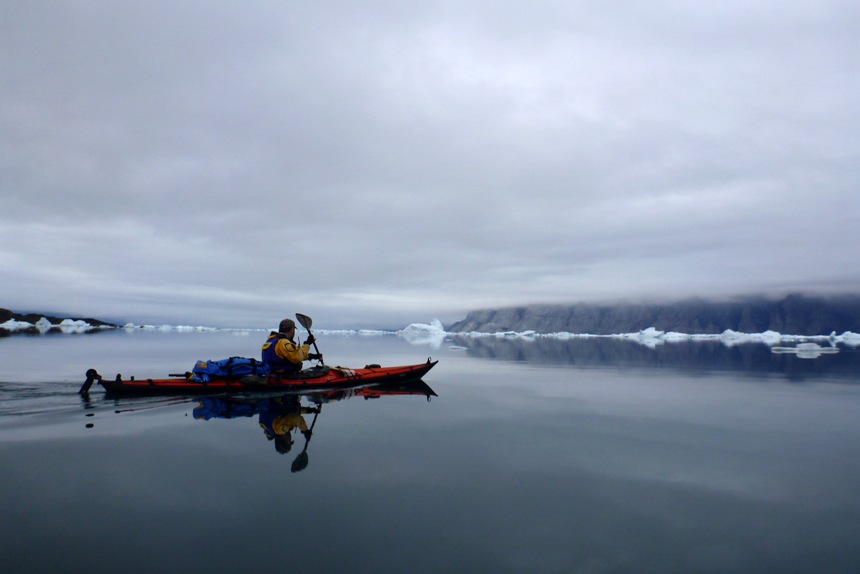
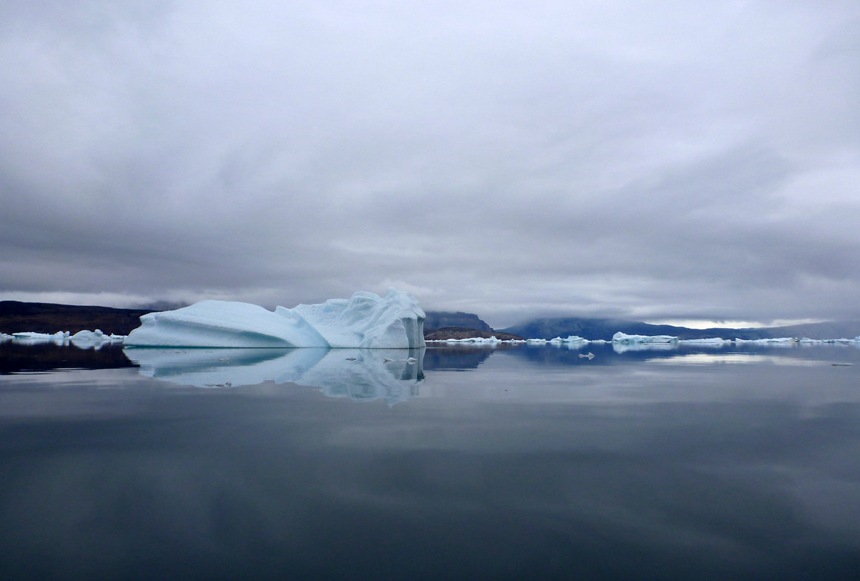
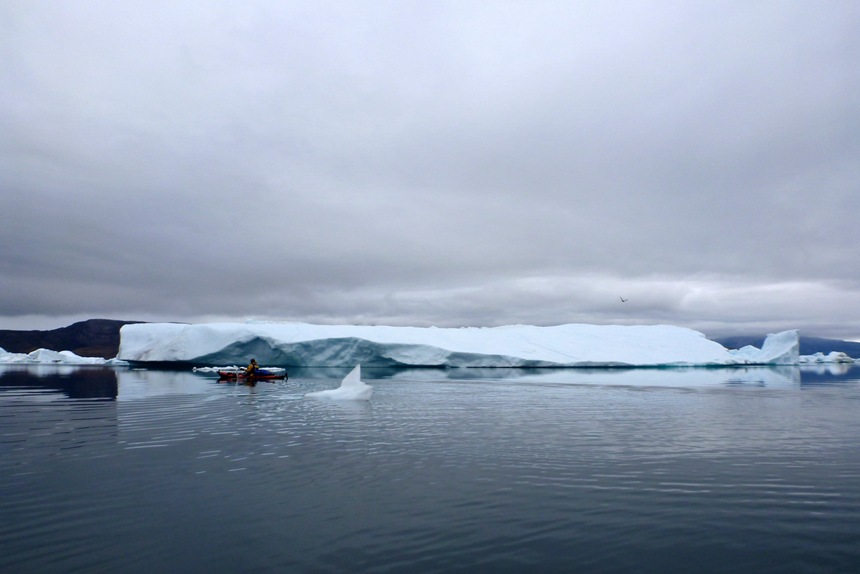
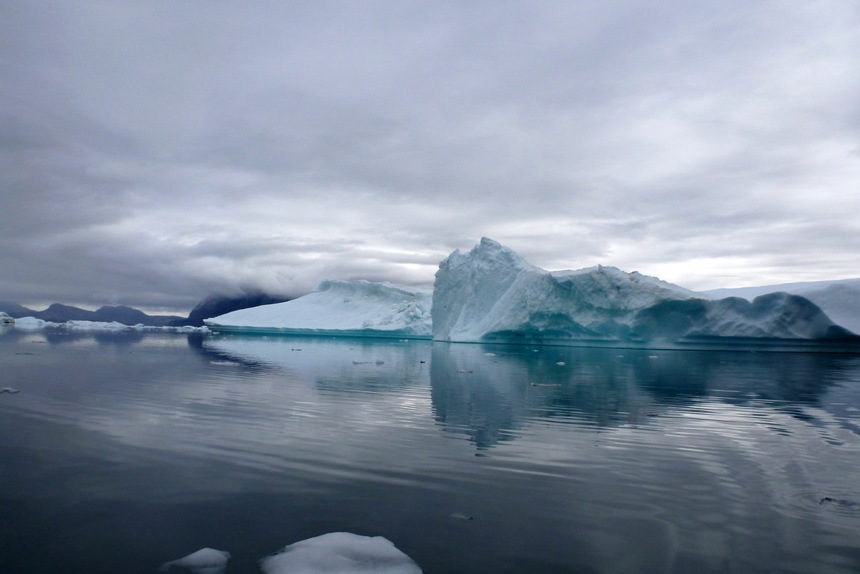
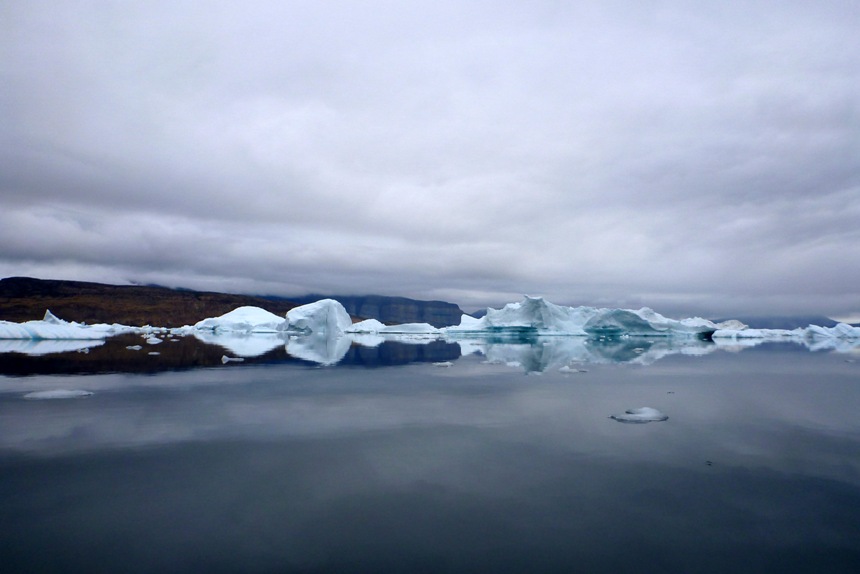
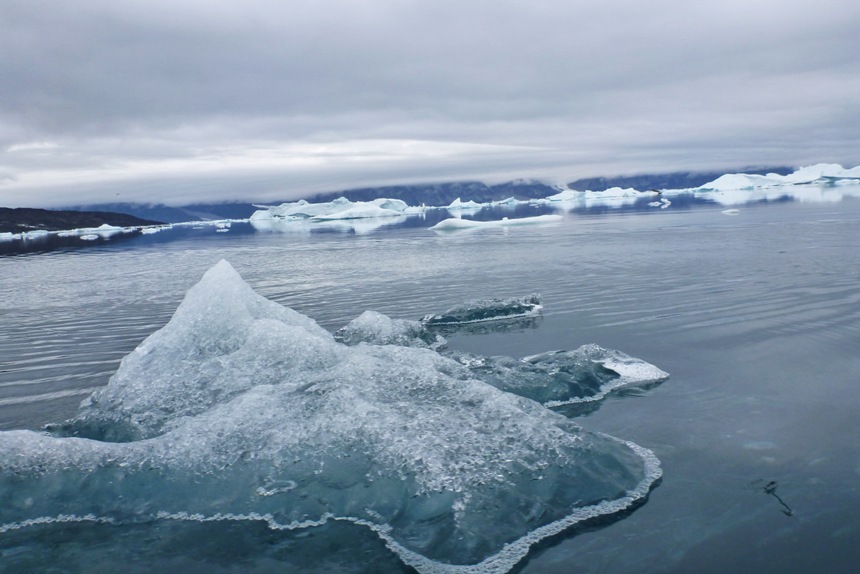
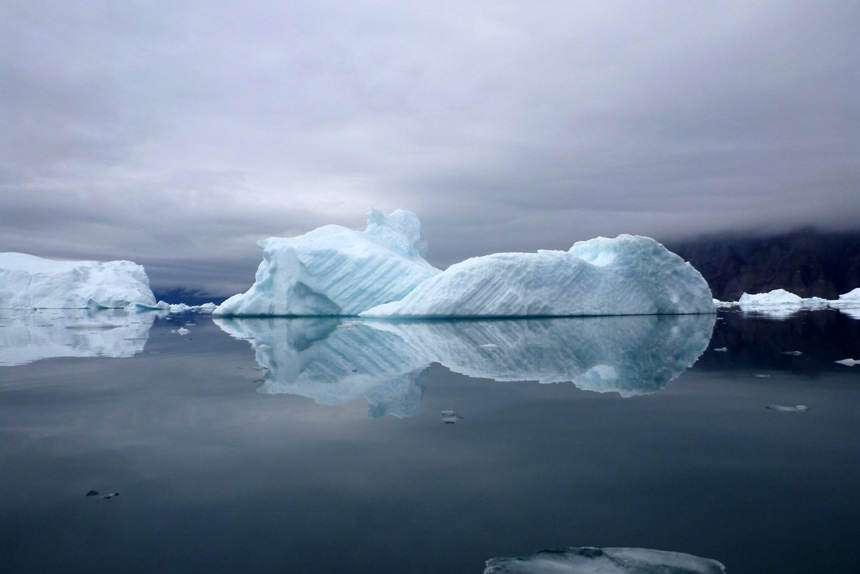
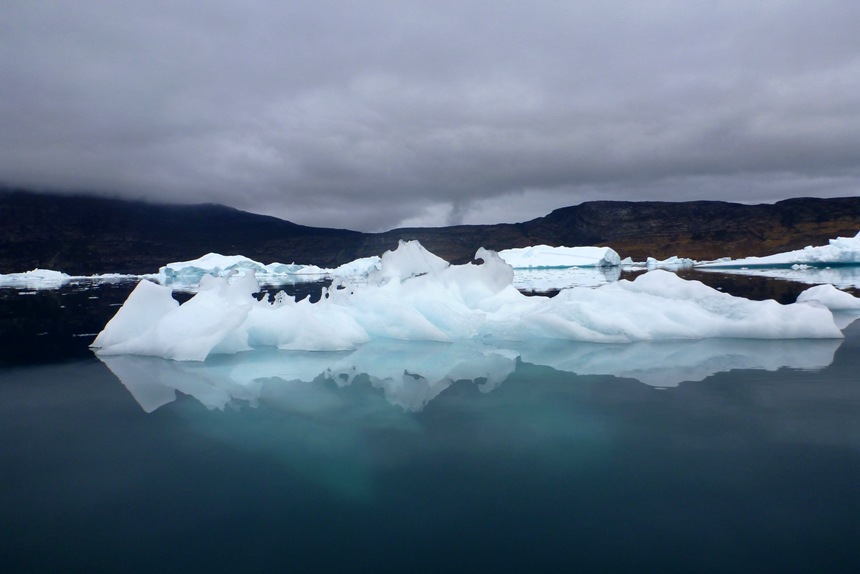
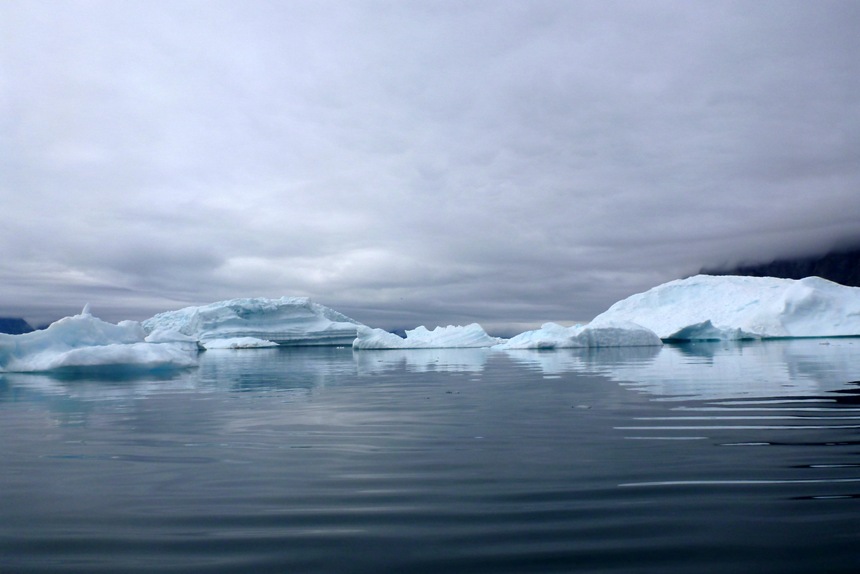
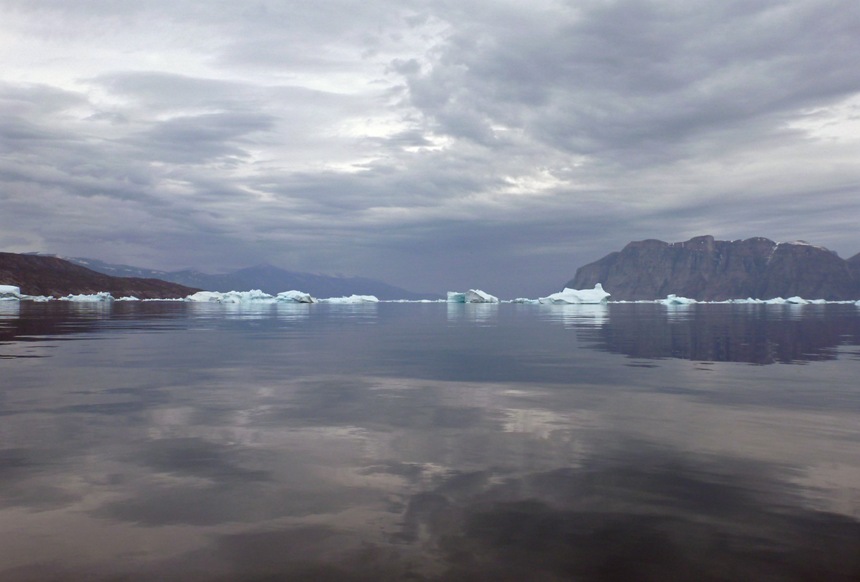
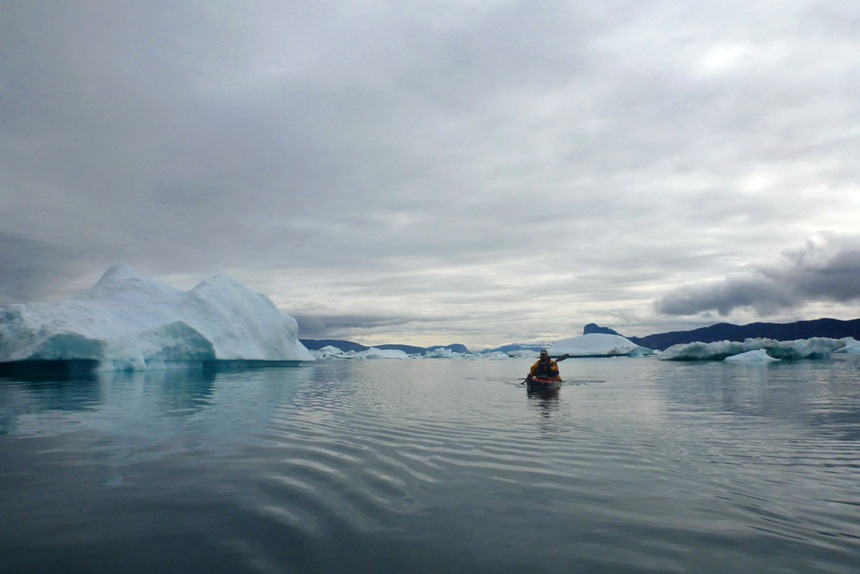
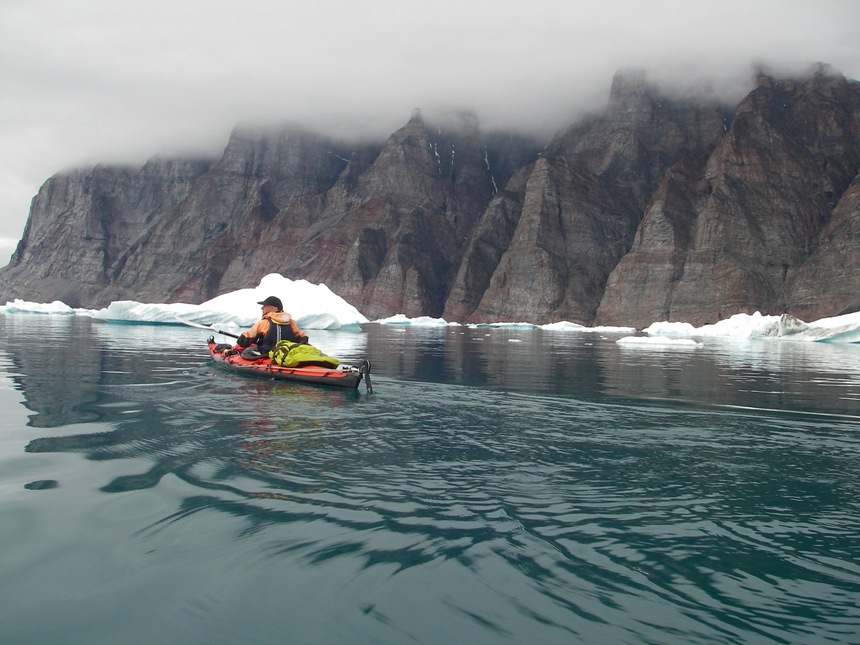
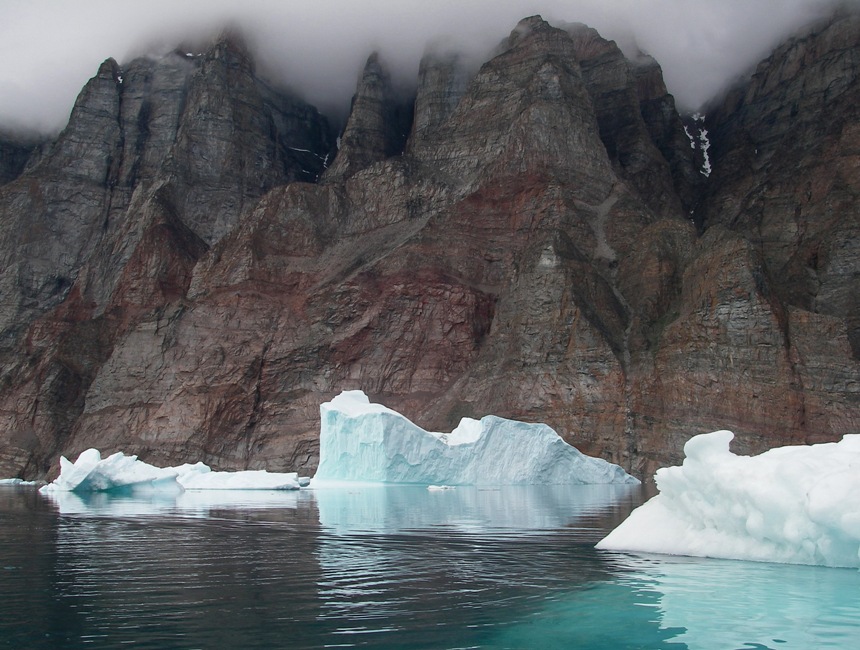

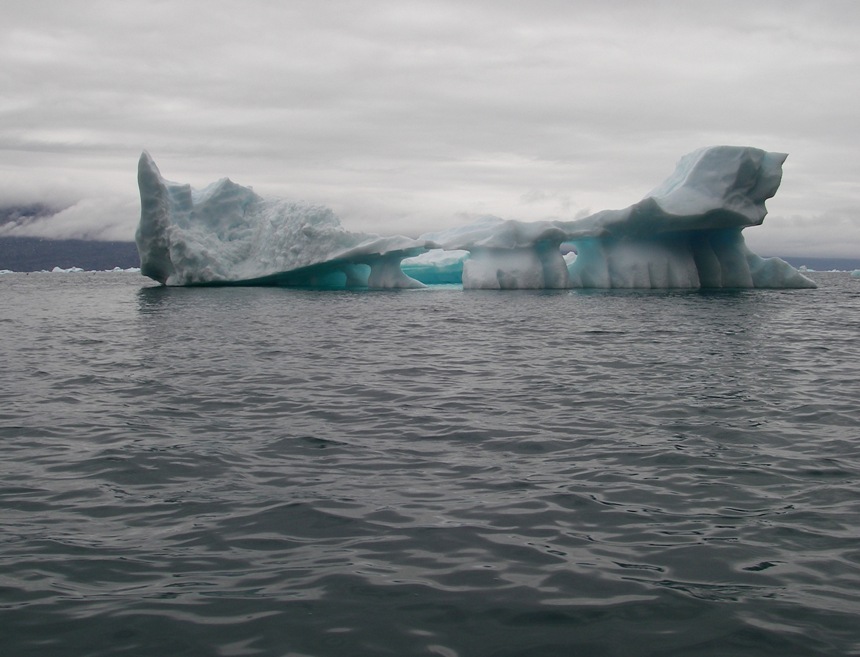
1 July 2013: Igdlunguaq, Storøen
The clouds are low over the tops of the mountains and a light, cold (5C) wind blows from the north. It’s easy to get a signal here just across the water from Uummannaq, so we’ll have a holiday for the day here and set off tomorrow.
Will I ever be cured of my addiction to icebergs?! I love to watch them, photograph them, paddle amongst them, and watch them topple, crack, explode, rumble and sink. Some have waterfalls of melting water, blue holes, arches, steep high faces, collapsed middles, jagged bits with undersides of glowing blue extending underwater for dozens of feet. How can I ever cease to be fascinated and mesmerized? I’ve never heard of “Icebergs Anonymous”; maybe I’ll Google it. I am greedy and want to see more and more, but I must be happy with what I can see and do, weather and kayaking ability permitting.
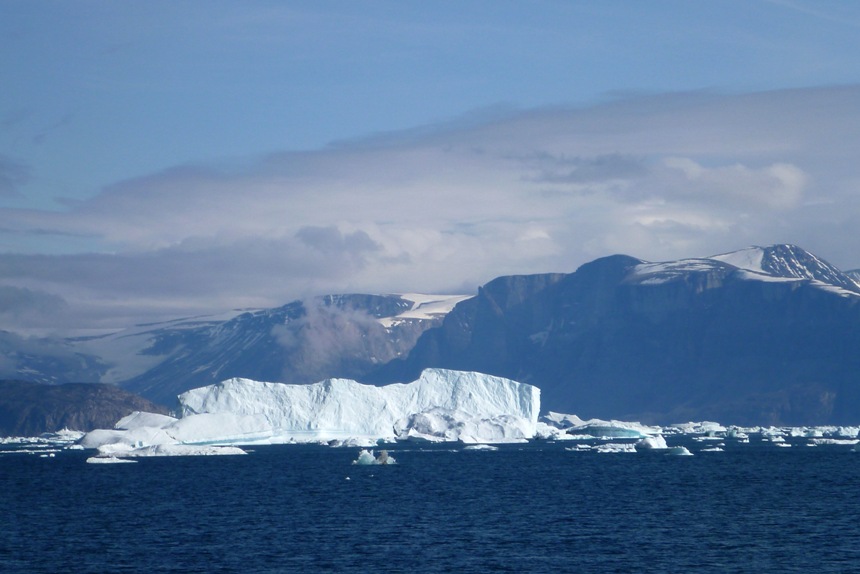
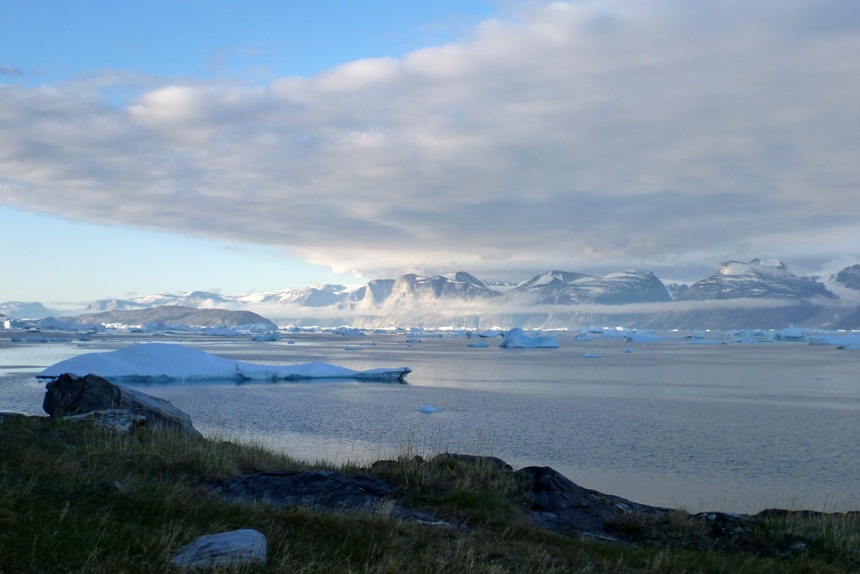
Midnight Sun, Uummannaq Fjord
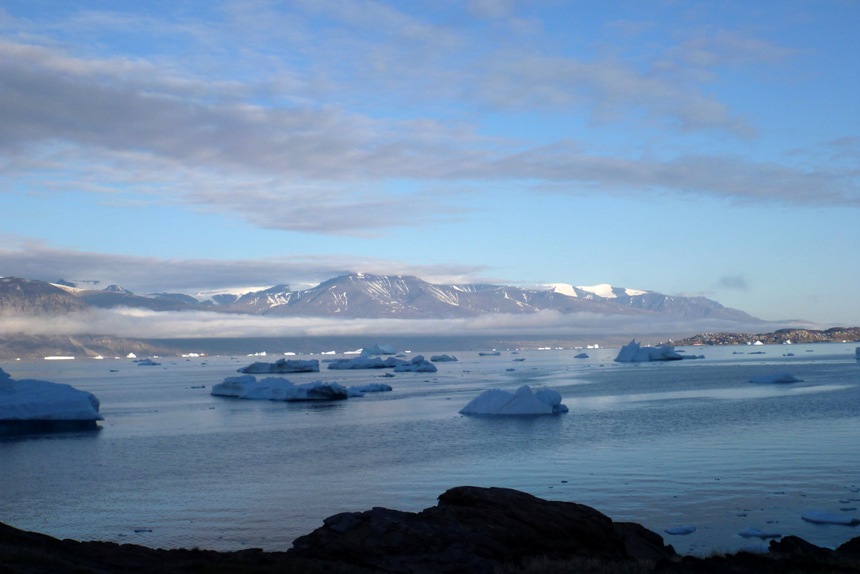
Midnight Sun, Uummannaq Fjord
2 July 2013: Igdlunguaq, Storøen
Rest day since we have a couple of days to kill. The weather is in a changeable phase so we’d rather arrive a couple of days early to make our flight on time, so a fishing, reading, eating day it is!
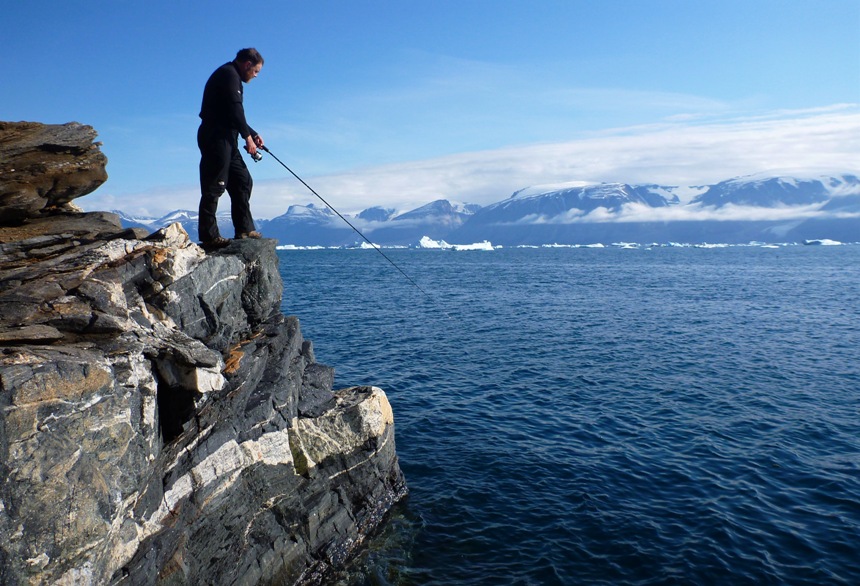
The Hunter
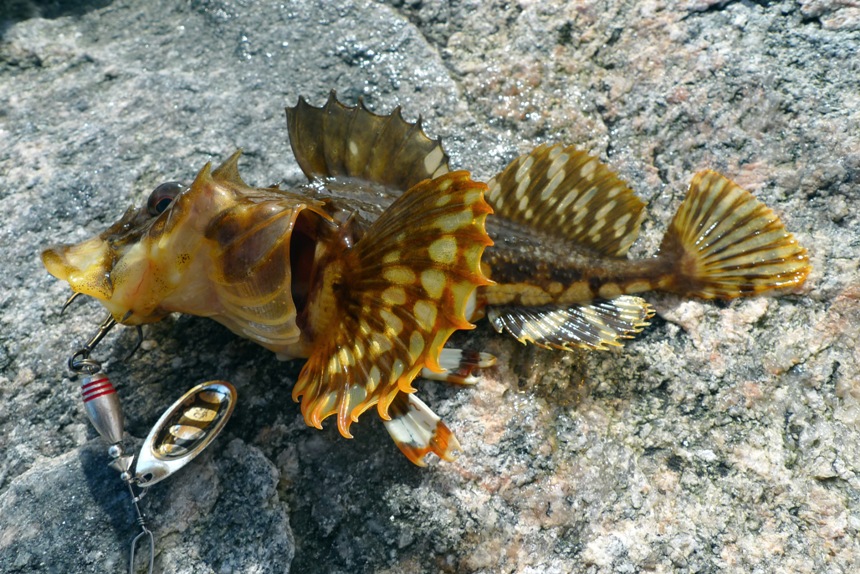
Short-Horned Sculpin
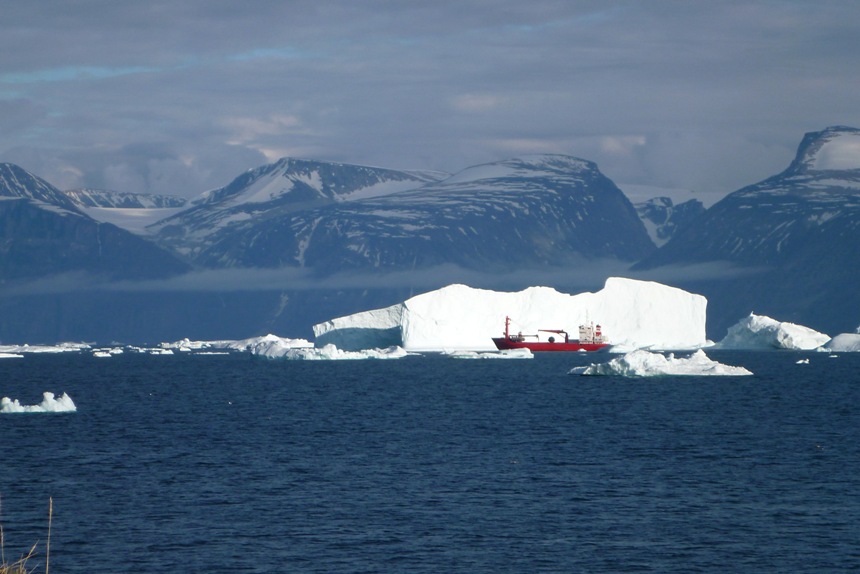
Royal Arctic Line
3 July 2013: Storøen to Spragbugten Bay on Uummannaq island
Another 8km crossing achieved today with a following wind and following sea that created sporting clapotis off the shallow west end of Uummannaq. We camped on the other side of Uummannaq at a wide open bay called Spragbugten. We found Santa Claus’s cabin which was a delightful stone and peat traditional Inuit house. The ceiling was low and even at 5’5” I had to bend down while walking around. It was a one room dwelling with Victorian furnishings, with a 4-poster bed complete with sealskin throw and had pictures of Santa Claus on the wall. There was a small group of shelves with various tools and a desk with letters of children from around the world. The tradition is that if a child sends a letter to Santa Claus, it ends up here in Greenland, even though I always thought Santa’s house was at the North Pole! The afternoon breeze picked up quite strongly so we did a bit of walking and had a wash in the icy sea water.
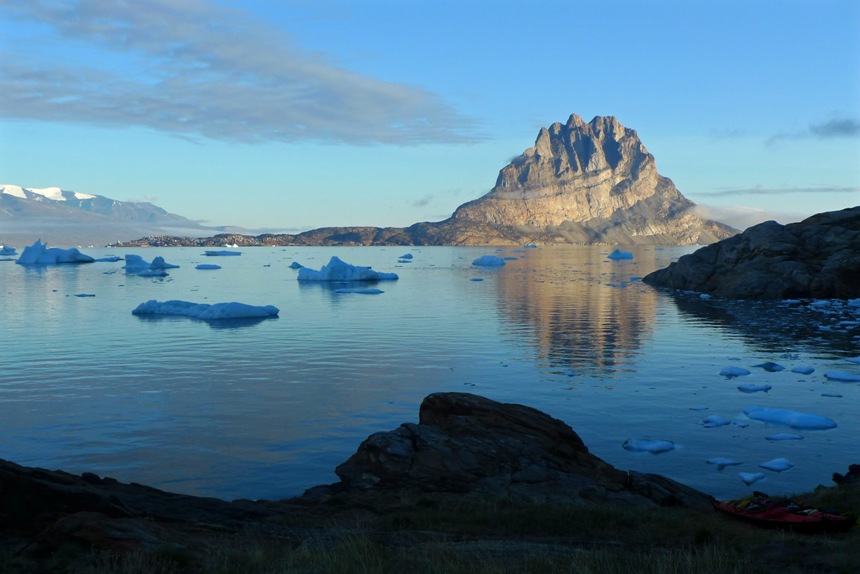
Uummannaq from Storøen at 4.00am

Approaching Uummannaq
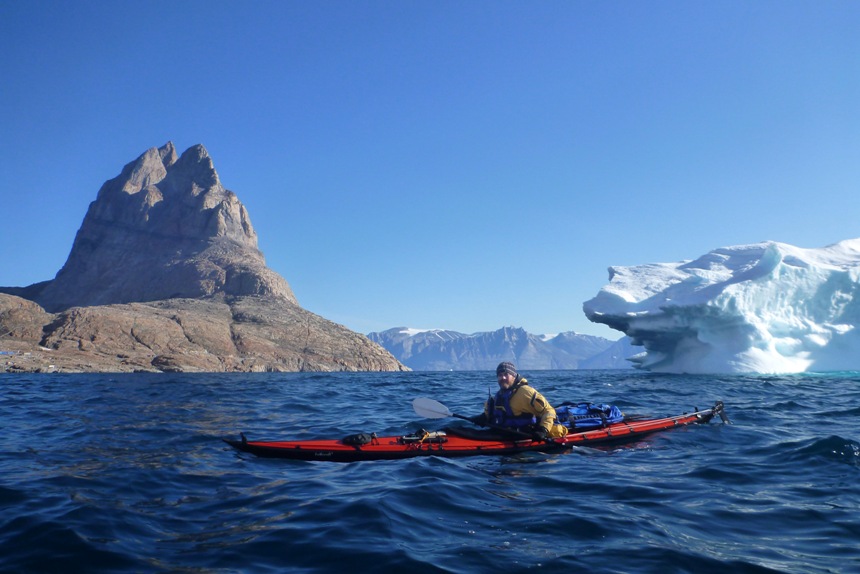
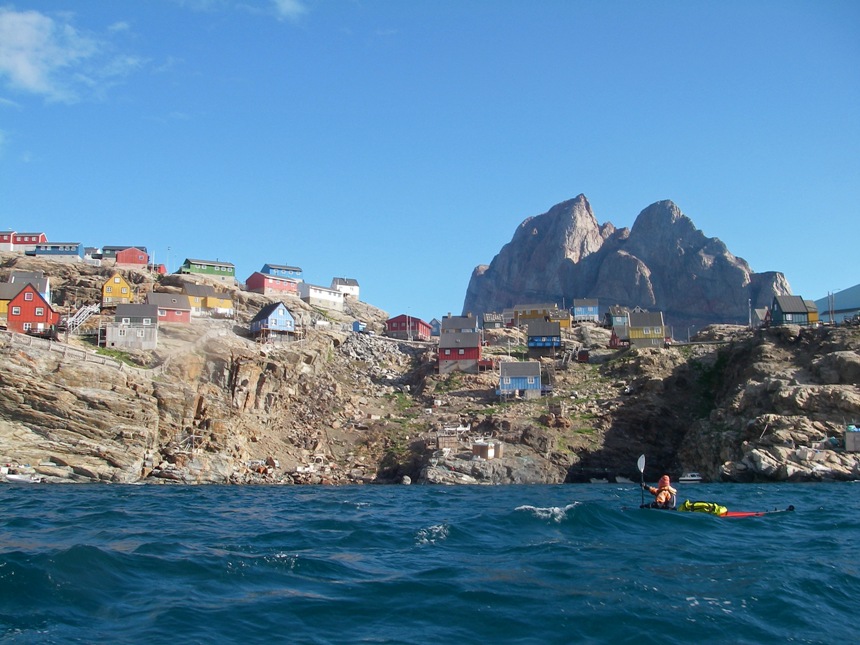
South coast of Uummannaq
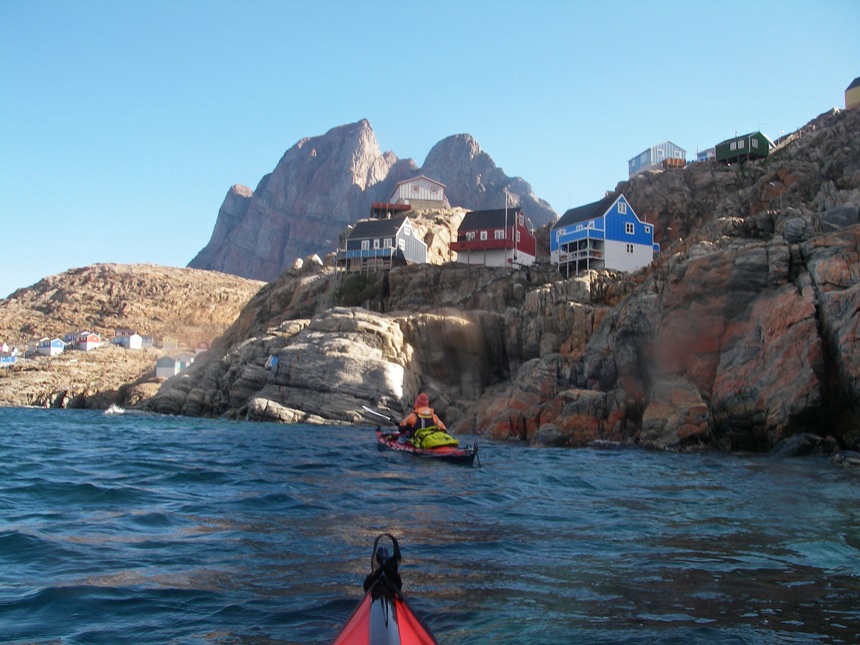
South-west Uummannaq
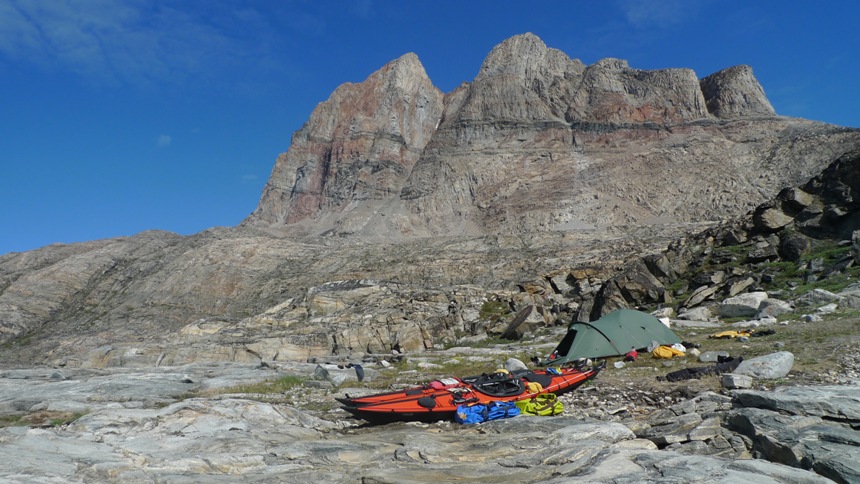
Spragbugten Bay, Uummannaq
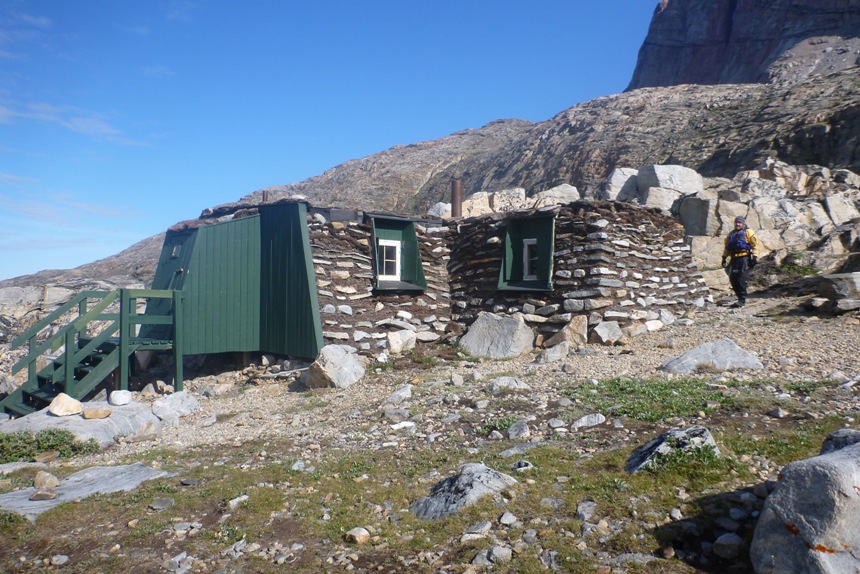
Santa’s Cabin, Spragbugten, Uummannaq
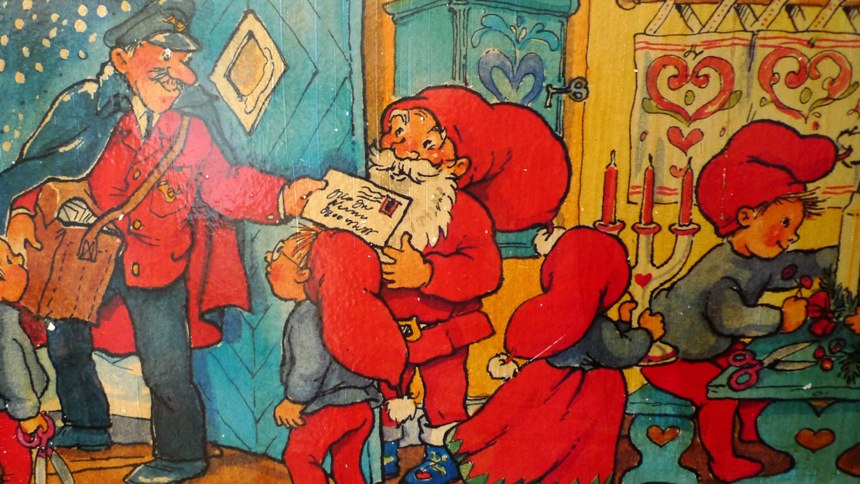
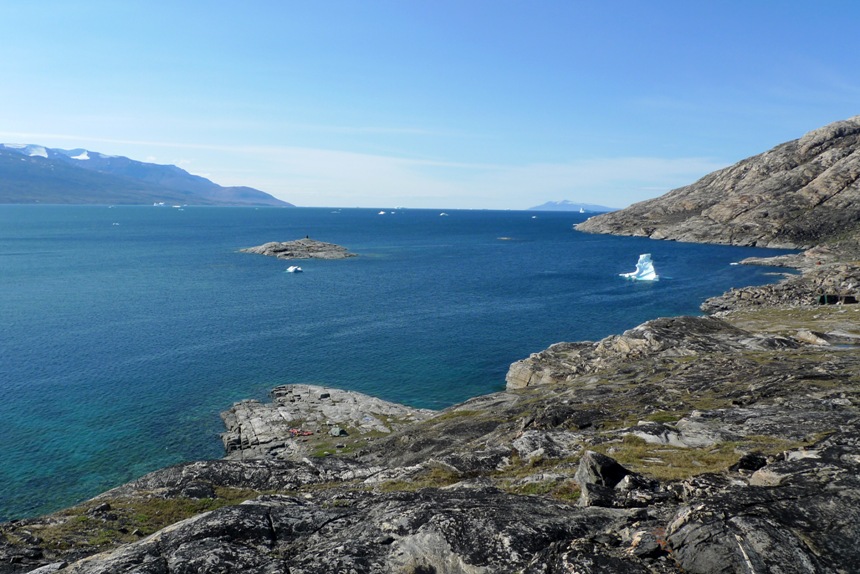
Spragbugten Bay, Uummannaq
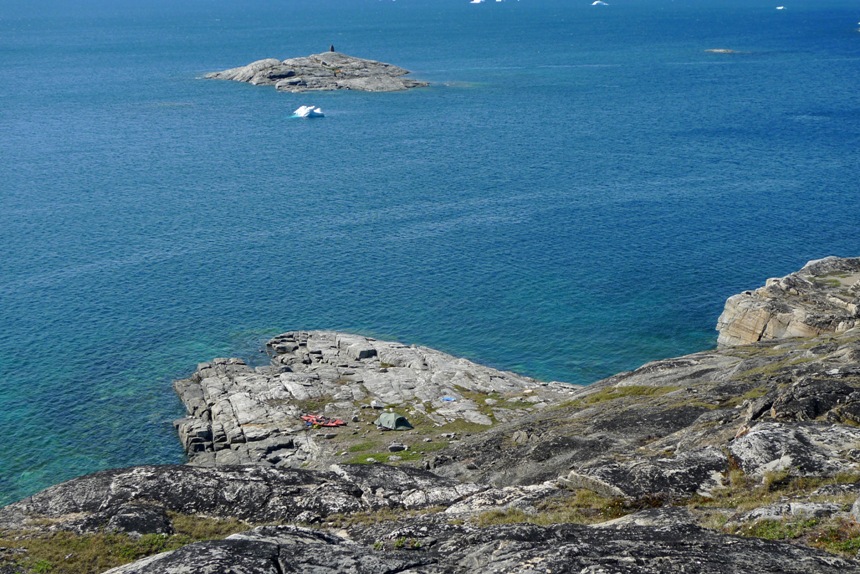
Spragbugten Camp, Uummannaq
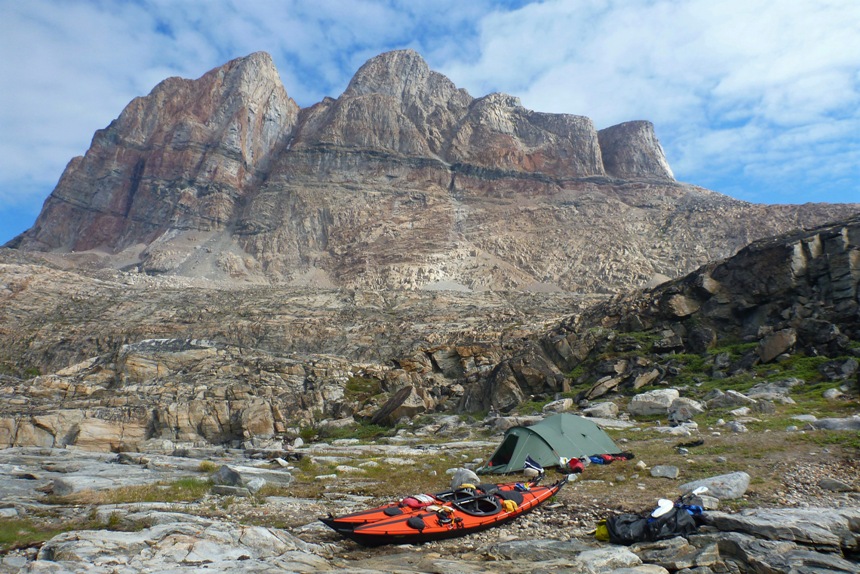
Spragbugten Bay, Uummannaq
4 July 2013: Spragbugten to Uummannaq
We made an early start and completed the short paddle around to the harbour and the headache of logistics began. As we began breaking down our folders near the slipway, we were joined by a local Greenlander who was patching up his fishing skiff with fibreglass resin. I felt a bit conspicuous and strange, since our watercraft were skin on frame, and while his was motorized. As I was taking the frame out, and he was sitting about 10 feet away facing me scrubbing his hands over a small bucket of water (which took ages), he kept smiling at me. After about the fourth smile, it dawned on my female intuition that maybe, just maybe he was flirting with me??!! It figures, since the only attention I get these days is from men over 50! I guess I’ll never know, but thankfully his wife came over and the smiling soon ceased.
So, from 7.30am to 3.30pm we dismantled our boats, retrieved our boxes from the heliport, wheeled the packed boats to the Tele Post office, wheeled the boxes from the harbour to the Telepost office, and packed our boats into the boxes.
At the Tele Post office, they wouldn’t accept any box over 30kg (ours were 32kg) and kindly directed us to the Royal Arctic Line warehouse just 100metres away. We left our boxes there, ran to the warehouse (they were about to close), and the efficient staff drove the forklift to the post office, picked up our boxes, placed them on a pallet, wrapped them in cellophane all within the bleary blink of a weary eye! What service! Since it was the largest shipping company in Greenland, they were used to shipping and receiving goods from all over the world at quite reasonable price. Phew! It was done and we could now relax.
Everyone seems to hang out around the harbour, and we finally saw where the traditional skin on frame kayaks were stored. They were tucked away near a shed only about 100 feet from the slipway we had launched and landed on. Three locals, one in a skin on frame and the other two in plastic sea kayaks had an exciting paddle in the strong wind and waves around the harbour and about 500m out. They were accompanied by a friend in a fishing skiff who joined them bouncing and playing in the waves. Not a bad idea – sort of a “safety boat” in case of capsize. Cooperation and helping each other while kayaking or hunting is as great of value today as it was in the past.
Kanagssuaq
Kanagssuaq, men say, went out from his own place to live on a little island, and there took to wife the only sister of many brothers. And while he lived there with her, it happened once that the cold became so great that the sea between the islands was icebound, and they could no longer go out hunting. At last they had use up their store of food, and when that store of food was used up, none of them could go out hunting, they all remained lying down from hunger and weakness.
Once, when there was open water to the south, where they often caught seal, Kanagssuaq took his kayak on his head and went out hunting. He rowed out in a northerly wind, with snow falling, and a heavy sea. And soon he came upon a number of black seal. He rowed towards them, to get within striking distance, but struck only a little fjord seal, which came up between him and the others. This one was easier to cut up, he said.
Now when he had got this seal, he took his kayak on his head again and went home across the ice. And his house-fellows shouted for joy when they saw the little creature he sent sliding in. Next day he went out again, and caught two black seal, and after that, he never went out without bringing home something.
The north wind continued, and the snow and the cold continued. When he lay out waiting for seal, as was now his custom, he often wished that he might meet with Kiliteraq, the great hunter from another place, who was the only one that would venture out in such weather. But this did not come about.
But now there was a great dearth of food also in the place where Kiliteraq lived. And therefore Kiliteraq took his kayak on his head and went out across the ice to hunt seal. And coming some way, he sighted Kanagssuaq, who had already made his catch, and was just getting his tow-line out. As soon as he came up, Kanagssuaq cut away the whole of the belly skin and gave to him. And Kiliteraq felt now a great desire for blubber, and took some good big pieces to chew.
And while he lay there, some black seal came up, and Kanagsuaq said: “Row in to where they are.”
And he rowed in to them and harpooned one, and killed it on the spot with that one stroke. He took his bladder float, to make a tow-line fast, and wound up the harpoon line, but before he had come to the middle, a breaking wave came rolling down on him. And it broke over him, and it seemed indeed as if there was no kayak there at all, so utterly was it hidden by that breaking wave. Then at last the bladder showed up behind the kayak, and a little after, the kayak itself came up, with the paddles held in a balancing position. Now for the second time he took his bladder and line, and just as he came to the place where the tow-line is made fast, there came another wave and washed over him so that he disappeared. And then he came up a second time, and as he came up, he said:
“I am now so far out that I cannot make my tow-line fast. Will you do this for me?”
And then Kanagssuaq made his tow-line fast, and as soon as he had taken the seal in tow, he rowed away in the thickly falling snow, and was soon lost to sight. When he came home, his many comrades in the village were filled with great thankfulness towards him. And thereafter it was as before; that he never came home without some catch.
A few days later, they awoke and saw that the snow was not falling near them now, but only far away on the horizon. And after that the weather became fine again. And when the spring came they began hunting guillemots; driving them together in flocks and killing them so. This they did at that time.
And now one day they had sent their bird arrows showering down among the birds, and were busy placing the killed ones together in the kayaks. And then suddenly a kayak came in sight on the sunny side. And when that stranger came nearer, they looked eagerly to see who it might be. And when Kiliteraq came nearer – for it was Kiliteraq who came – he looked round among the kayaks, and when he saw that Kanagssuaq was among them, he thrust his way through and came close up to him, and struck his paddle in between the thongs on Kanagssuaq’s kayak, and then loosened the skin over the opening of his own kayak, and put his hand in behind, and drew out a splendid tow-line made of walrus hide and beautifully worked with many beads of walrus tooth. And a second time he put in his hand, and took out now a piece of bearskin fashioned to the seat of a kayak. And these things he gave to Kanagssuaq, and said:
“Once in the spring, when I could not make my tow-line fast to a seal, you helped me, and made it fast. Here is that which shall thank you for that service.” And then he rowed away.
“Eskimo Folk Tales”, collected by Knud Rasmussen, edited by W.W. Worster, 1921
We made our way back to the campsite and had a peaceful night by the reservoir.

Uummannaq
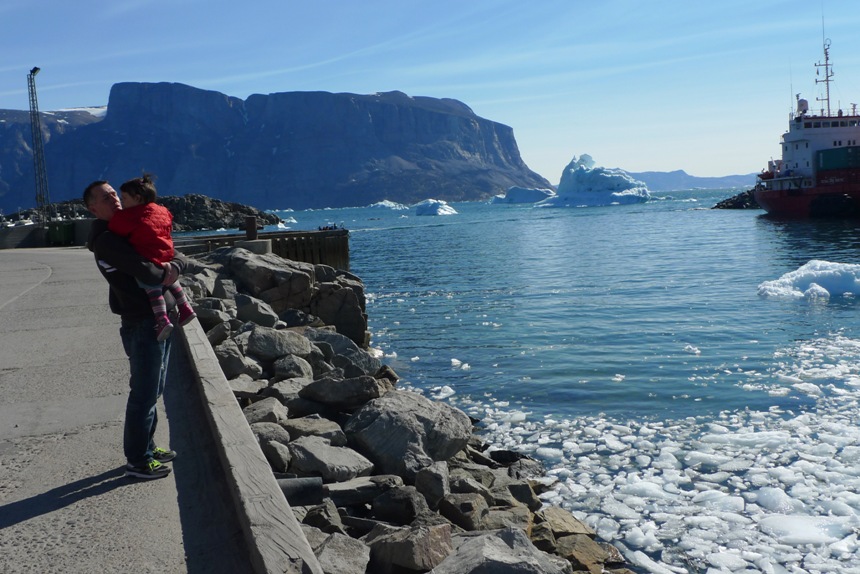
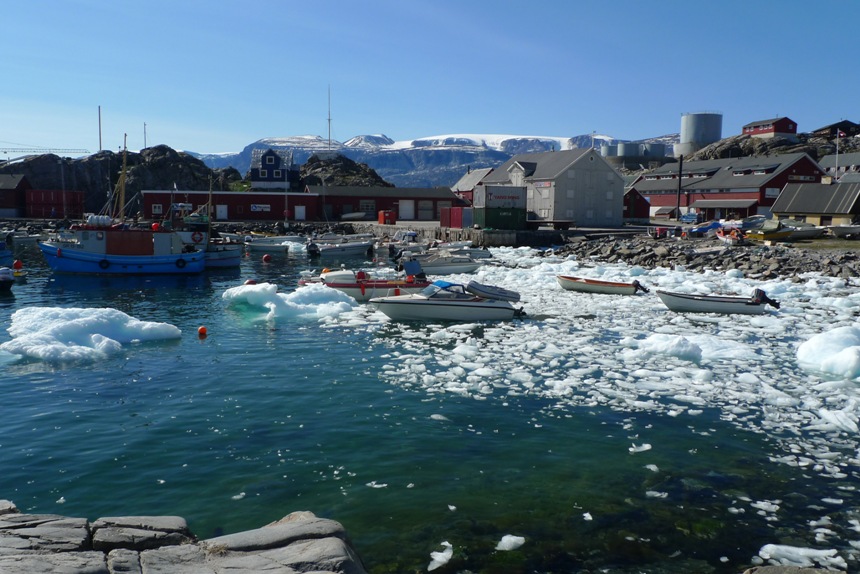
Uummannaq Harbour
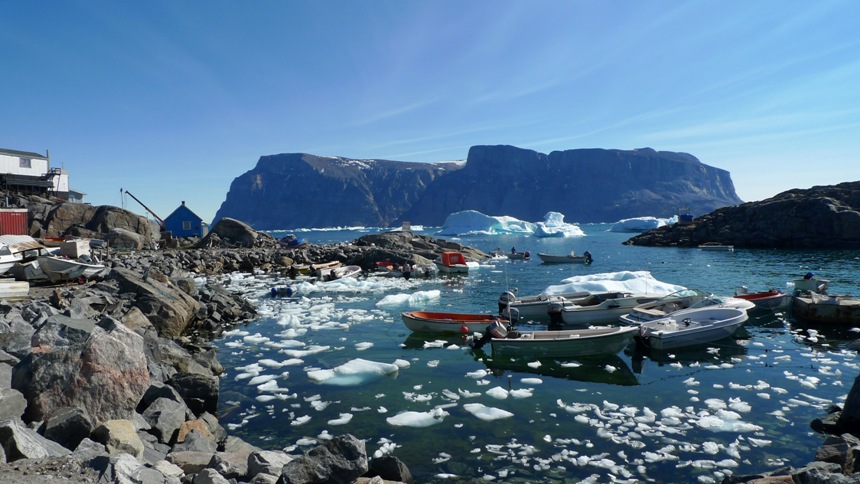
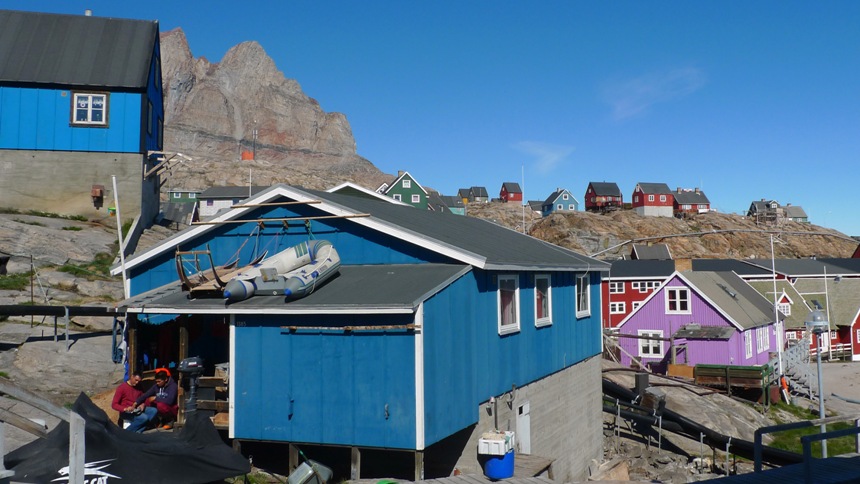

Storøen and Ikerasak from Uummannaq
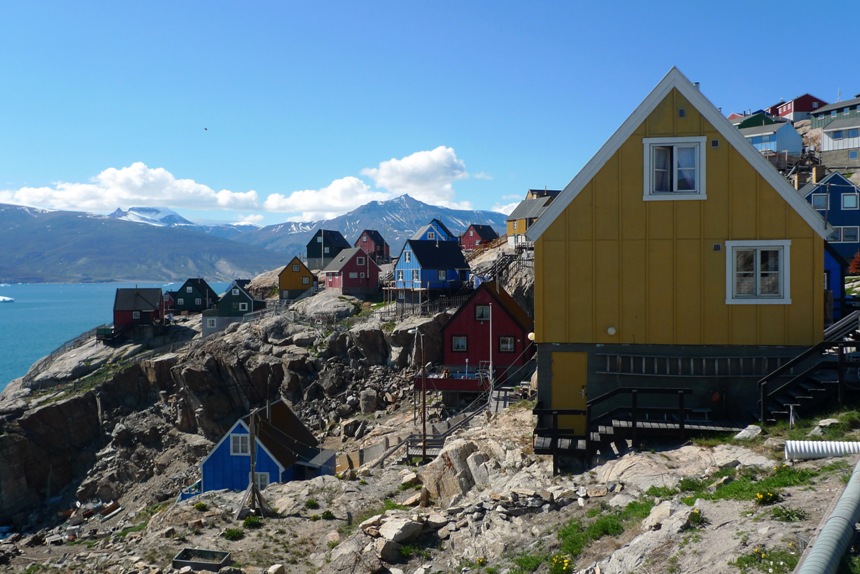
Uummannaq
5 July to 9 July 2013: Uummannaq to Glasgow
Our flights back were a nightmare and it took five days to get home. Uummannaq to Illulissat was cancelled due to fog in Illulissat. We were cruelly led to believe that since it was sunny and clear here we would have no problem. Air Greenland kindly provided us with local accommodation which consisted of a house owned and built by a local who hires them out for holiday accommodation. It was new with modern IKEA-type furnishings and modern kitchen. The toilet was typical Greenlandic, though – a nice bathroom but the toilet was stainless steel with a toilet seat and no flush. The “contents” of the steel toilet container would remain until emptied every few days. After each time “used” it’s polite to add a chemical similar to that used in caravan toilets to keep the smell down. Every few days the “poo truck” comes to each house to suck out the contents of each toilet into the truck.
Once in Illulissat, we had a scrumptious meal of redfish and potatoes at Hotel Icefjord even though we stayed at Hotel Avanna. Hotel Avanna received our e-mail cancelling the night we had previously reserved because of the delayed flight, but we had not gotten a confirmation for the new night, only an acknowledgement of the cancellation. I did wonder if we had a room for the night since no one was there at the airport to pick us up. We shared a taxi (pick-up truck) instead with a couple of French men who were staying at the neighbouring Hotel Arctic. When we arrived at Hotel Avanna, we realized the French guys had left all their camera equipment at the back of the pick-up. What a couple of knuckleheads! We did get one of the last rooms and four days later finally made it home.
It was a privilege to have kayaked in this magnificent area and to have been able to camp near the various abandoned settlements we came across and it added to the richness of the overall kayaking experience.
Greenlanders may be modern; however, it’s the folk tales, the stories of survival and hardship and ancestral traditions that capture the imagination. Something inside us wants them to retain their ancient culture and their traditional ways of hunting so we can somehow imagine their past and return to it, even for just a few moments, whether we are standing on a barren, rocky shore gazing over a glittering ice fjord or while in a small kayak gliding past enormous icebergs.
Goodbye, Greenland! We love you!
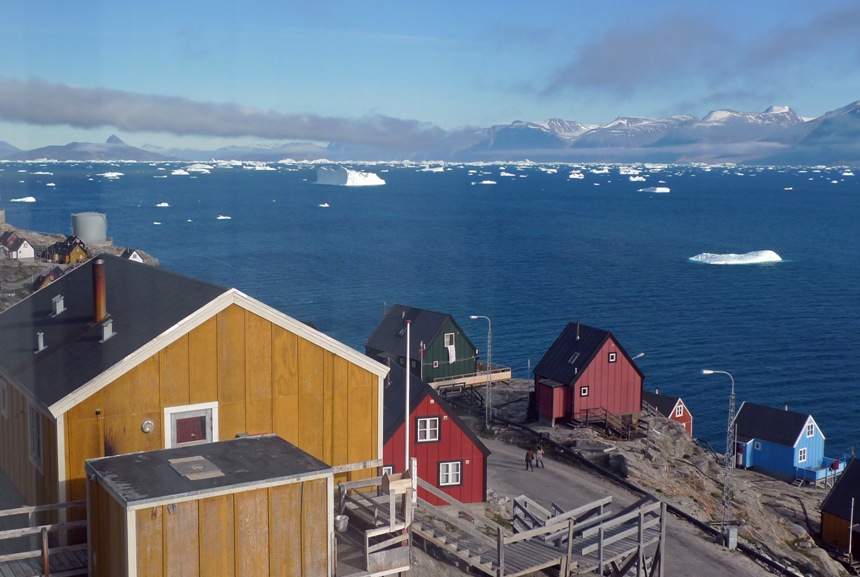
View from house window (Across Uummannaq towards Ikerasak)
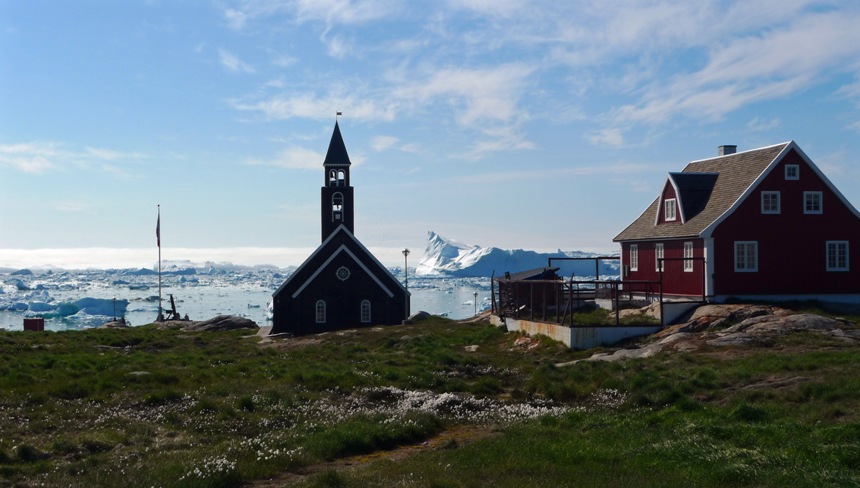
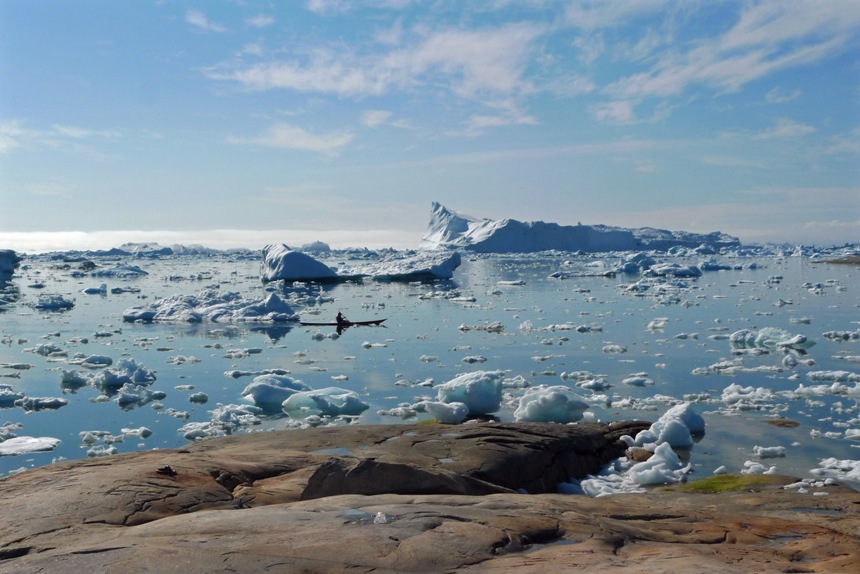
Ilulissat

14 Responses to “Uummannaq, Greenland 2013”
What a great account of your adventure!
We – four friends and me – were in the same area that you were in during about the same time. We were in Ilulisat on June 24 and 25, Uummannaq on June 27,28 and July 9 and 10. We paid a fishing boat to take us from Ummannaqu past Storen and north into Amitsuatsiaq where we camped, hiked and kayaked for 5 days; we then paddled to the narrow neck in the next inlet east of there Augpilagtoq and stayed there for 3 days; paddled across to Niaqqornakavsak for 2 days, and had a fishing boat pick us up there for the return to Ummannaq.
The wind was a factor in how long we stayed in Ummannaq, and at Amitsuatsiaq. The friend I was with has gear stored in Ummannaq which is what we used for kayaks and camping gear.
We found a dozen or more of the burial sites like you described (on Augpilagtoq ) as well as what looked like in ground burial sites. Have you learned anything additional about these sites? We were told that they were pre-christian by friends in Ummannaqu, but they did not know the meaning of the words at that spot on the map.
I really enjoyed reading your account.
Thank you,
LikeLike
Thanks, Gary, for your kind comments. We have no information from anyone local concerning these abandoned settlements but I’ve read that if they were pre- Christian, they could have been inhabited as far back as 4000 years ago to as recent as the 1700’s when Christianity was introduced. The well-preserved Qilakitsoq mummies found by hunters in 1972 on the Nuussuaq peninsula across the fjord from Uummannaq date from around the 1400’s.
Sounds like you also had a great trip!
Debbie
LikeLike
I’ve been interested for some years in the Polar expeditions after visiting the “Fram”-museum in Oslo, in memory of Fridtjof Nansen expedition to reach the north Pole. Afterwards the reading the books of Peter Freuchen, Knud Rasmussen and Nansen himself, looking at the pictures in the books, mostly black and white, and some drawings, I didn’t realize how fantastic the landscape was. A friend of mine, Jan Solvig, worked as a doctor one summer in 1980-ties in Greenland and came back with a lot of his photos picturing icebergs. Too many icebergs for me then. What i didn’t understood was that the pictures is a portrait of the feeling of yourself and its memory of the situation you’re in. And then I saw your pictures here! Suddenly the the books and the stories, and the fascination for the landscape that these men formulates, is more understandingly for me. I’ve never been to Greenland, but reading what you’ve experienced and to been able to see the photos that you allow us to share, is a very great gift for me. Thank you very much for this.
Thomas Granath
Norrköping, Sweden
LikeLike
Hi Thomas,
The feelings of vulnerability while camping and kayaking in such a landscape enhances the senses enabling the colours, sounds and fear to become more vivid. On stormbound days, there’s time to think and your imagination wanders as the land comes alive with people of the past enduring hardship.
I’m so happy that you found it worthwhile reading. Thank you for your nice words.
Regards
Debbie
LikeLike
Oh. My. God. We are reading this with slack jaws! Can’t wait to re-re-read 🙂
LikeLike
Thank you.
LikeLike
A great account of your adventures in Greenland where my wife and I will be embarking on a hiking trip in the summer of 2017, admittedly a bit further south than you were but it’s fantastic to see so many photos and get a real ‘feel’ for the place.
LikeLike
Thanks for visiting our blog and the kind words. Are you doing the trail across the Nussuaq peninsula to the south of Uummannaq Fjord? I’m sure you will have a great time.
Stewart
LikeLike
Hi Stewart, nothing’s set in stone yet other than going to Greenland but we’re looking at this: http://www.topasadventuretravel.com/pages/Itinerary—From-Settlement-to-Wilderness.html. That’s all for next year though so we’ve got Russia and Central Europe coming up this year. I do like my travel!
Iain.
LikeLike
Hi Iain. Sorry for the delay in responding. That’s the same area we toured in 2012:
https://kelpscotland.com/2012/12/16/south-greenland-2012/
South Greenland is wonderful and much greener than further north. The Viking ruins scattered along the fjords help make this a very special place. Have a great trip.
Stewart
LikeLike
Thanks Stewart, we fully intend to make the most of it.
LikeLiked by 1 person
I’ve published for the second time, after reading it again and looking at the marvellous pictures, the link on my Facebook. There is a swedish kayak paddler, Svante Lysén, who also is an adventurer like you, and has some pictures that might interest you too. His home page is http://www.svantelysen.se. I’m very grateful to have the opportunity to travel comfortly in my chair at home with you, and see things that I’d never else been able to to do. To read your thoughts about experiences, and cultural histories, etc, is really a joy in life!
LikeLike
Thanks again Thomas, that looks a very interesting website. We’ll need to spend some time exploring the content more fully. I need to make the time to publish our big trip from last year.
Stewart
LikeLike
It is so enormous good image in Uuummannaq fjord and your trip with Kayak
In the future I would like to kayak trip from Uummannaq to Ilulissat
LikeLike